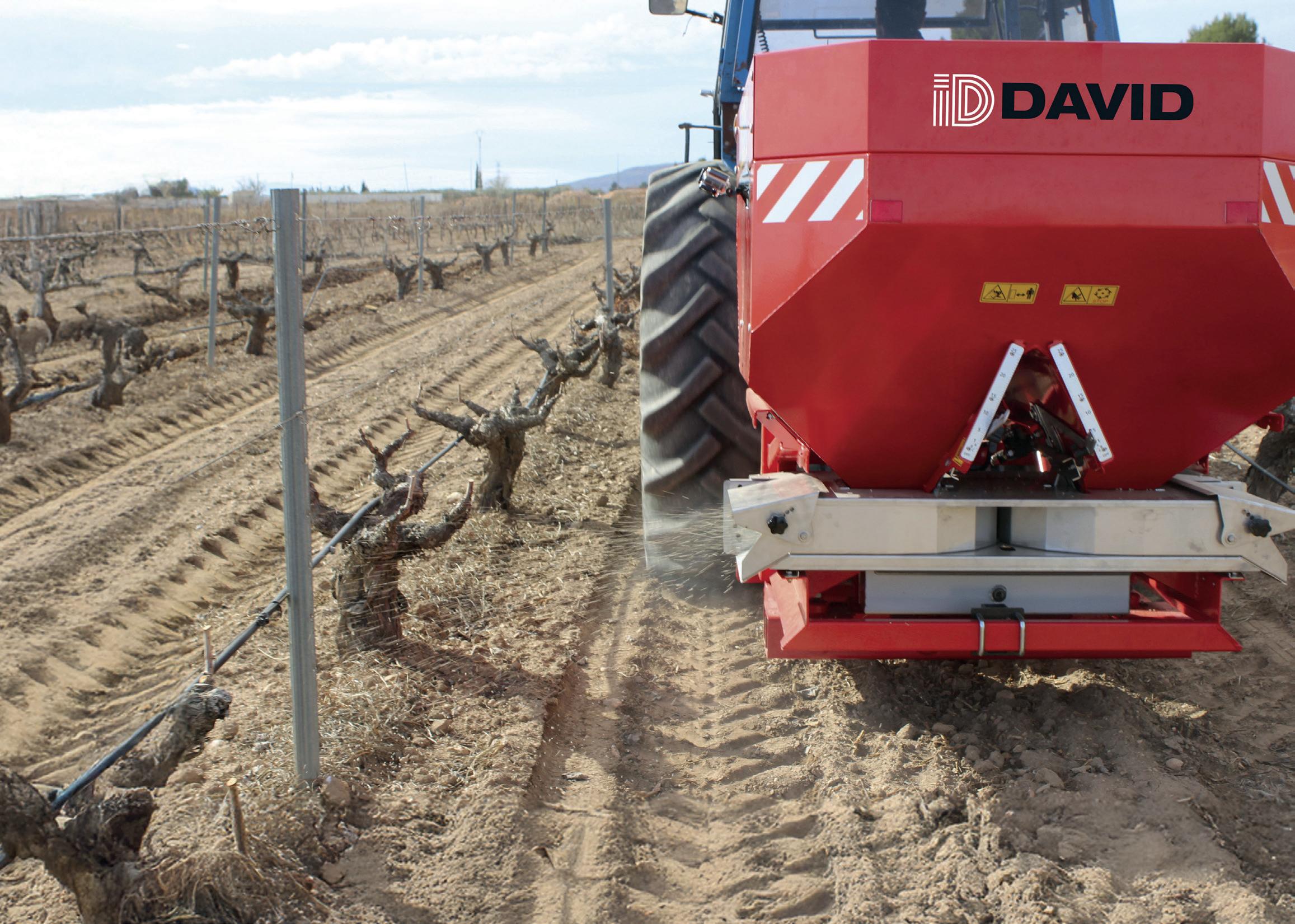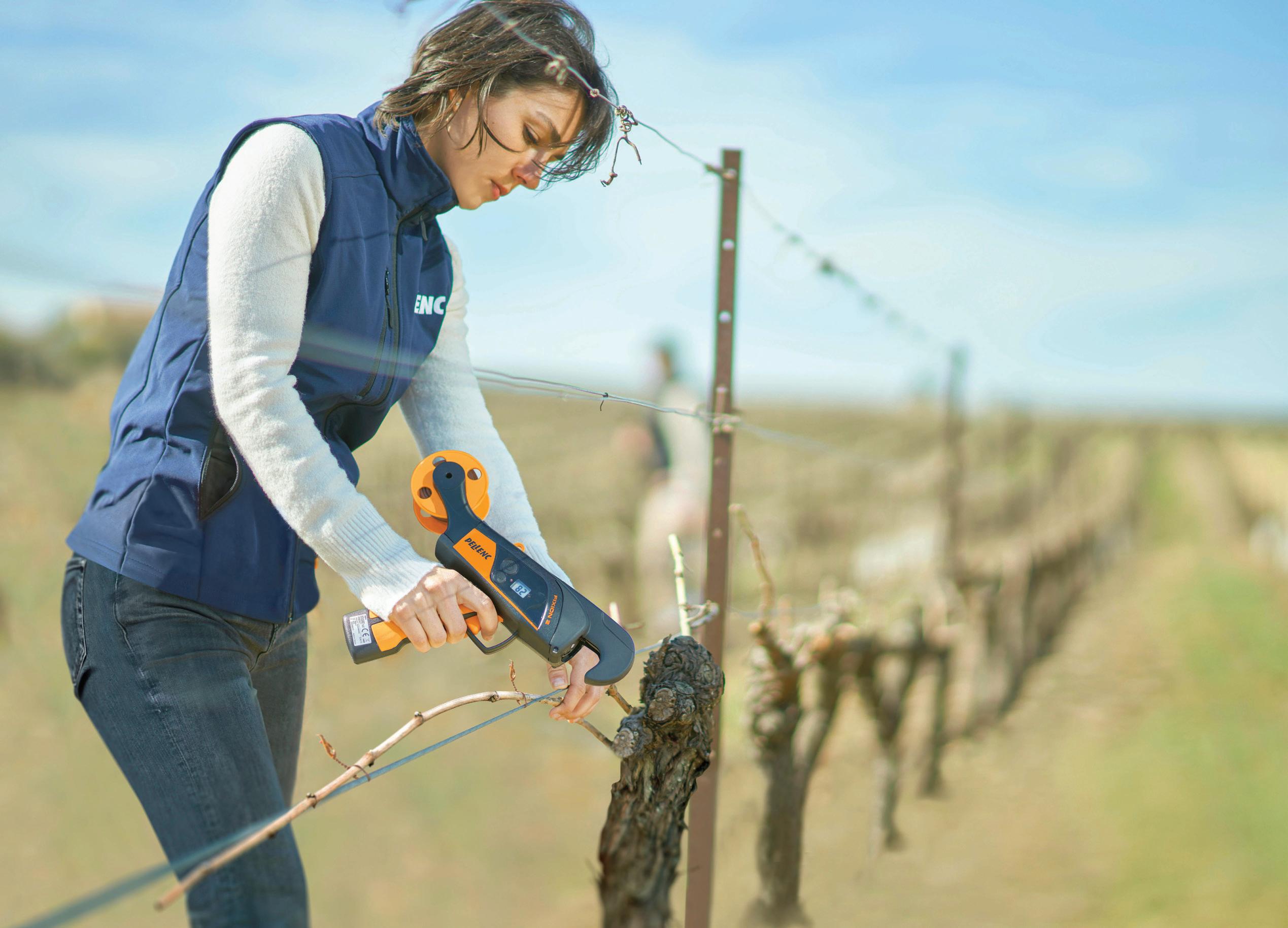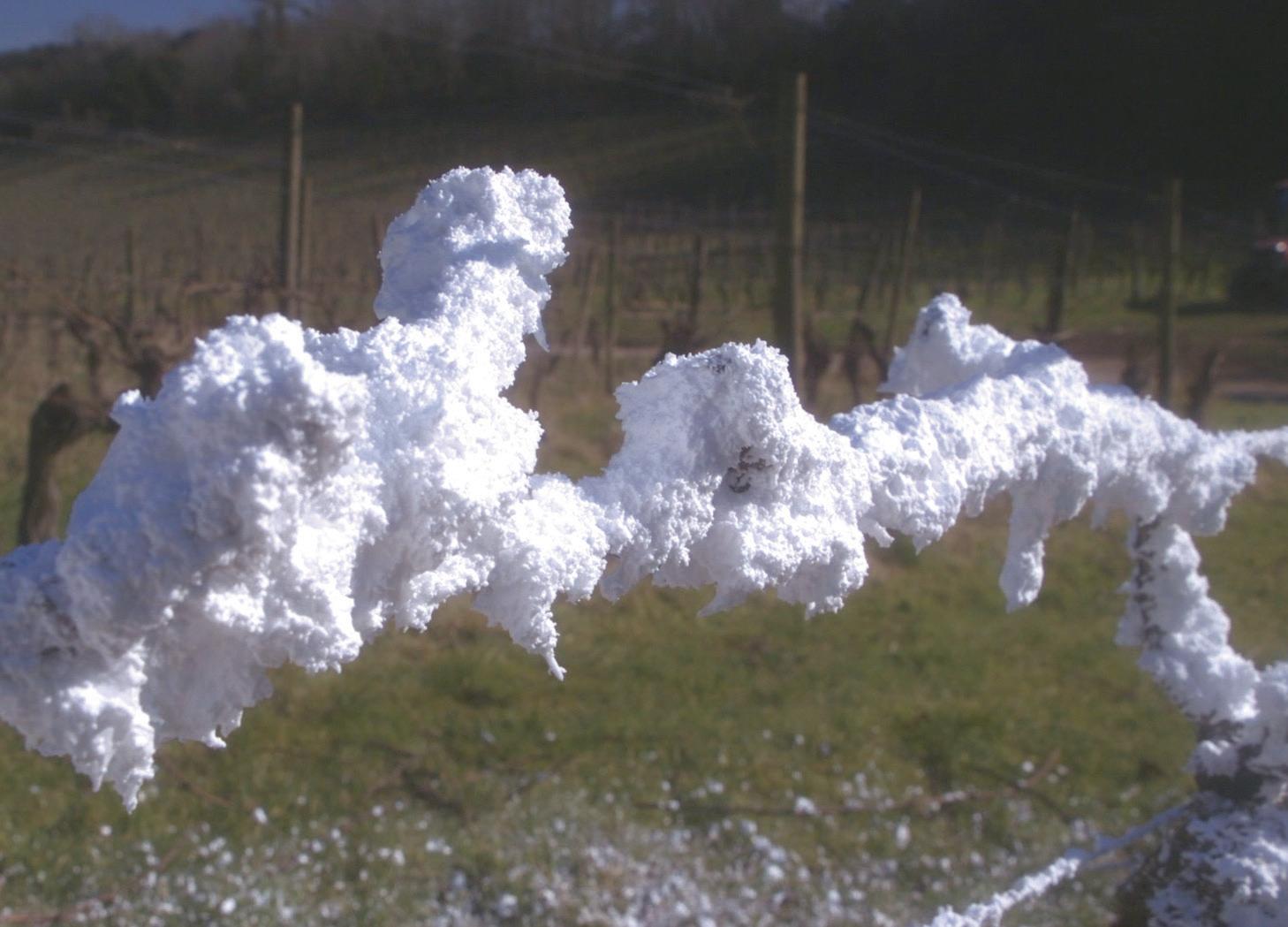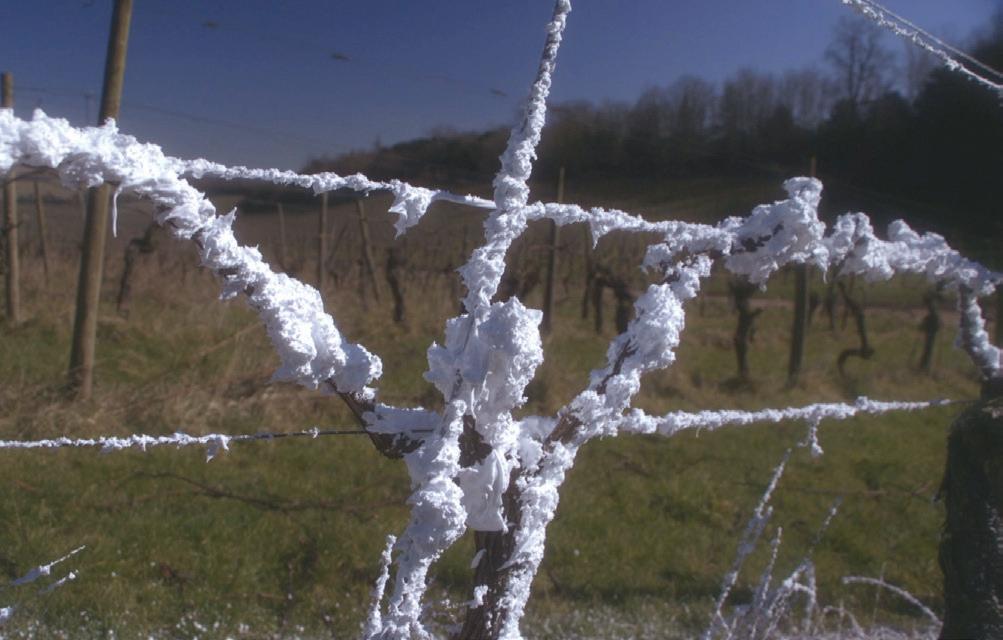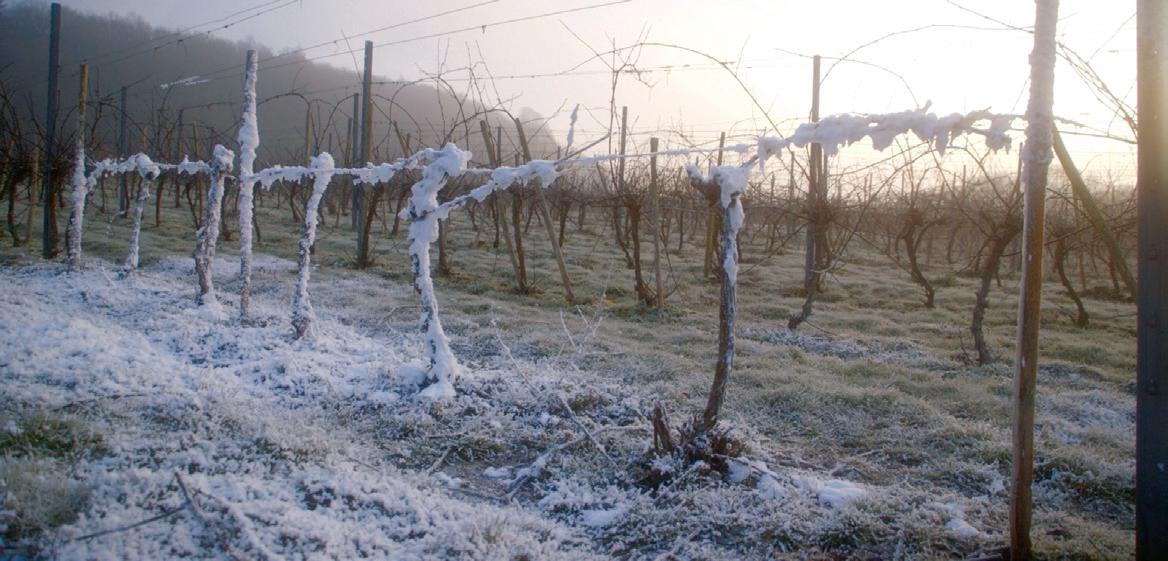




Bluestone Vineyard is a place where you can find thousands of years of history
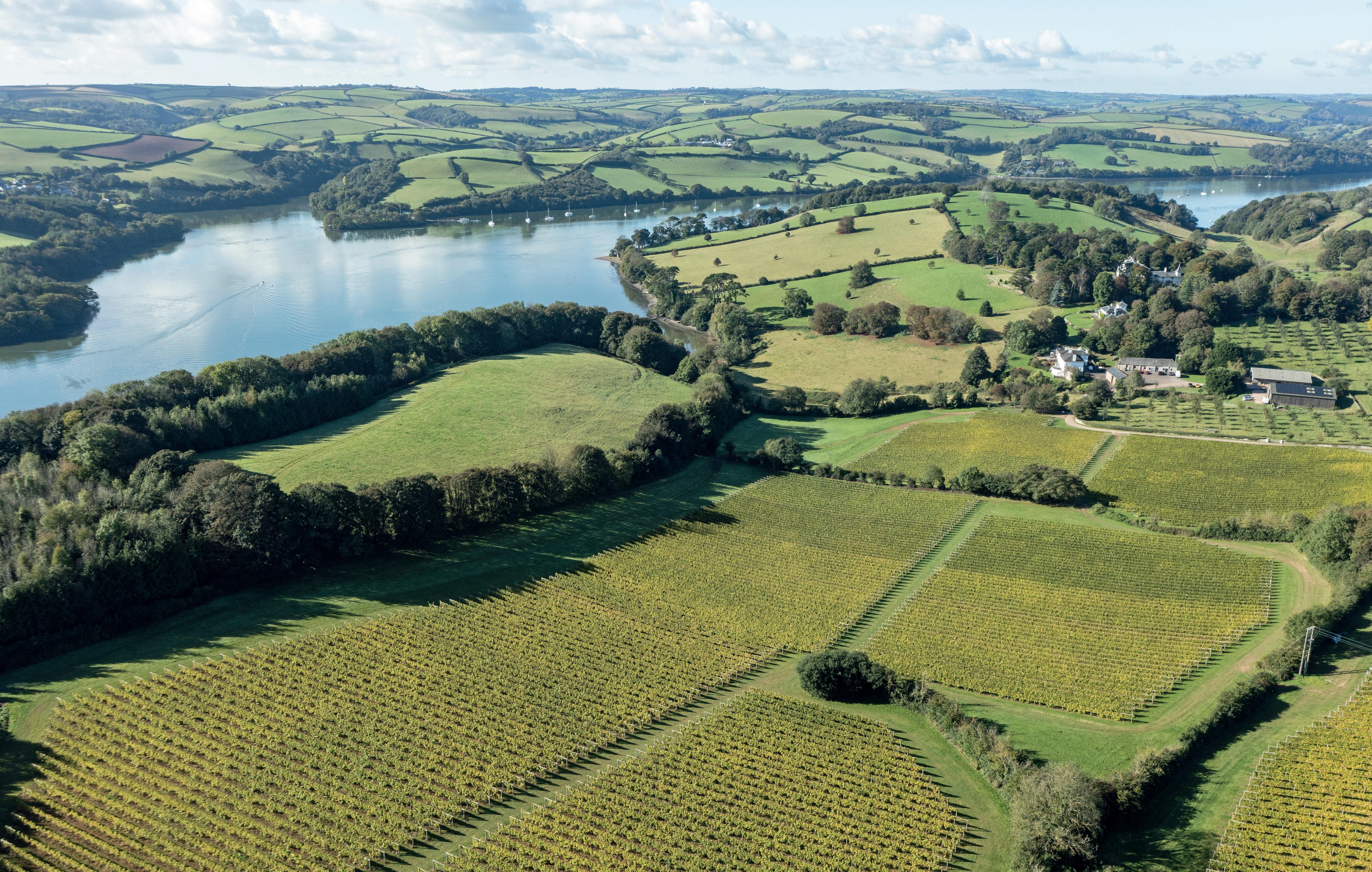



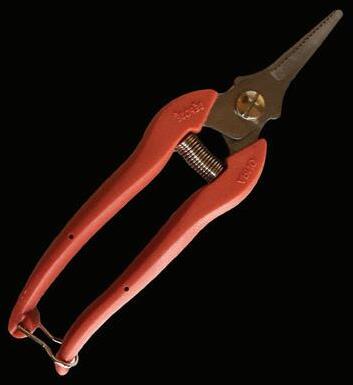

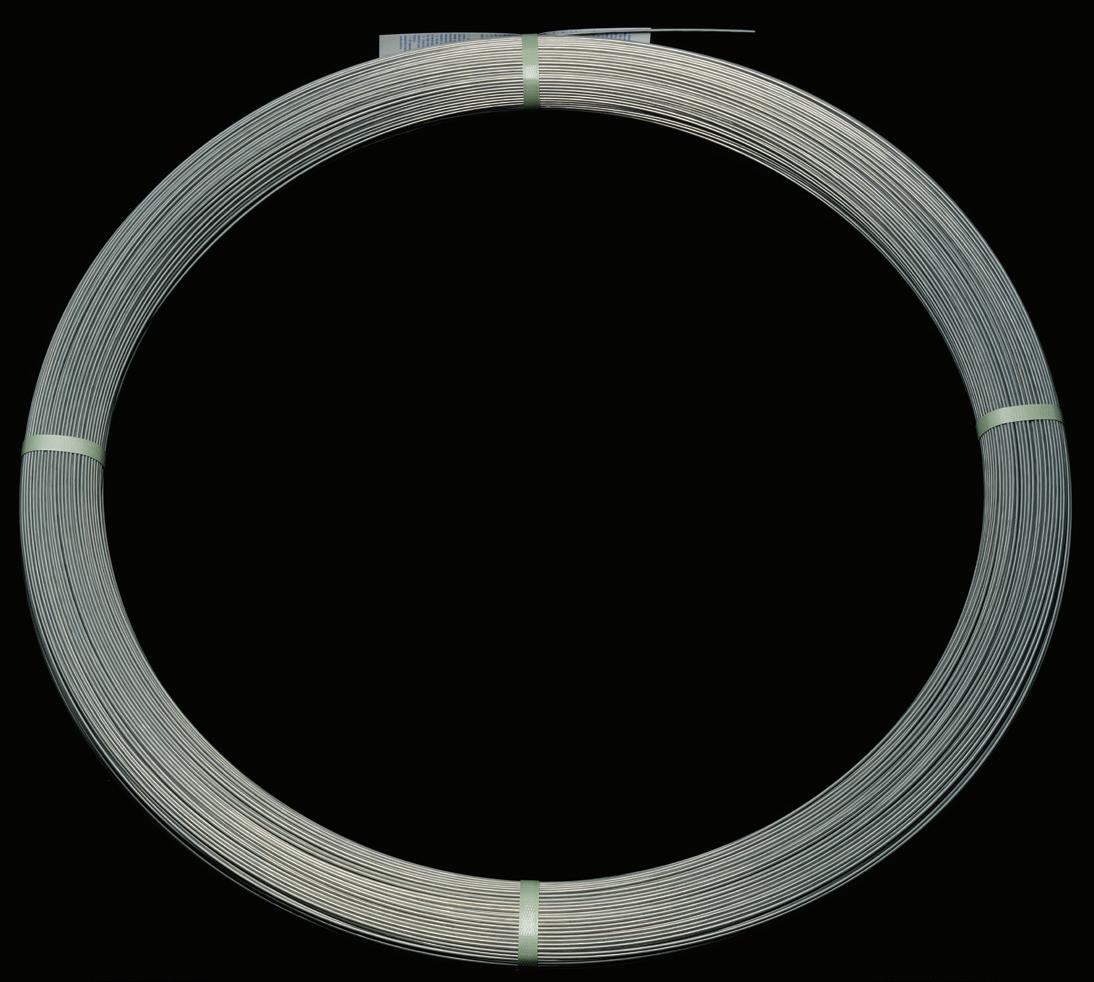


Two Companies. One Mission.
Delivering a complete suite of services for all your vineyard needs.
Whether you’re starting your vineyard journey or looking to enhance your production, Croxford Wine Estates and Nene Valley Winery offer a seamless partnership to meet all your vineyard needs. Together, we provide a full suite of services that guarantee success from vine to wine.
Vineyard establishment
Vineyard management
Under-vine herbicide spraying / grass strimming
Machine harvesting
Winemaking, bottling, disgorging
Storage and distribution
info@croxfordwineestates.co.uk
info@nenevalleywinery.co.uk

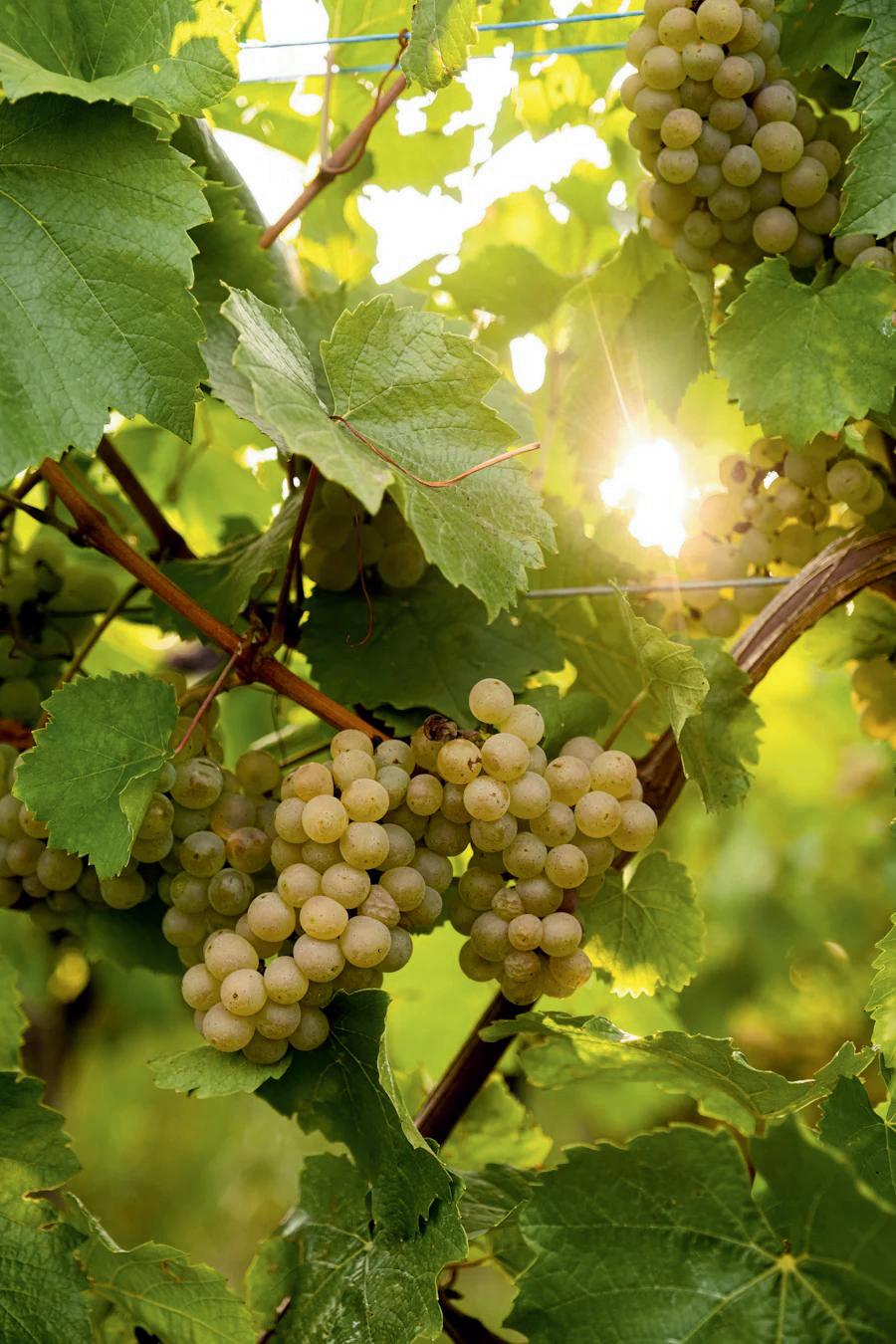

www.vineyardmagazine.co.uk
VINEYARD
Kelsey Media, The Granary, Downs Court Yalding Hill, Yalding, Maidstone, Kent, ME18 6AL 01959 541444
EDITORIAL
Editor: Rebecca Farmer vineyard.ed@kelsey.co.uk
Features: Malcolm Triggs
GRAPHIC DESIGN
Jo Legg Flair Creative Design jo.legg@flair-design.co.uk
ADVERTISING & MARKETING
Jamie McGrorty 01303 233883 jamie.mcgrorty@kelsey.co.uk
PHOTOGRAPHER
Martin Apps www.countrywidephotographic.co.uk
MANAGEMENT
DIVISIONAL MANAGING DIRECTOR: Steve Kendall
PUBLISHER: Jamie McGrorty
RETAIL DIRECTOR: Steve Brown
SUBSCRIPTION MARKETING MANAGER: Claire Aspinall
PRINT PRODUCTION MANAGER: Kelly Orriss
DISTRIBUTION
Distribution in Great Britain: Seymour Distribution Limited 2 East Poultry Avenue, London EC1A 9PT Tel: 020 7429 4000 www.seymour.co.uk
Distribution in Northern Ireland and the Republic of Ireland: Newspread Tel: +353 23 886 3850
Kelsey Media 2025 © all rights reserved. Kelsey Media is a trading name of Kelsey Publishing Ltd. Reproduction in whole or in part is forbidden except with permission in writing from the publishers. Note to contributors: articles submitted for consideration by the editor must be the original work of the author and not previously published. Where photographs are included, which are not the property of the contributor, permission to reproduce them must have been obtained from the owner of the copyright. The editor cannot guarantee a personal response to all letters and emails received. The views expressed in the magazine are not necessarily those of the Editor or the Publisher. Kelsey Publishing Ltd accepts no liability for products and services offered by third parties.
Kelsey Media takes your personal data very seriously. For more information on our privacy policy, please visit https://www.kelsey.co.uk/privacy-policy/
If at any point you have any queries regarding Kelsey’s data policy you can email our Data Protection Officer at dpo@kelsey.co.uk

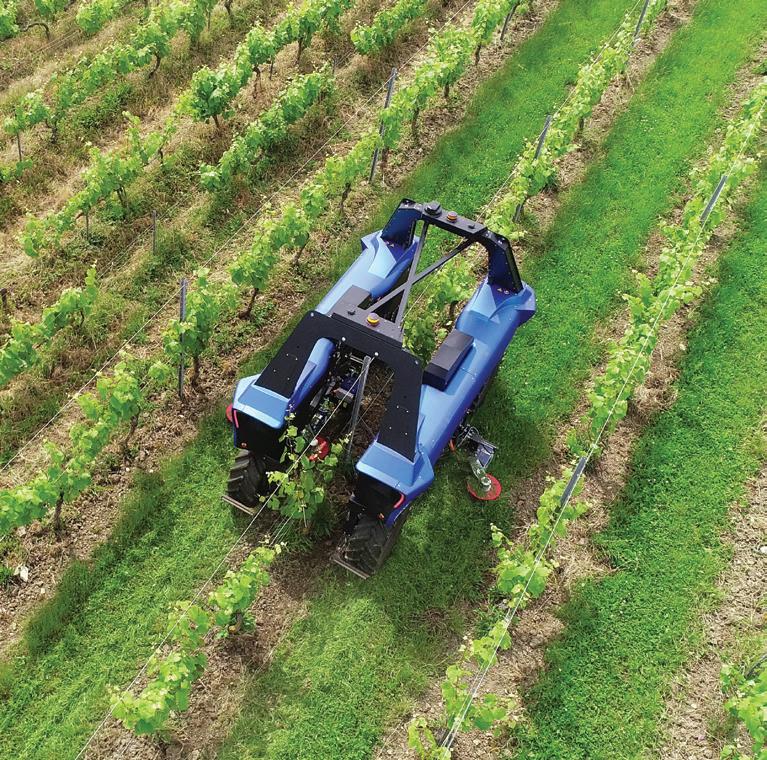

Held in London, the interest in Welsh wine was obvious from the steady stream of visitors.
It’s time for English Sparkling Wine to step out of Champagne’s shadow declares Richard Alleyne, journalist and communications consultant.
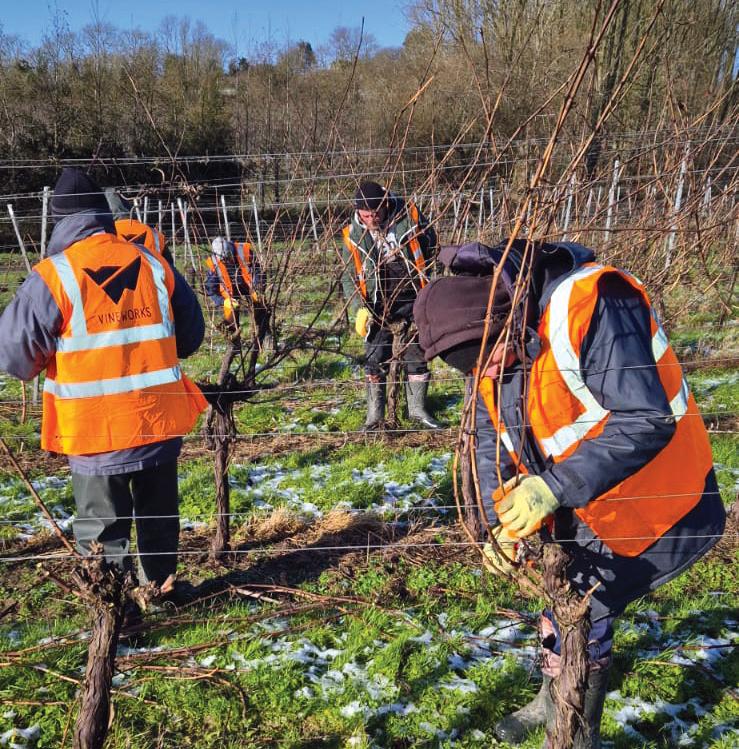


16

26
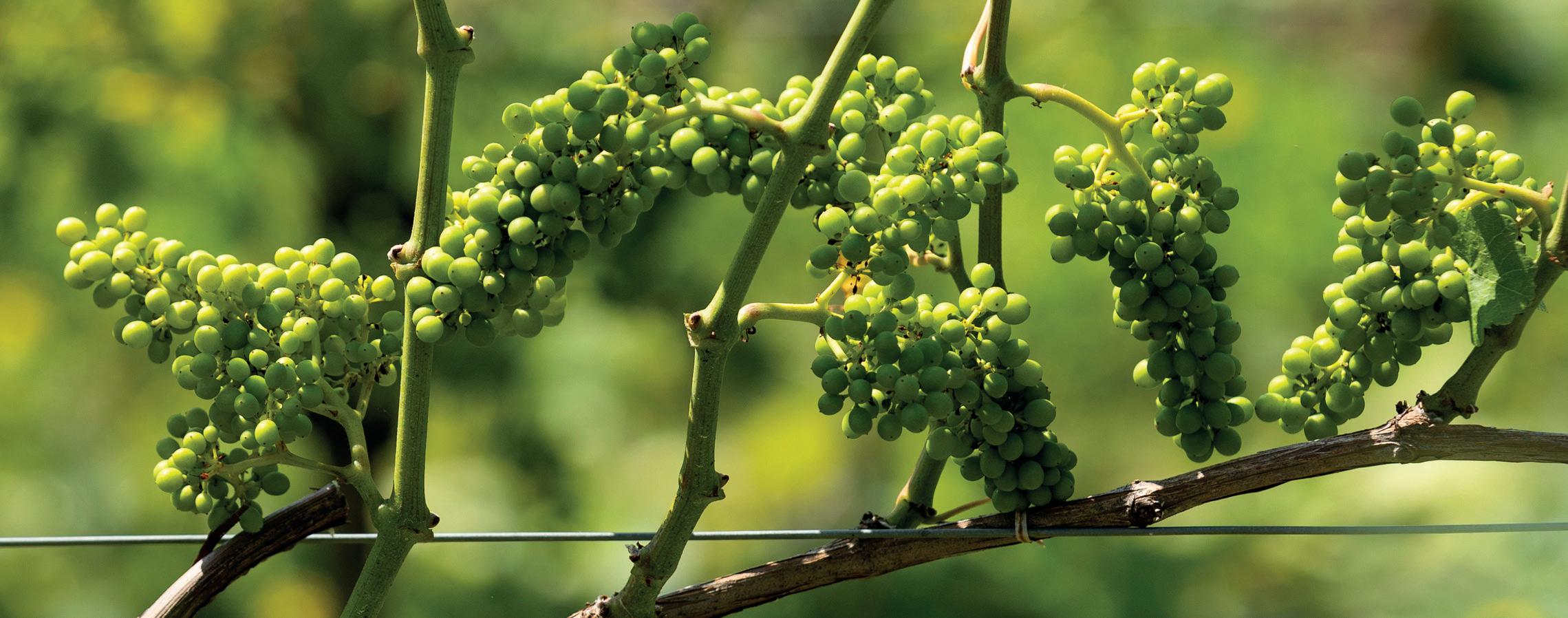
40

The annual competition is a great opportunity for viticulturists from the UK to get together to celebrate the art of pruning.
Bluestone Vineyard, situated near the city of Salisbury and the ancient monument of Stonehenge, literally has thousands of years of history under foot, or in this case under the vines.
Best of the bunch Grapes are at the heart of what we do and understanding them is at the heart of good wine-making. Vineyard magazine gets back to basics with an up close and personal look at the grape bunch.
50
Building relationships
Core Equipment, the UK’s leading supplier of winemaking equipment puts building relationships at the heart of everything it does.

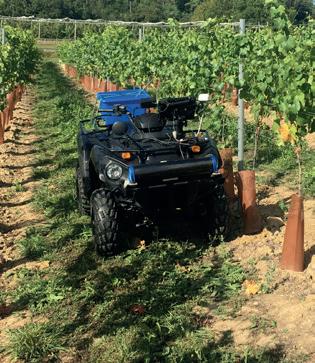
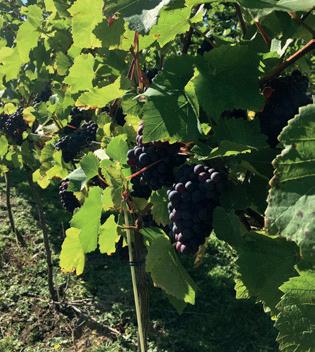


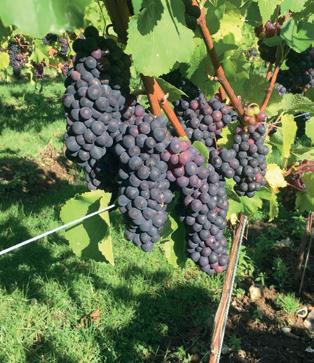
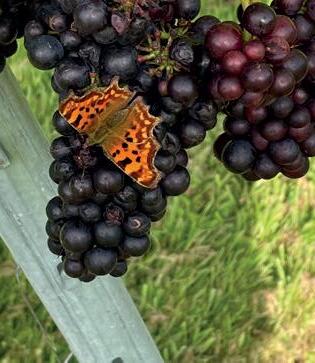
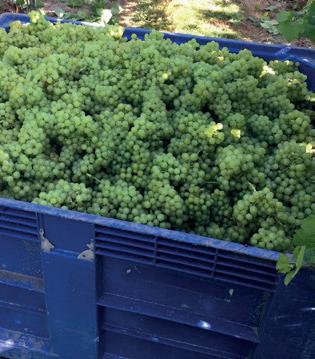
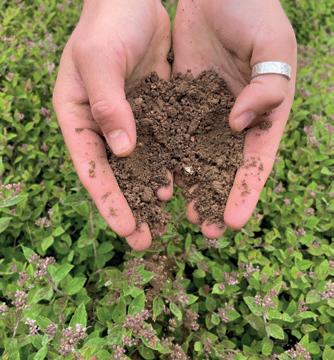

“It does not matter how slowly you go as long as you don’t stop”.
Confucius
The record time for completing a maximum snooker break of 147 is five minutes and eight seconds. The 2025 solo pruning competition winner Dragos Nitu, despite having no time limit, completed his task in five minutes and fifty seconds (page 16). For some, incredible tasks can be completed in what may seem like the blink of an eye but for most of us it takes a little longer to reach our goals.
This is where the quote at the top of the page comes to mind. There are many times when the goal will not be reached quite so quickly and what we learn as we travel the road is actually part of the process. This month a visit to Wiltshire (page 26) highlighted just what can be achieved when vines are allowed to progress at their own pace. Incorporating patience into a business model is not always quite so easy but the quote from Confucius reminds us that the end goal is not the only way to measure our success. It was also pointed out to me several times this month that it does not matter how skilled a person is with vines in general, it takes years to fully get to know an individual vineyard properly. The exact length of time was a subject of some debate but the minimum time limit given as a consensus was five years.
Patience can be something we appreciate in others but find difficult to practice ourselves. For me patience is something I try to apply every time someone tells me that English and Welsh wine is expensive in comparison to… (this month it was Chile). After taking a deep breath and trying to use an illustration that is relevant to the person I am talking to – for example the garment industry where a handmade suit will be a very different item to an off the peg version – I exercise patience as I explain both have their place but they have different price tags for a reason. Happily, I have to exercise this patience on far fewer occasions than five years ago and this is where Confucius has helped me. We are not able to get the message out in one swift record breaking whirlwind but we are making progress.
There are also times when we have to move patience aside and move forward with conviction as illustrated by an article this month (page 14) that looks to rally the English Sparkling Wine industry to action in pushing its way forward as a united global force.
The wise words at the top of the page are a good place to start but as all those who were at the pruning competition and experienced the atmosphere, the fun and the competitive spirit will understand they need also to be balanced by the equally wise words of Shakespeare “Boldness be my friend.”

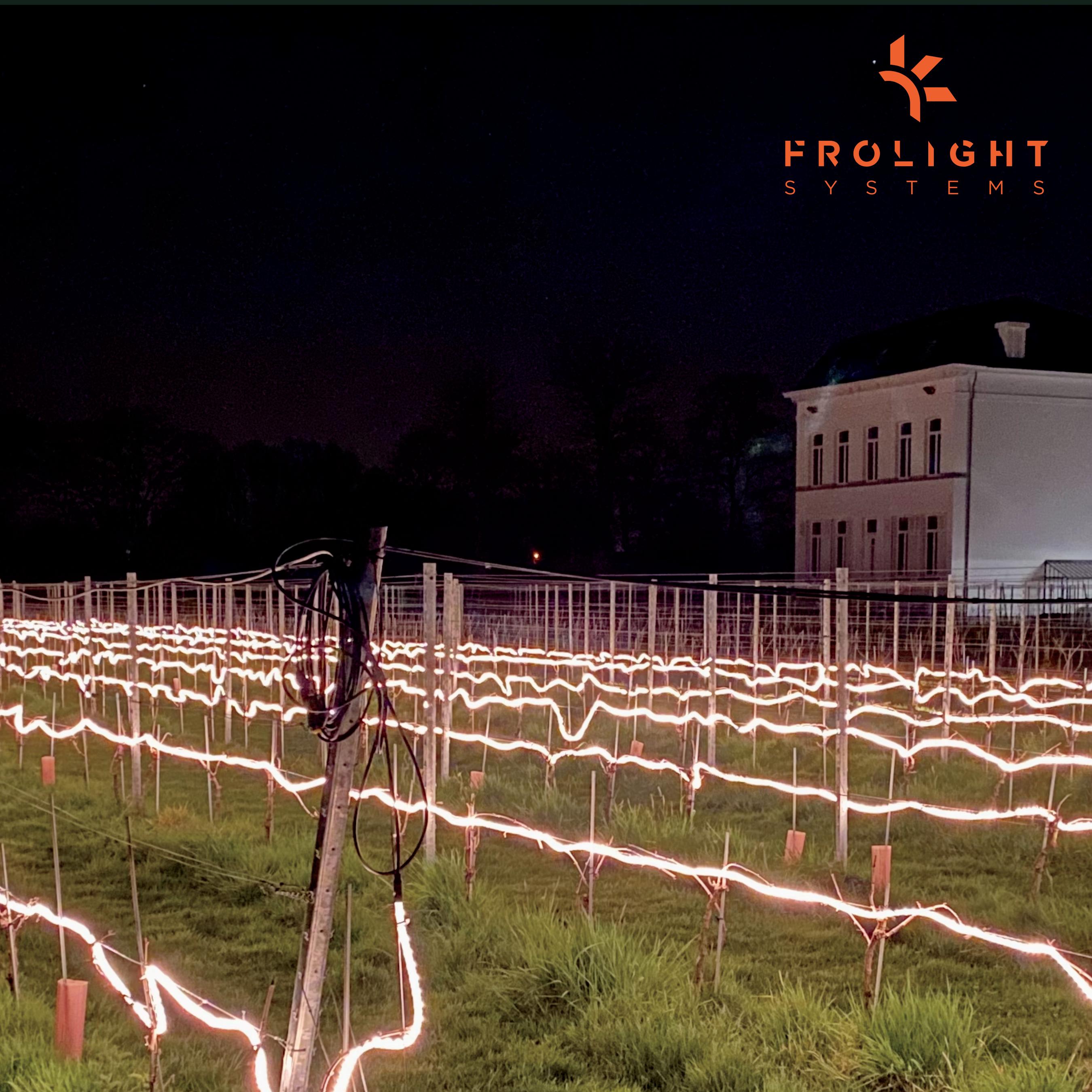
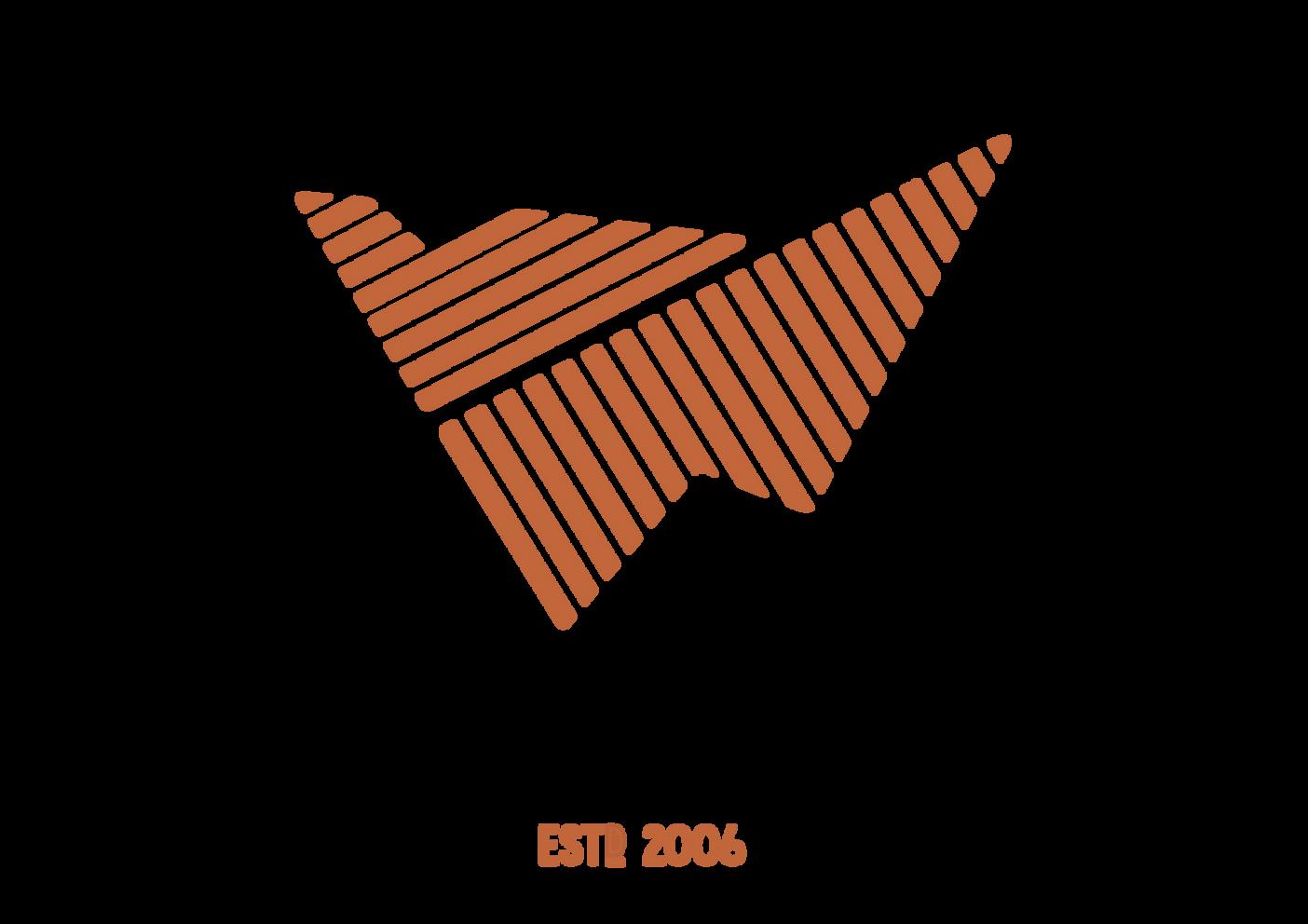




Vagabond Battersea has reopened to the public following an extensive refurbishment, with a new look, updated food menu, and space for 40 additional covers Vagabond, the wine bar business that boasts more than 100 wines for customers to explore and self-pour by the glass, has reopened

its Battersea bar after an extensive refurbishment. Located in the heart of Battersea Power Station’s vibrant food and drink scene, the beloved wine bar has been reimagined to offer an even more immersive and stylish experience for wine lovers.
The popular wine bar’s transformation brings a refreshed aesthetic with modern, inviting interiors designed to enhance the wine-tasting experience. Taking inspiration from its love of winemaking, the new look site features cosy corners for intimate dates, nestled within walls of wine, hanging vines, and tasting tables.

The new look bar pays homage to the Vagabond experience. Guests can continue to enjoy the venue’s signature self-pour wine machines, featuring an expertly curated selection of over 100 wines from around the world, alongside a reimagined food menu that perfectly complements each pour.
As part of the renovations, the Urban Winery has now been removed from the Battersea location and will relocate to a new site in London later this year. This has made space for more than 40 additional guests.

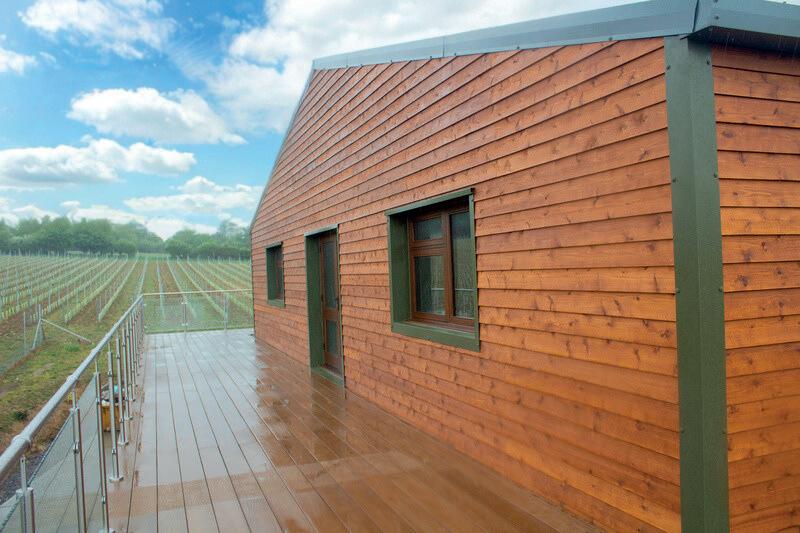
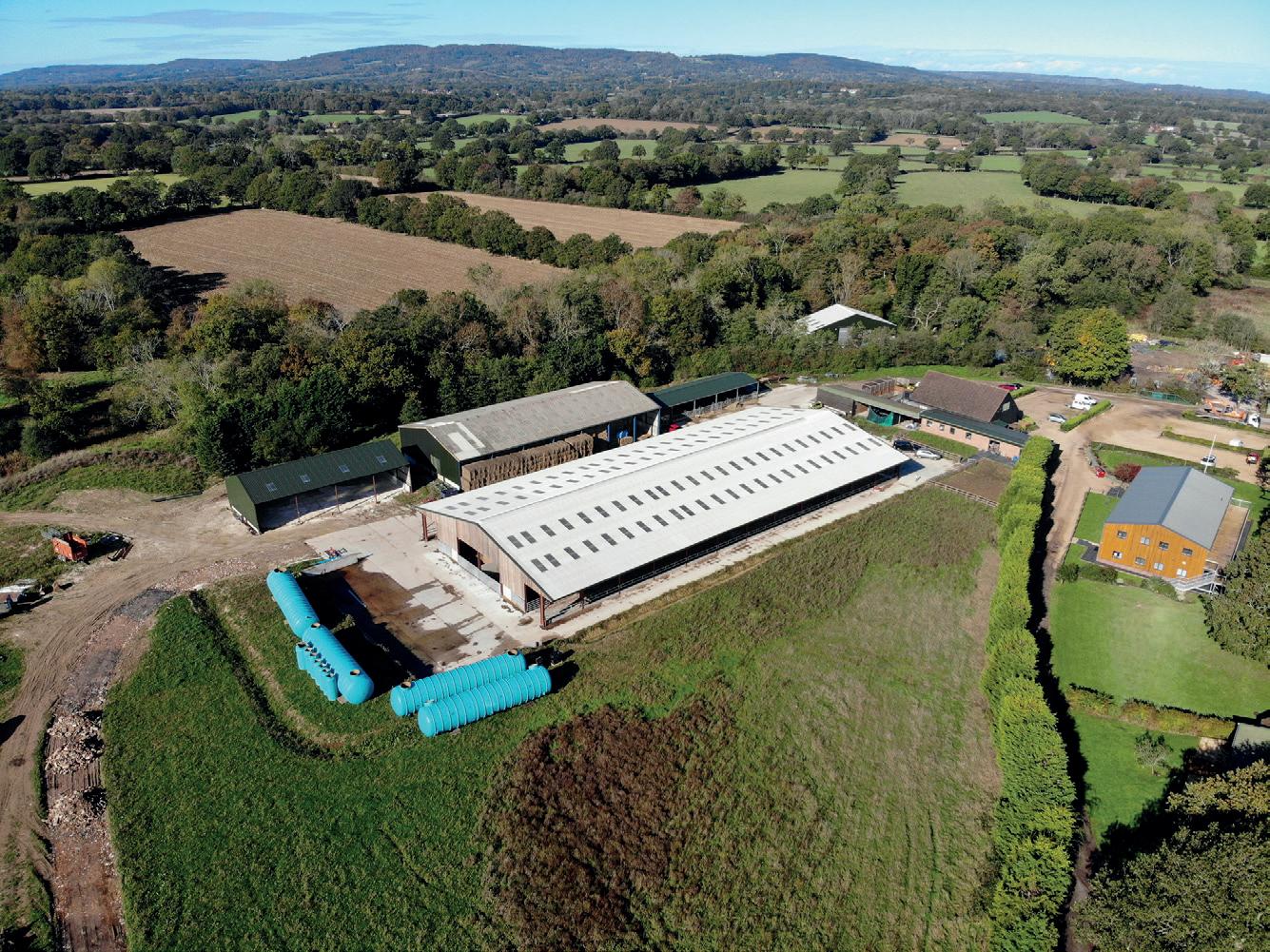
The relaunch also sees the introduction of new items on the menu, including a Spanish tortilla with seasonal vegetables, delicate Scottish mussels in Vagabond’s signature white wine sauce infused with garlic and fresh parsley cream, and an aubergine parmigiana, in a rich tomato sauce with fior di latte mozzarella. The menu also welcomes back some Vagabond favourites, including the cheese and charcuterie board – featuring items from award-winning duo The Cheese Geek and Cobble Lane Cured – and the sharing-size hanger steak, served medium-rare with crispy sweet potatoes, roasted shallots, and fresh greens. Perfect for sharing, guests will also find their popular Swiss cheese fondue, which includes a blend of cheeses, served with toasted baguette, potatoes, and pickles.
The significant investment in its Battersea Power Station site forms a key part of Vagabond’s growth plans under new owner Majestic. The UK’s largest specialist wine retailer acquired Vagabond out of administration in April 2024, securing the futures of nine wine bars and 171 jobs. Majestic plans to invest in the long-term future of the Vagabond business, including opening new wine bars and growing the brand’s customer base.
Liberal Democrat MP Alex Brewer recently visited the renowned Penn Croft Vineyard and Cellar Door for an exclusive tour and wine-tasting experience.
During the tour, Ms. Brewer explored the vineyard’s picturesque grounds, learning about Penn Croft’s innovative viticulture practices, where she was highly impressed with Penn Croft’s sustainability and regenerative focus. Izzy Harrison-Butler, Tour Manager and Manager of the Cellar Door, guided the group through the winemaking process, with owner Malcom Walker offering insights into the care and craftsmanship that go into each bottle.
The visit concluded at the Cellar Door, where the team enjoyed a wine tasting featuring some of Penn Croft’s finest offerings. The selection, curated to highlight the vineyard’s unique terroir, was paired with a charcuterie board featuring locally sourced delicacies. Ms. Brewer especially admired how the Cellar Door employs local students and that the majority of its food and drink are sourced locally, praising Penn Croft as an excellent example of local enterprise.
Speaking about the visit, Commercial Director John Wilkins said, “We’re thrilled to have welcomed Alex Brewer and her team to Penn Croft. It’s always an honour to showcase the hard work and passion behind our wines, and we’re grateful for their interest in supporting local businesses like ours.”
Commenting on her experience, Ms. Brewer said: “I thoroughly enjoyed my visit to Penn Croft Vineyard, it’s a fantastic local business, whose innovative and sustainable approach to winemaking embodies what I love about North East Hampshire.”
“I strongly respect Penn Croft’s dedication to crafting exceptional English wines and its commitment to sustainability. They represent our local area very well, combining two of our defining traits: passion for the environment, and high-quality craft.”
Penn Croft Vineyard continues to be a shining example of Hampshire’s growing reputation in the world of English wine, supporting local businesses and providing employment to local people. With its innovative approach to winemaking and commitment to community values, the vineyard is not only producing award-winning wines but also strengthening connections with the local area and beyond.
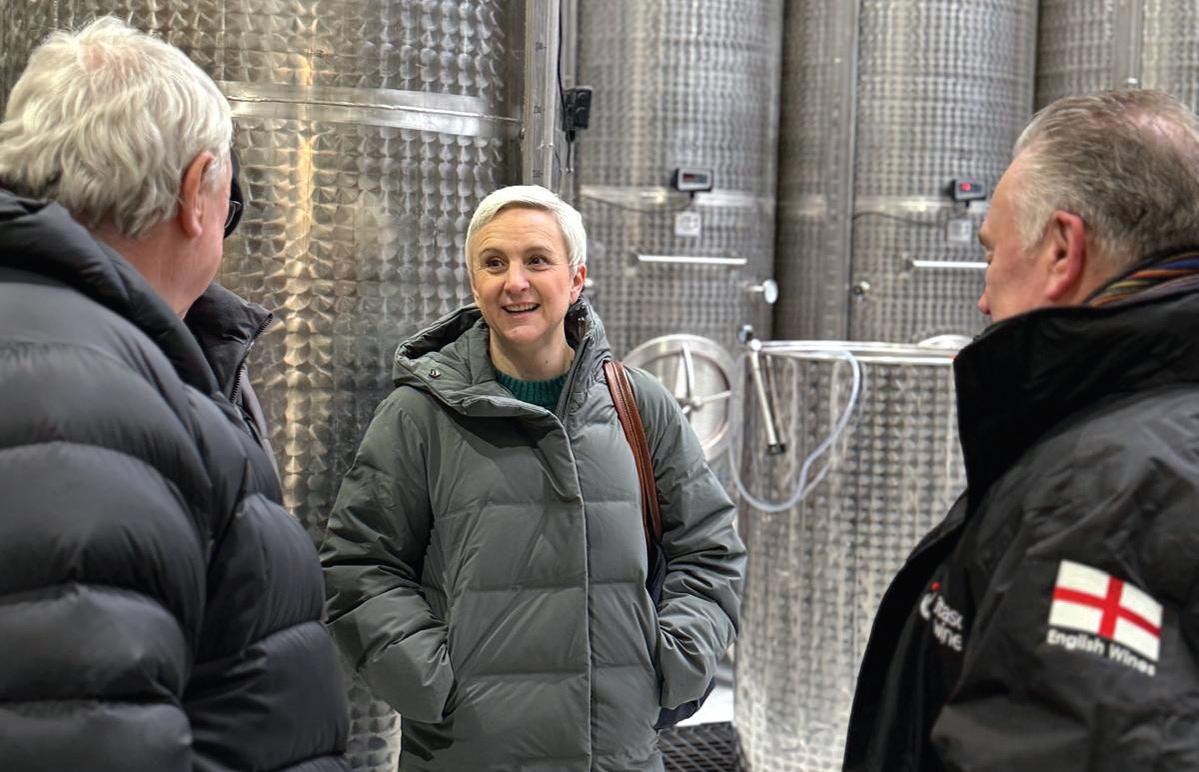




Lyme Bay Winery is delighted to announce its partnership as the official English Wine Partner of the Bristol Film Festival and its Summer Season 2025. This collaboration marks an exciting fusion of cinematic experiences with exceptional English wines, promising to elevate the cultural scene in Bristol.
The Bristol Film Festival is renowned for curating immersive film events that engage audiences in unique and captivating ways. As the newest partner, Lyme Bay Winery looks forward to enhancing these experiences by introducing Bristolians to their exquisite range of English wines and meads crafted with passion and expertise at their Devon-based winery.
Lyme Bay Winery is an award-winning producer of premium English still and sparkling wines, based in Devon. Sourcing grapes for their English Wines from select growers across the country.
Steven Sturgeon, Head of Sales and Marketing at Lyme Bay Winery, expressed his enthusiasm for the partnership, stating, "We are thrilled to be the official English Wine Partner of the Bristol Film Festival and Clifton Summer Screenings 2025. We have always sought to
build relationships with partners who share our own values, and this collaboration presents a fantastic opportunity for people to enjoy great cinematic experiences paired with wines which feels like a perfect match. We are excited to come and share our distinctive English wines with the vibrant and discerning community of Bristol."
Owen Franklin, founder and director of Bristol Film Festival, also shared his excitement about the partnership, remarking: "We are delighted to welcome Lyme Bay Winery as our official English Wine Partner. This collaboration brings together two worlds of creativity –film and wine – to offer our audience a truly unique and memorable experience, which we know that they will enjoy. We look forward to celebrating the magic of cinema with the exquisite taste of Lyme Bay Winery this year."
Bristol, known for its creative spirit and independent food and wine scene, provides Lyme Bay Winery with the perfect backdrop for this dynamic fusion of film and wine.
Lyme Bay Wines and Meads will be served at a range of events throughout the year.

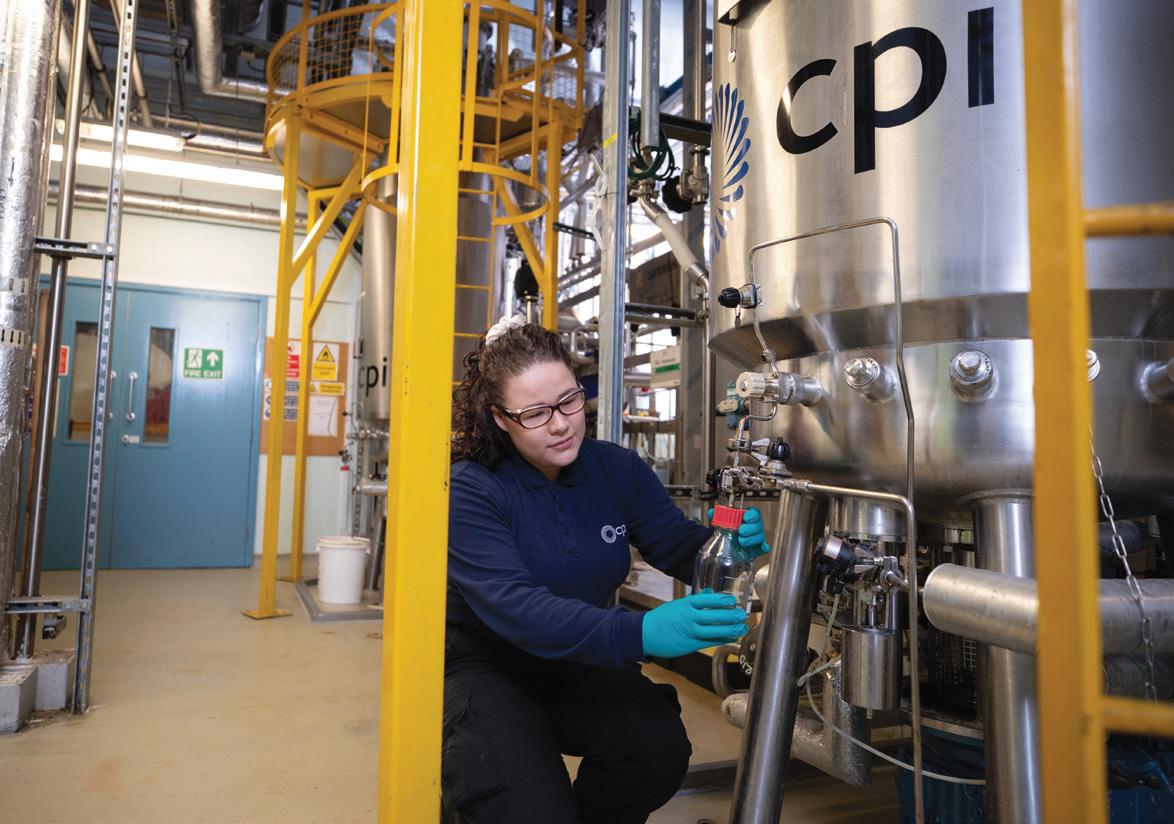
An innovative project which aims to provide UK farmers and growers with a sustainable, environmentally friendly nutrient management solution is underway following a partnership between industry experts.
The project, called ‘Biofilm Biofertiliser’, will develop a novel multispecies biofilm-based biofertiliser product that reduces the use of synthetic fertilisers by 40%-50%.
By utilising a unique consortium of UK indigenous biofilm-forming plant growth-promoting bacteria (PGPB), which is tailored to UK soils, it will improve soil quality and plant/crop health, resulting in 20-30% higher yields.
Formulation types include water-dispersible granules (WDG) and encapsulated options, which aims to improve nutrient availability, enhance soil health and foster a stable biofilm with a targeted minimum shelf life of up to 24 months.
Following funding from the UK’s innovation agency, Innovate UK, the project is being led by a consortium of partners including lead partner, Bionema Group, a global leader in biocontrol technology development operating a Centre of Excellence and Technology Platform in biological formulation; CPI, responsible for the process development and production of samples for the UK field trials, and the UK Agri-Tech Centre, responsible for project management and dissemination/ exploitation ensuring awareness raising and end-user engagement.
As part of this project, three UK farmers and growers in agriculture and horticulture will be provided with a nutrient management solution which offers a low-cost alternative to synthetic fertilisers, improved soil and plant health, increased crop yields by 20%-30% and a reduced nutrient run-off.
Additionally, the innovative biofilm-based biofertiliser will be produced and manufactured in the UK, reducing reliance on imports from global suppliers.
Farmers and growers are facing the challenge of reducing synthetic fertiliser usage as required by law/regulations whilst increasing food production using more sustainable, organic farming methods to meet an ever-rising global demand.
Bionema’s technology will benefit farmers and growers by improving soil quality, plant health and yields, thus integrating seamlessly into existing farming practises and leading to more sustainable farming, greater resilience and higher profits.
Farmers and growers will also be contributing to lower GHG emissions, improved air quality and reduced environmental pollution from nitrogen run-offs.

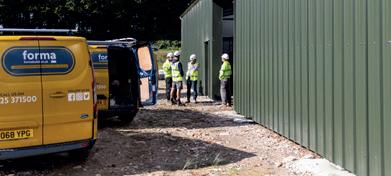
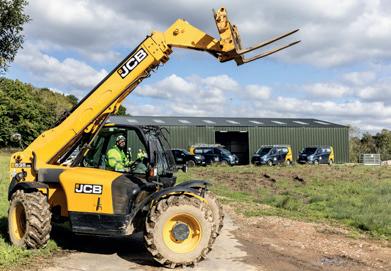

On 3 March 2025, editor Rebecca Farmer visited the fabulous venue of 67 Pall Mall which was host to the Welsh Wine Showcase event.
This was the second time the Welsh Wine Showcase event had been held in London and the interest in Welsh wine was obvious from the steady stream of visitors. The event was again able to showcase other welsh products and all visitors commented on the excellent array of Welsh cheeses that were available to sample on the day.
The venue was continually welcoming a full cross section of visitors from members of the press and trade buyers to winemakers and wine professionals. It was great to see so many truly engaging with the producers and really investigating the unique feel of each of the wines. Some visitors from Ireland had travelled to London specifically to explore the Welsh
wines on offer. Each visitor was provided with an informative booklet with a beautiful and witty foreword written by Welsh Wine Ambassador Oz Clarke.
With Wales boasting over 50 vineyards the event included established producers Ancre Hill Estates, Gwinllan Hebron Vineyard, Montgommery Vineyard, St Hilary Vineyard, The Dell Vineyard, Vale Vineyard – Gwinllan y Dyffryn, Velfrey Vineyard, Whinyard Rocks and White Castle Vineyard. It was encouraging to see representatives of newly planted vineyard Chilled & Tannin Vines who are waiting to release their first wines in the Autumn of 2025. Planted on the Thaw Estuary with a mix of Rondo and Cabernet Cortis this low intervention vineyard promises to produce light still reds
of the kind that the owners enjoy drinking. The event was able to highlight that not only were each of the Welsh vineyards truly unique but even with a single producer the diverse nature of the varieties planted offers something impressive, exciting and unique for everyone. Vale Vineyard – Gwinllan y Dyffryn, were at the event with The Wine GB Welsh Wine Awards Best Sparkling Wine Trophy awarded to the first white sparkling wine from this family vineyard in the Vale of Clwyd. Alongside the sparkling white and rosé there was a still red wine which is a rather special blend of Rondo, Caberet Noir and Divico from the 2022 harvest. Many visitors were able to experience these varieties for the first time and Gwen Davies of Vale Vineyard explained how this unique
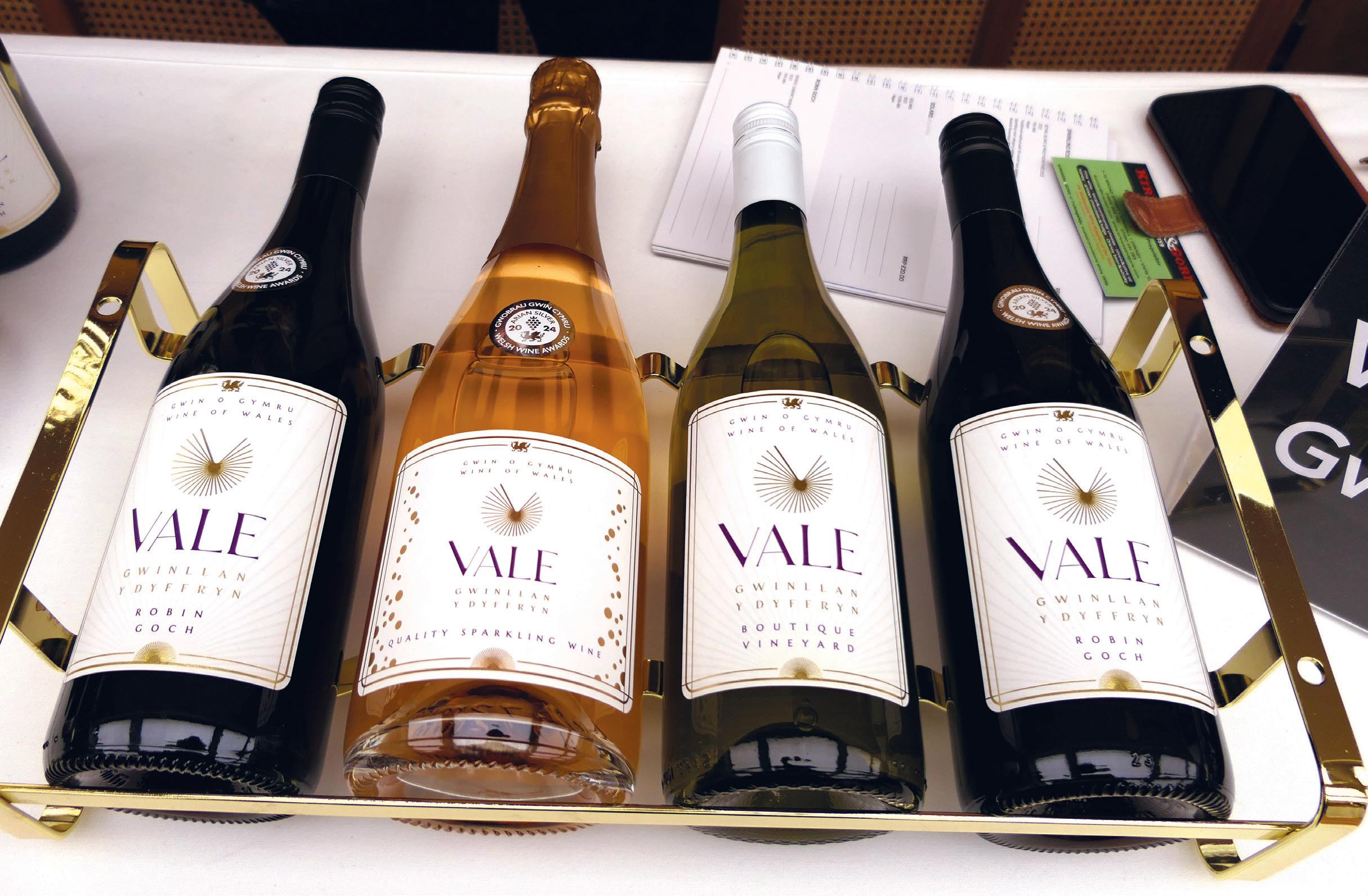

blend is able to bring fruit flavours to the fore in this still Welsh red.
Ancre Hill Estates were showcasing the variety of wines that they produce and Winemaker Jean Du Plessis was in constant conversation with visitors who had plenty of questions regarding the wines on display. Jean who worked in South Africa with specialist red blends of Cabernet Sauvignon and Syrah spoke about the nuanced and delicate purity of fruit flavours in cool climate wine making. Ancre Hill are well known for the biodynamic principles and the fruit led Pet Nat that they produce, but Ancre Hill also make Blanc de Blancs and Blanc de Noirs along with still chardonnay in years when the fruit is suited. This vineyard is really dedicated to letting the fruit take the lead in the winemaking process and the results are exceptional.
St Hilary Vineyard were able to showcase the first still wine produced from the 2023 harvest in the Vale of Glamorgan. The Pinot Noir and Pinot Meunier Blend wine was made by Mountain People Wines. The 2024 harvest was much smaller than the 2023 harvest at St Hilary Vineyard but Mountain People Wines went the extra mile to foot press the small harvest. This spirit of working together and going beyond the limits really underlined what the Welsh Wine Showcase Event was all about. There was an atmosphere that was both captivating and welcoming meaning these vineyards were able to showcase Welsh wine at its most diverse and at its very best.

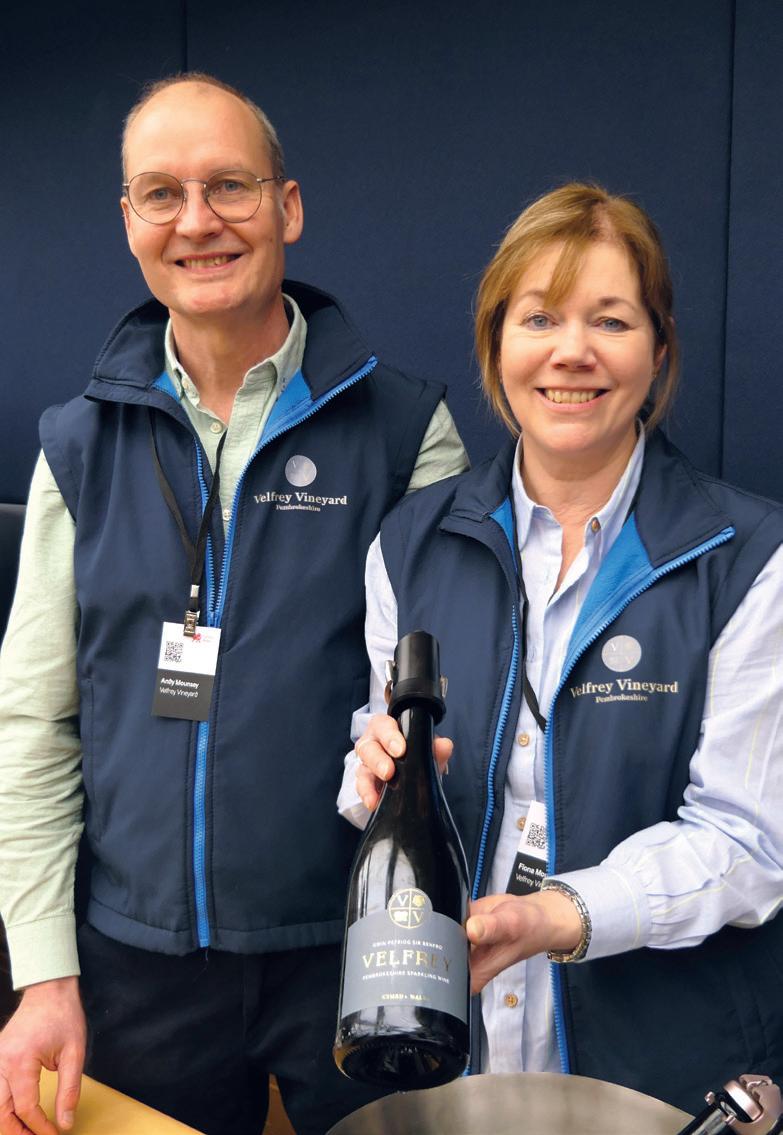




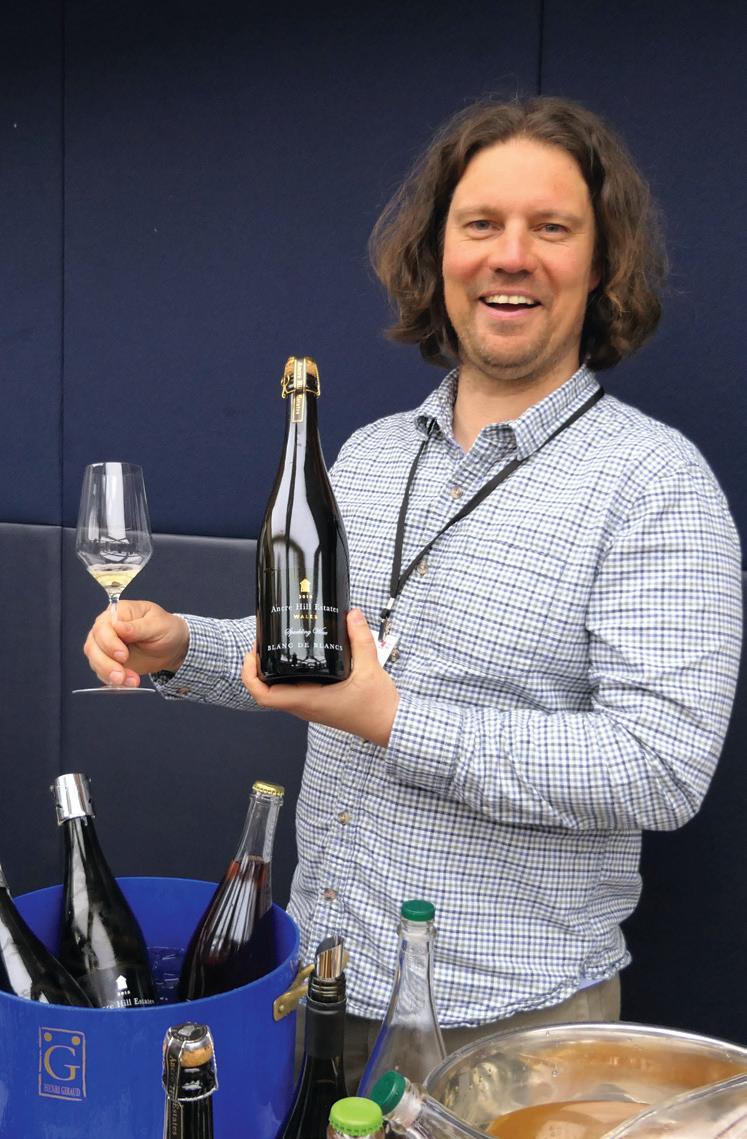
It’s

time for English Sparkling Wine to channel its Agincourt spirit and step out of Champagne’s shadow declares Richard Alleyne, journalist and communications consultant.
Last summer, I attended a 50th wedding anniversary in a Kent country garden – a successful East End entrepreneur and a stylish barrister celebrating half a century together.
The guests were warm, sophisticated and joyfully unbothered by conventions or formality.
Yet, amid this free-thinking revelry, one tradition held firm. The ice-filled wheelbarrow loaded with bottles from guests brimmed exclusively with Grand Marque Champagne.
And that to me sums up the problem for English Sparkling Wine (ESW). We know it is a world class product, but even in its heartland, it was shunned in favour of what Cherie Spriggs at Nyetimber describes as the ‘safer’ option: Champagne.
Champagne knows we are its biggest competition
My first brush with ESW came in 2006 when, as a journalist at The Daily Telegraph, I interviewed Eric Heerema just after he acquired Nyetimber. The paper headlined my article: Bollinger beware: here comes a Sussex sparkler. Bold claim? Maybe. But years later, while I was involved in the media training of a luxury goods conglomerate’s Champagne Ambassadors, it was asked what they saw as the greatest threat to their dominance. Without hesitation they replied: “English Sparkling Wine.”
Needless to say, this was something they never mentioned in public.
If Big Brand Champagne is scared, ESW must be doing something right. A decade on, having worked with English winemakers, I know for certain: through sheer grit, skill, imitation, climate change, and luck, ESW has climbed to Champagne’s level. And as the wine critic Matthew Jukes puts it: “”The only way is up, they’re just getting better and better.”
ESW isn’t a young pretender to Champagne – it’s the rightful heir
“No wine is promoted more pretentiously or mythologically than Champagne,” wrote Andrew Jefford, in the foreword to the excellent book by Robert Walters entitled Bursting Bubbles.
Big Brand Champagne pulled off one of history’s greatest marketing coups: persuading the world that a mass-produced, highly processed product is still a handcrafted luxury.
The reality? Their narrative is as outdated as Dom Pérignon’s supposed invention of bubbles. Meanwhile, ESW is far closer to what Champagne used to be and still pretends to be. The vast majority of our wines are still made by grower-producers. Our smaller producers literally make their wines by hand. And to me, this loving attention comes across in the taste.
We’ve got the climate, the soil, and the expertise. It’s time to stop doffing our caps to our continental cousins, instil some Agincourt spirit, and start rewriting the script.
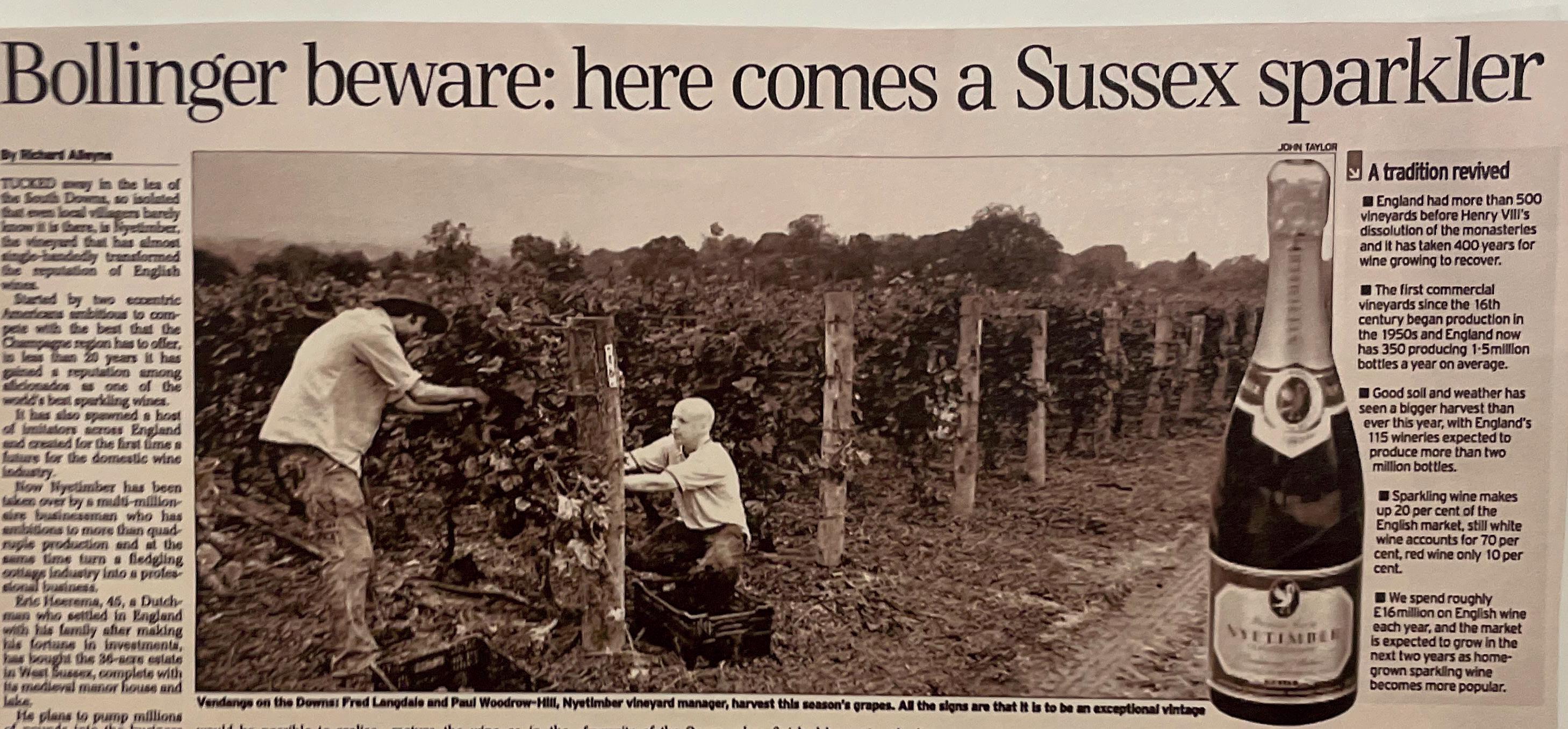
Type “Champagne” into Google, and you’ll quickly come across Comité Champagne’s beautifully curated website, dripping with romanticism about terroir and tradition. They claim their 34,000 hectares sit in a goldilocks zone – on the margins, uniquely suited for sparkling wine.
Except… that’s no longer true. Climate change has lobbed a spanner into their carefully crafted myth. Long, gentle, ripening days? That’s now ESW’s advantage. Late harvesting? That’s ESW. A climate ‘on the edge of viability’? You guessed it… ESW.
ESW needs its own website – a hub showcasing our rural revolution. A place that tells the world why our winemakers and our land now hold the magic. How sustainability and localism is built into the DNA of our industry – and not retrofitted like our continental cousins.
And while we’re at it, surely it’s time to rethink our name. The term “English Sparkling Wine” has been described as functional and dull. It also automatically relegates our wine to second fiddle on most wine lists.
“English Fizz” is catching on with the public. It’s not perfect but it’s pithy, distinct, and unmistakably ours. Why not go with the flow?
One upmarket pub chain in Kent is doing just that – English Fizz sits in prime position on their menu, with Champagne relegated to the sparkling wine section.
My friends are annoyingly more successful than me. One is a lead writer at the UK’s best-selling quality national newspaper, another is a senior partner at a big City law firm and yet another advises the CEO of a very big oil firm.
They drink a lot of wine, but ask them what Blanc de Noirs, Cuvée, or Brut means, and you’ll get blank stares. So why cling to these terms? In the land of Shakespeare, the King James Bible, and Churchill, we can do better.
The Grange is onto something with “White From Black” and “Rethinking Pink.” Let’s take it further: Single Harvest instead of Vintage. Dry or Super Dry instead of Brut. Clarity shows confidence, let’s strip away the complexity and speak plainly.

Would Rolls-Royce’s Black Badge series be as successful if it was called Insigne Noir?
English wine might have a short history, but we have a long tradition of world-class wine writers and tastemakers. The likes of Jancis Robinson, Hugh Johnson, Noble Rot’s Dan Keeling, Jamie Goode and Matthew Jukes are celebrities in the wine world. If they say your wine is great, shout it from the rooftops. Put glowing reviews front and centre on your website like a blockbuster film poster. National newspaper reviews? They still hold weight. People might not read papers like they used to, but they still trust them. Make them impossible to miss.
And don’t stop at wine influencers. Think about our world beating creative industries too – beauty, fashion, art, music and theatre –they love a little luxury. Send them a bottle, and they might give you a ‘big up’ on their social channels. One of my former clients once gifted a dressing gown to Prince George, and he ended up wearing it to meet Obama. The world’s press took care of the rest.
wine on offer at the Five Bells Inn in Brabourne, Kent
The French, bless them, are a conservative bunch. And Champagne is very French. It’s no surprise its branding has remained unchanged for over a century.
England? We’re many things, but boring isn’t one of them. So why do so many ESW makers mimic Champagne’s staid labels? Why are they as Henry Jeffreys said, in his book Vines In A Cold Climate, all a bit “branded gilet”. So put some terroir in your trademarks – pop culture into your packaging.
Some of you are already doing it. Hattingley Valley’s The English Gent has the charm of Orin Swift’s cult wines in California. Dermot Sugrue’s witty wine names reflect his Irish literary roots. Chris Wilson, a former music journalist, names his Gutter & Stars wines after pop songs and book titles.
Rathfinny named their 50cl “pint” bottle The Mini – a nod to the iconic British car and the skirts made famous by the Swinging Sixties.
This is the kind of personality ESW needs – branding that’s as fun, vibrant, and fresh as the wine inside the bottle.
Oh, and let’s ditch the foils. Unless you have a genuine vermin problem in your cellars, they look old fashioned, are an unnecessary cost and are terrible for the environment.
Never forget – it was the British who turned Bordeaux into a global powerhouse. It was the British who first embraced sparkling wine and transformed it into the luxury product it is today. And it was the Brut-ish British who made it dry, when everyone else wanted it to be a dessert wine.
History is on our side. Now it’s time to make the future our own.
As Stephen Skelton recently pointed out, we’ve taken eight million bottles out of Champagne’s sales already. There’s no reason we can’t take another 10 million in the next decade.
And if we do, at my friends’ 60th wedding anniversary, it won’t be Champagne in that wheelbarrow, it’ll be ESW in its rightful place adding fizz to the celebrations.
Richard is a former journalist at The Daily Telegraph, who has worked as a communications consultant for a broad range of clients from Amazon to Royal Artists. He currently works with entrepreneurs in the beauty, television, AI and English wine industries.
✉ fivewiseconsultancy@gmail.com
The annual WineGB Pruning Competition is a great opportunity for viticulturists from the UK to get together to celebrate the art of pruning. This year was the sixth event and saw the competition hosted at Clayhill Vineyard in Essex for the first time. It was great to see so many vineyard professionals come together on 7 March 2025 for the ‘Battle of the Secateurs’.
In weather which was outstanding with temperatures reaching 18 degrees as the clear blue skies framed the far reaching views across the Crouch Estuary, teams went head to head displaying their skills to the judges and the spectators. The nine teams were: Davenport Vineyards, Wiston Estate Vineyard, Ridgeview Pruning Squad, Vineworks, Vinescapes, Gusbourne Kent A, Gusbourne Kent B, MDCV Kent and MDCV Sussex
James Dodson of VineWorks, a co-founder of the event advised those taking part to “have a great day, celebrate viticulture and have fun.”
The two teams of MDCV entered the competition for the first time and there was plenty of banter between the two teams as the competition advanced. Radu Tandarescu Vineyard Manager for MDCV in Kent said one of the main motivators to enter the competition was to exchange ideas and experiences with others working in the viticulture sector. Radu, who competed with MDCV
To enter the 2026 competition or to become a sponsor, send an email to James Dodson at Vineworks or Gillian Jordan at WineGB
✉ james@vine-works.com
✉ Gillian@winegb.co.uk
Kent explained: “The vines here are much older that the vines we prune at our site in Kent. Our vines are six to seven years old and these are 19 years old so there is more dead wood but the principles remain the same. Taking part was a great experience and we will definitely be back next year.”
The team from Ridgeview were returning for their second competition. The team consisted of Austin Ellis, Emily Payne and Lars Lundqvist. All the team agreed that the age of the vines was a challenge with a significant amount of old wood but Lars who was the cane puller said that his part of the competition was easier than in 2024 because previously the canes had been quite brittle. Austin said: “I was a little disappointed with the cuts I made on vine one. I think I went off a bit too quick and it was a challenge to find good spurs, but as a team we were more in tune and more confident together than last year.”
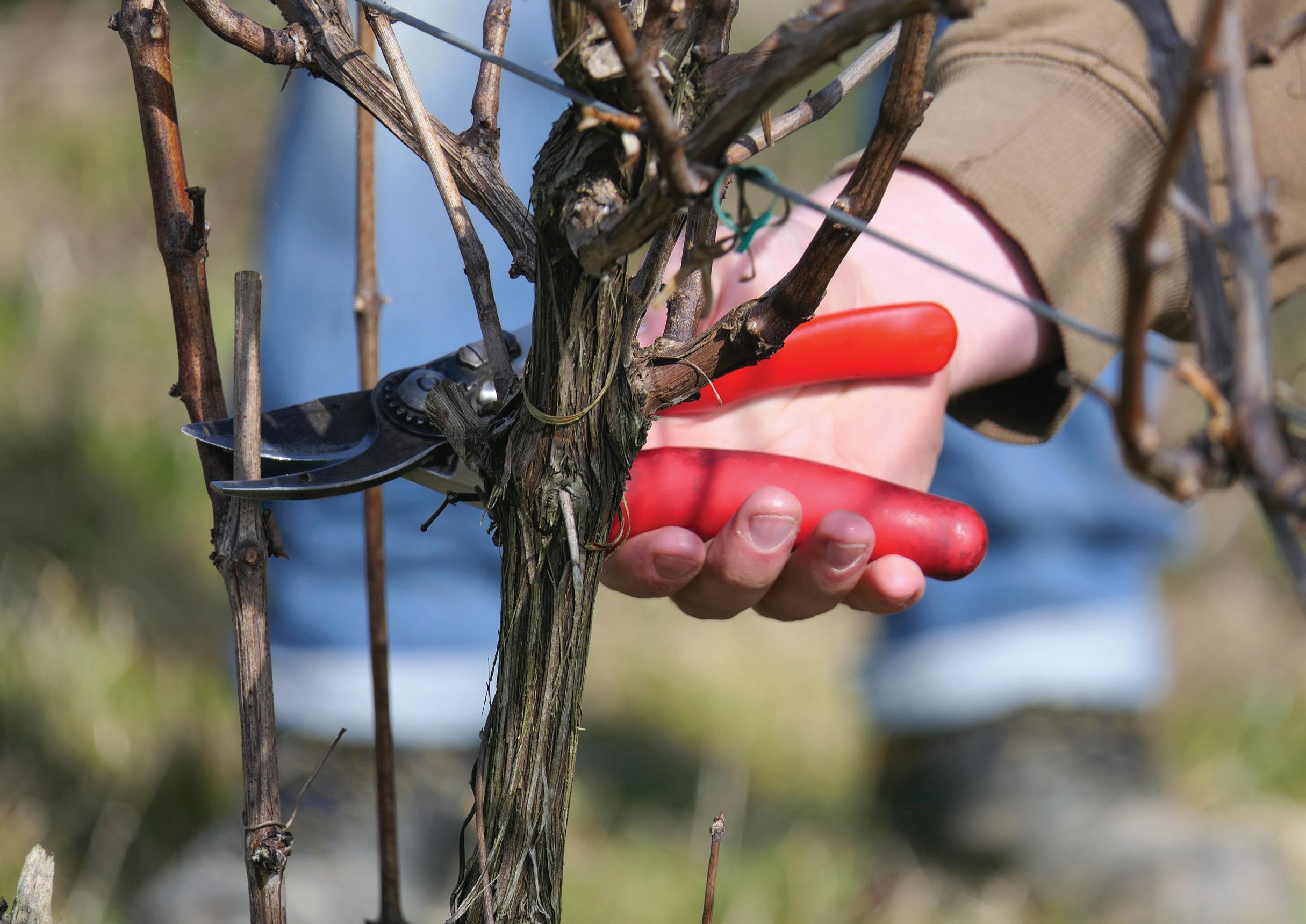



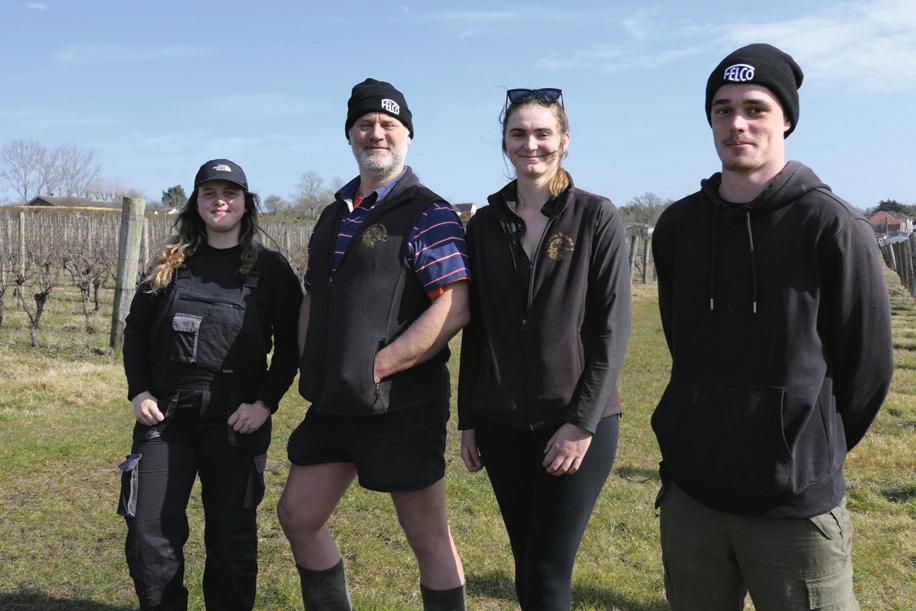

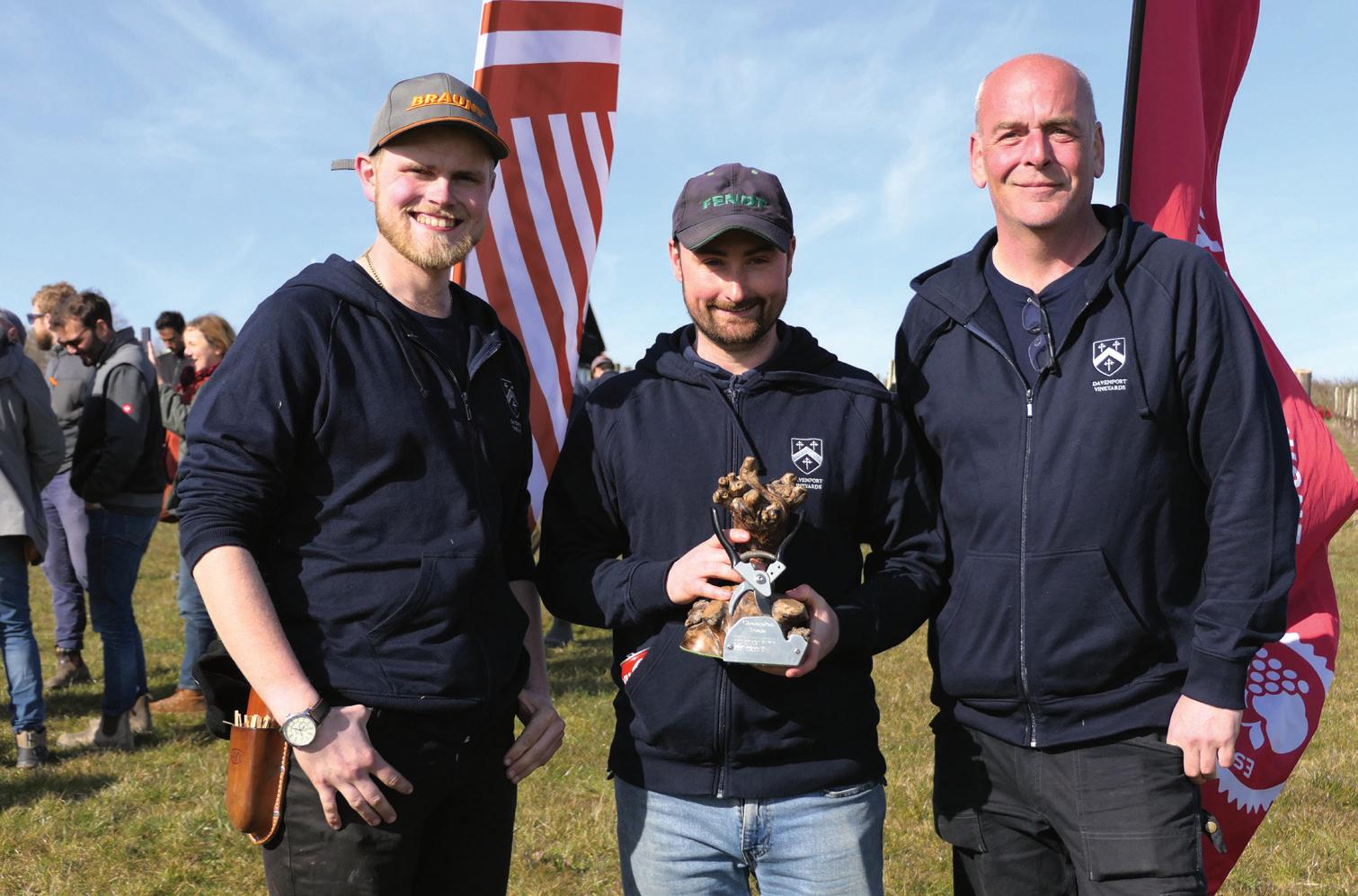

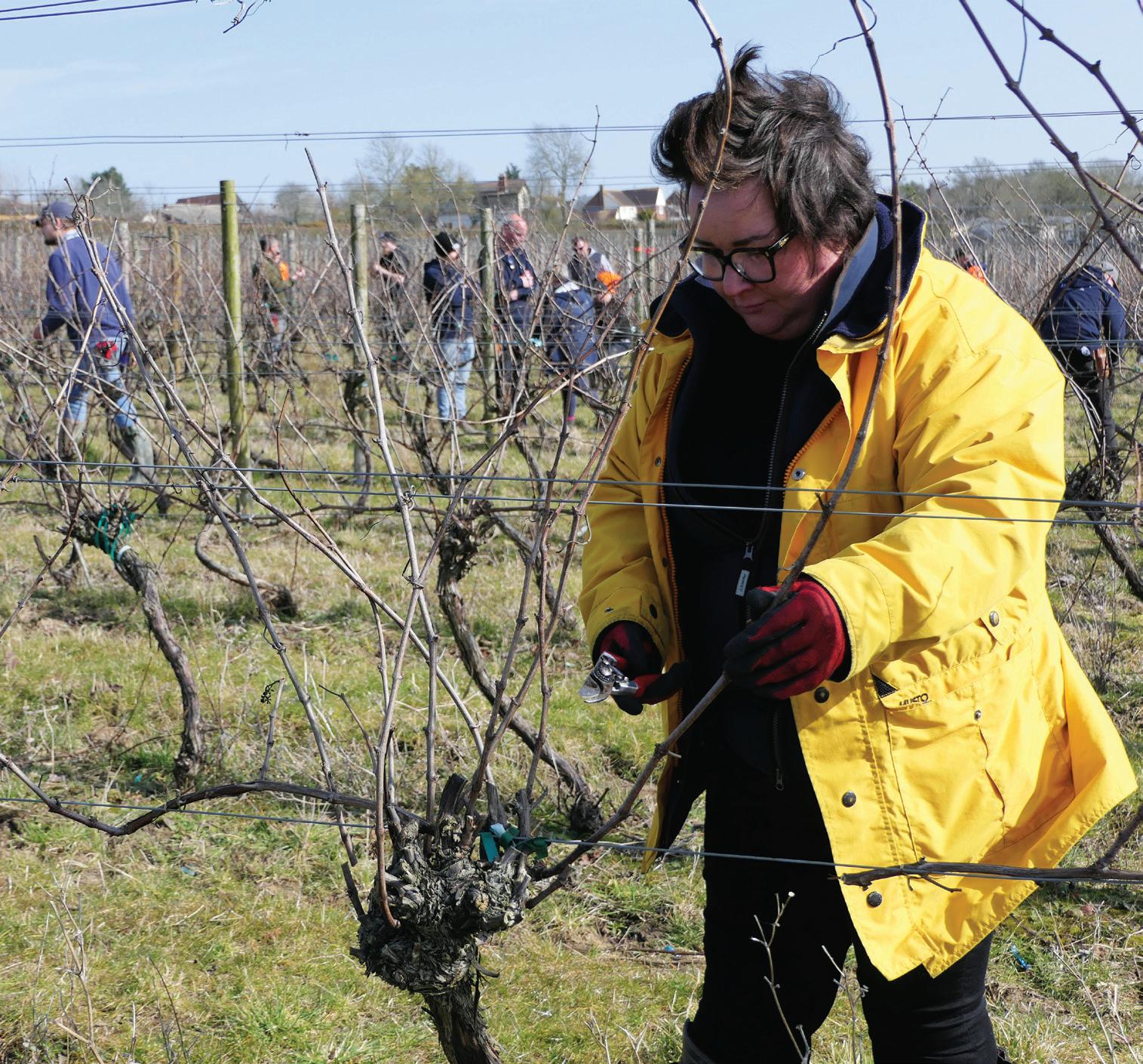
<< The competition is not limited to teams and a solo pruning event was also held. Philip Harris, Sarah Purkis, Ed Evans, Daniel Bojan, Dave Mates, Dragos Nitu, Joe Tingley, Ben Ralph, Travis Salisbury, Thomas Bailey and Rory Pinnegar were the eleven solo competitors who bravely put their pruning skills on display. Sarah Purkis entered the solo competition for the first time. “My competitive side took over,” she said with a laugh. “It is also a great opportunity to see how other people undertake the task of pruning,” she added. Sarah leads a team of 30 at Tom Bunting Vineyard Management and said she would like to return to the competition next year and enter the team event with some of her colleagues.
It was mentioned by several in attendance that the competition was a great chance for those working in viticulture, which can be quite a solitary profession, to get together, celebrate have fun and exchange ideas as the season begins. Liz Shaw visited the competition for the first time as a spectator. Travelling from Wressle Vineyard in North Lincolnshire Liz said: “We spend a lot of time working alone in the vineyard across the year so it is really important to have the opportunity to get together as a group and have fun and celebrate what we do.”
Other spectators included Dr Belinda Kemp, Adrian Harris and Thorne Stopps of NIAB. As Horticultural Commercial Trials Co-Ordinator


Adrian said: “There is a difference between research environments and commercial environments and the pruning competition is a great opportunity to witness the work happening in vineyards across England and Wales and to speak with those involved with vines on a daily basis helping us to keep our research commercially relevant.”
The excellent spirit in which the competition is conducted was illustrated by the friendly in-house rivalry, with both MDCV and Gusbourne entering multiple teams competing for ‘bragging rights’ as much as the trophy. Having competed in the team event both Travis Salisbury and Thomas Bailey of Wiston Estate Vineyard (who last year were part of the judging panel) then went head to head in the solo pruning event.
In charge of the competition element for 2025 was Luke Wolfe Director of vineyard management company Agro Pro. Outlining details of the competition he explained: “The team must complete five vines and when finished raise your secateurs. Unlike previous years there is no set time limit. Timing will only be used in the event of a tie.” Regarding the specific requirements of the competition Luke continued: “The judges are looking for single canes with 8-10 buds. Vines should be tied down uphill with no overlapping. These are tricky vines and we want them pruned well rather than quick so take your time to think about the cuts.” <<
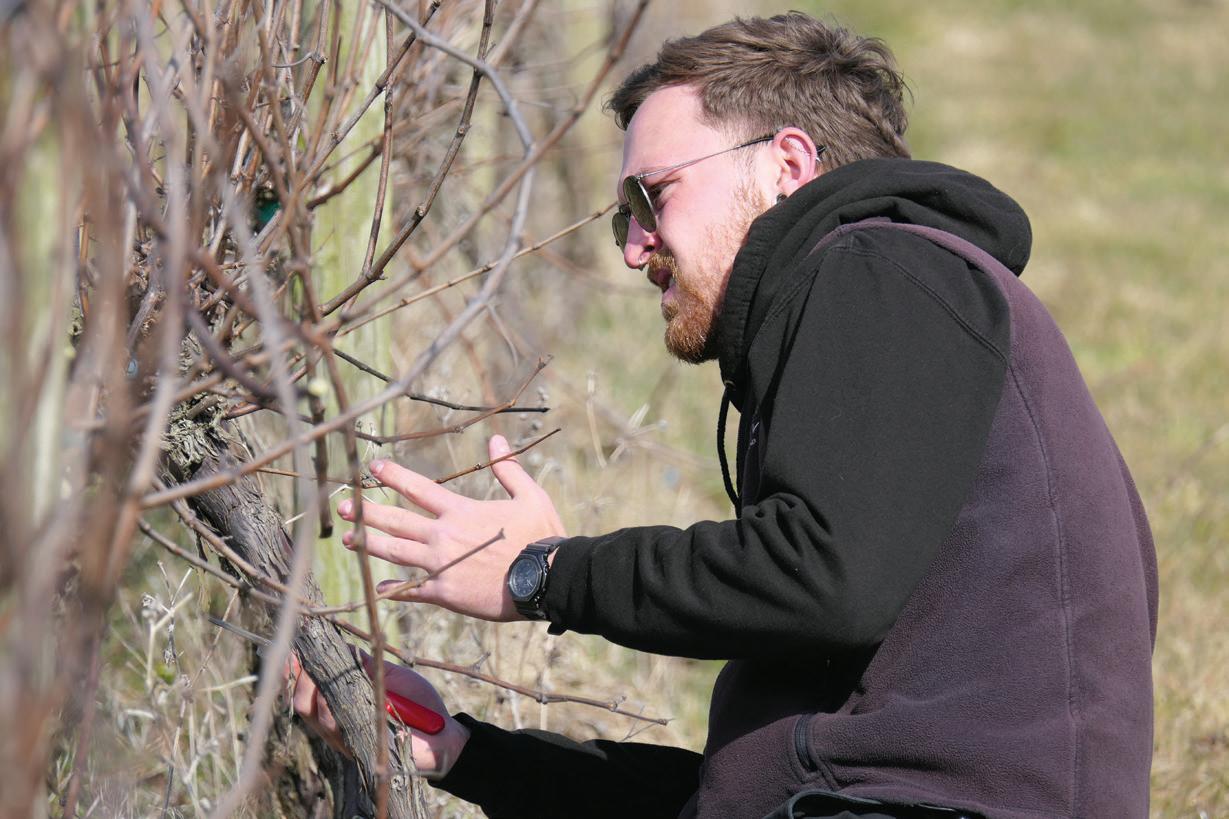

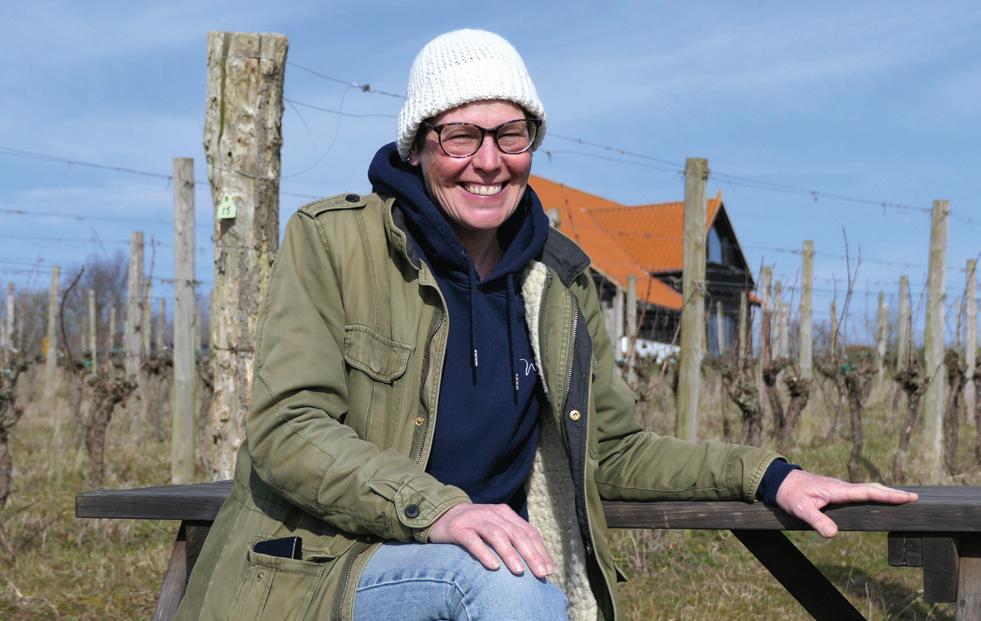
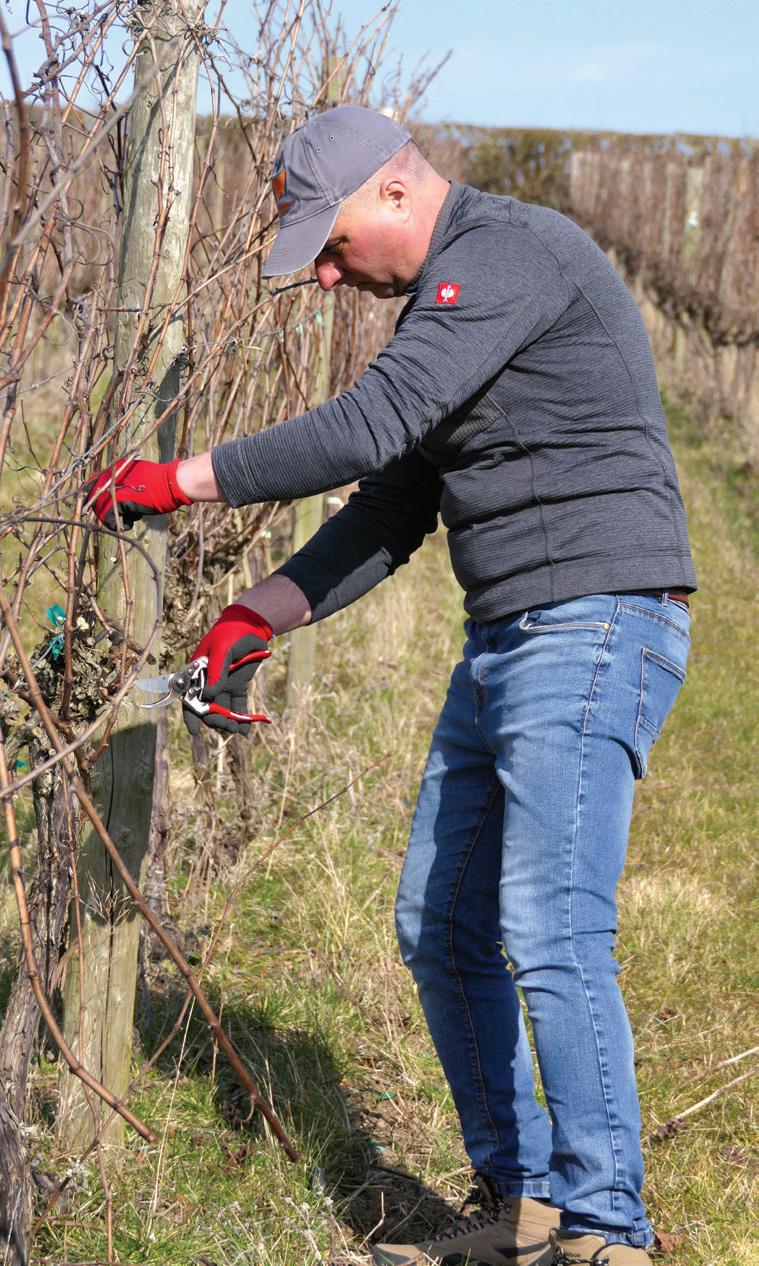

Talk to us about our new condensed package options to help guide the changes you’re looking for in your vineyard.
We’ll provide you with a detailed assessment of your vineyard, resources, machinery and other considerations to understand what opportunities are available for you to invest in more profitable outcomes.
Curious about how you can farm more sustainably? Or are you interested in achieving sustainability certification? Let us guide you with a roadmap for how you can achieve your sustainability goals, and generate more consistent fruit quality.

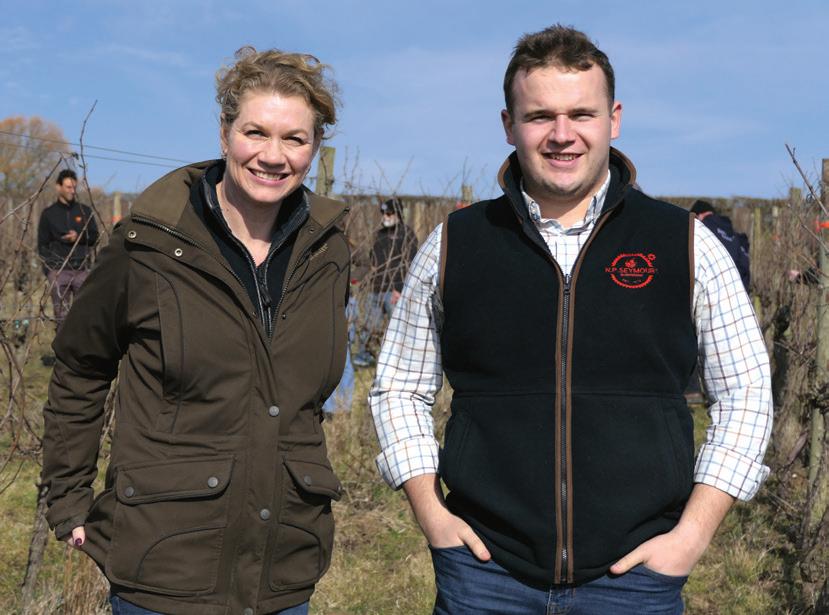



The opportunity to celebrate vineyard skills was appreciated by everyone including the judges. Lead Judge Luke Wolfe was assisted by John Mansini (Brenley Farm), Ben Brown (Agrii), Jim Pritchard (Vineyard Manager, Chapel Down, Ashford) and Cameron Roucher (Vinescapes).
In previous years Tony Purdie who is a co-founder of the event and Vineyard Manager of Yotes Court has been the lead judge. “Tony’s were big shoes to fill” said Luke, “but we used his judging system that has been fine-tuned over the last five competitions.” Luke is well acquainted with the competition having been a judge in previous years. This year the time element was removed which was different from previous competitions and Luke explained the decision: “The difficulty level has to be appropriate to showcase the skills of the pruner. The vines were older and tricky so there was no need for a time limit.” The judges certainly had a difficult job as the level of skill on display was extremely high with Luke stating that 80%-85% of the vines were pruned perfectly. “This shows that we are highly skilled industry,” James Dodson added.
“Pruning along with other vineyard skills are vital but they are hidden in individual vineyards across England and Wales so it is encouraging to see the level of skill displayed and being celebrated at this industry competition,” said Luke.
The day was fantastic for all those who took part and it was great to see so many spectators enjoying the atmosphere and celebrating the hard work that goes on in vineyards not just at pruning but throughout the year. The event is really important for the development of the industry and James Dodson said: “I would like to say a special thank you to all the sponsors: Felco, NP Seymour, Agrii, Hadley Group, Kirkland, NFU Mutual, Pepinieres Tourette, Vineyard Magazine and VineWorks. Also thanks must go to Dale Symonds and the team at Clayhill Vineyard for providing an excellent venue to host the competition.
First place in the Solo Pruning Competition was awarded to Dragos Nitu of Gusbourne. Dragos was not only the highest scoring solo entrant but he also had the fastest time at 5 minutes and 50 seconds.


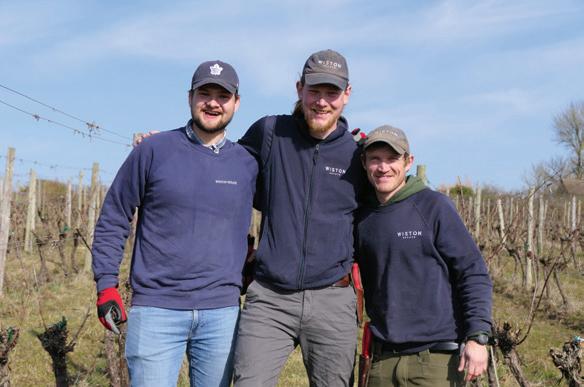
“I do always work at speed and even though the competition was not timed it was still tough to choose the best spurs for sap flow,” said Dragos who last won the competition in 2020. Second place was awarded to Daniel Bojan and first-time competitor Thomas Bailey was awarded third place.
Congratulations go to the winners of the team event, with Davenport Vineyards team of Ben Connor, Ben Ralph and Mark Wilson taking first place with a time of 13 minutes and 5 seconds and 84 from a possible 90 points, placing them two points clear of Gusbourne A and Vinescapes who were tied on 82 points. Gusbourne A secured second place with a faster time of 7 minutes 10 seconds.
The winners were provided with some fantastic Felco prizes donated by NP Seymour who were there on the day to support the event. “We are pleased to be a sponsor of this fantastic event that showcases the skill and dedication of viticulturists across England and Wales,” said Claire Seymour, Sales Director at NP Seymour. Discussing the art of pruning and the competition rules Tim Sillience of NP Seymour sales team pointed out “the competition rules state that secateurs must be manual, electric pruners would be much easier to use but it would be much less competitive,” he said with a laugh that spread to the entire group.
It is important that support for this event continues to grow just as the area under vine increases. It takes a huge amount of effort to organise the event and Luke Wolfe was quick to point out that “the amount of work that James Dodson puts in is underestimated.” Wine competitions are plentiful but it is very difficult to make good wine from bad grapes and the pruning competition is a chance to shine a spotlight on the highly skilled viticulturists quietly working in vineyards across England and Wales. It is essential that this event thrives and that sponsors continue their support, that spectator and competitor numbers continue to increase and that vineyards around England and Wales volunteer to host what is a celebration of those who work so hard to improve the quality of grapes produced year on year.
Growing productive and efficient vineyards.
Vinescapes’ viticulturists Joel Jorgensen and Rob Poyser sat down to discuss how data collection and analysis drive their approach to increasing yield, nurturing healthy vines, and achieving cost savings throughout the year.
Importantly, Joel explained how with sufficient data, vineyard management becomes a lot easier – by revealing how often you need to apply protective measures such as sprays, how much a vineyard might need additional nutrients or fertiliser and where to concentrate labour over the season.
Q. Why is data important to what you do?
Joel: “Every vineyard site is distinctly different, so we tailor our services and approach, and don’t work to a recipe. We make sure we fully understand the wine product or style our clients are seeking to create, and we respond accordingly. This means getting the right data sets to decide how to deliver the best possible fruit at harvest time.”
Rob: “We do spend a lot of time counting, sampling and reporting on the health and state of the vineyard but this results in a lot of time and money saved for our clients by knowing what we do need to do and when.”
Joel: “If we were to follow published guidelines on how to manage the vines, when and what to spray, or how to prune, it would cost our clients significantly more. Instead, by using a data-driven approach, we keep costs down while delivering optimal results.”
Rob: “The important thing is to know when not to do anything. We follow a regenerative viticulture approach. If we interfere with this, it can often be detrimental. This approach not only saves costs, but it allows nature to build the soil structure and resilience each vine needs to perform at its best.”
Q. Can you give me some real examples of where data analysis delivered better results?
Joel: “We work with a vineyard, which initially had a problem of having too much fruit – they couldn’t get it ripe, resulting in a lot of fruit wasted. By pruning more effectively and counting at inflorescence, fruit set and veraison, we could bring the harvest forward and manage the yield more effectively. We also saved them a significant amount on labour. They are now producing impressive, quality fruit and getting it into the winery on time.”
Rob: “At all our sites, we are diligent at scouting for pests across the vineyard. We also carefully monitor the weather and conditions. This might mean we visit the site a few more times than our clients expect, however we know this saves clients thousands of pounds in sprays. We don’t spray unless the data tells us we need to.”
Joel: “I can confidently say we spray 30%-50% less than the Green Book spray programme, due to data collection and our regenerative approach. We have the confidence, experience, and decades of

knowledge to trust the data indicators to know not to spray if we don’t need to.”
Q. What are some of the most important data sets you collect?
Rob: “Soil analysis is a big one. We collect detailed data about the soil structure, nutrient status of the soil, bacterial and fungal populations, assess how soil holds moisture and how the soil maintains biodiversity. We regularly count earthworms and other life forms in the soil and under vine too.
This helps us to understand what cover crops to plant, the mulch and compost load required or fertilisers to apply.”
Joel: “Assessing the biodiversity of a site gives us a lot of information. It can tell us whether the soil is in poor health or in good condition. We also take a good look at the soil carbon stocks across the site.
But we also do a lot of analysis of the canes, canopy, and bunches, to manage the crop load per variety and clone.”
Rob: “We see the results when we take on a new site and the change in performance in just one year, by simply assessing biodiversity, counting earthworms and looking at carbon stocks.
A simple change we’ve found our clients can do is to reduce mowing alleys and headlands. Allowing grass and cover crops to grow is extremely beneficial for promoting biodiversity and improving the overall health of a vineyard, not to mention the amount of time and fuel it saves.”
If you’d like to know more about how to gain productive outcomes from your vineyard and use data more effectively, get in touch with the team at Vinescapes.

Attending the Hallgarten & Novum Annual Tasting at Old Billingsgate, London, was a fantastic opportunity to explore the evolving landscape of English wine. Hallgarten’s growing commitment to supporting homegrown producers was evident, with an impressive lineup showcasing the diversity and quality of wines being made across the country.
As one of the UK’s most established wine merchants, Hallgarten has long championed premium wines, and it is exciting to see English wine playing such a central role in their portfolio. Their dedication to getting these wines into both the on-trade and off-trade is helping drive the industry forward, ensuring more consumers can experience the best of what England has to offer.
The lineup of English producers in attendance was exceptional. Wiston Estate was represented by Marcus RaynerWard, Head Winemaker, who presented their impressive range of vintage and non-vintage traditional-method sparkling wines. New Hall Vineyard from Essex was represented by Lucy Winward, Head of Sales and Marketing, and Olly Shaw, Head Winemaker, who shared insights into the estate’s evolution and the rising reputation of Crouch Valley wines. Meanwhile, Henry Rymill from Simpsons Wine Estate showcased both their still and sparkling range, highlighting the estate’s dedication to quality winemaking.
London’s Blackbook Winery was in attendance with Sergio Verrillo, Founder and Head Winemaker, highlighting the exciting possibilities of urban winemaking. Ridgeview was represented by Brandon Barnham, Senior Business Manager, showcasing the pioneering Sussex estate’s sparkling range. Coates & Seely, of Hampshire, also made an appearance, as
did boutique winery Hoffmann & Rathbone, with Ulrich Hoffmann, Founder and Owner, reinforcing the reputation of English sparkling wine at the top end of the market.
A real talking point was London Clay, a new addition from MDCV, introducing two Charmat-method sparkling wines to the portfolio – proof that innovation is thriving in English winemaking.
Hallgarten’s role in supporting English wine goes beyond simply listing bottles. Their influence in the trade, combined with their commitment to sustainability and quality, makes them a vital part of the industry’s growth. Events like this bring producers and trade professionals together, fostering connections and driving the future of English wine on a national scale.
With so many exceptional producers under one roof, this year’s tasting was a brilliant snapshot of just how far English wine has come – and a clear sign that it’s here to stay.
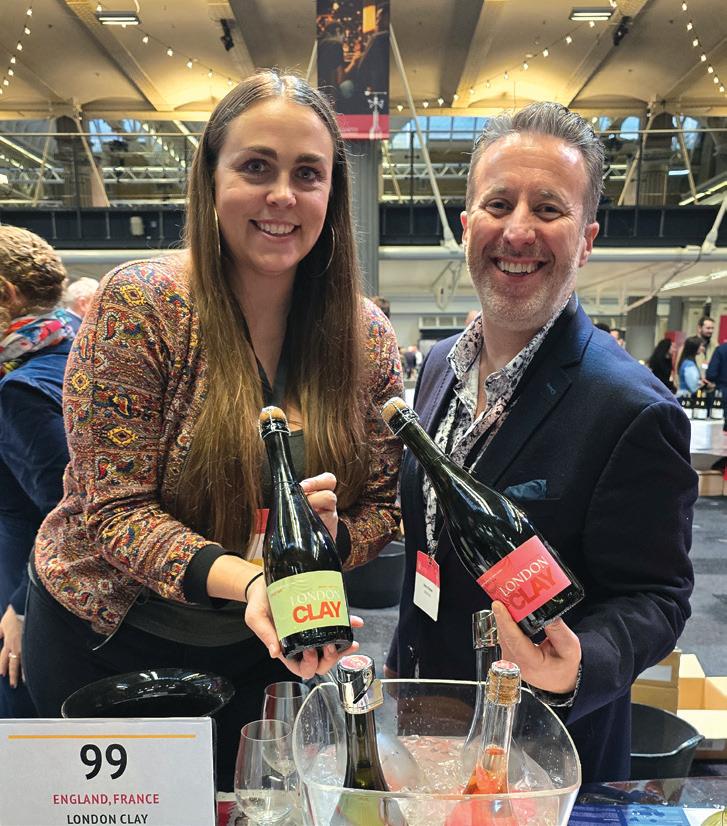
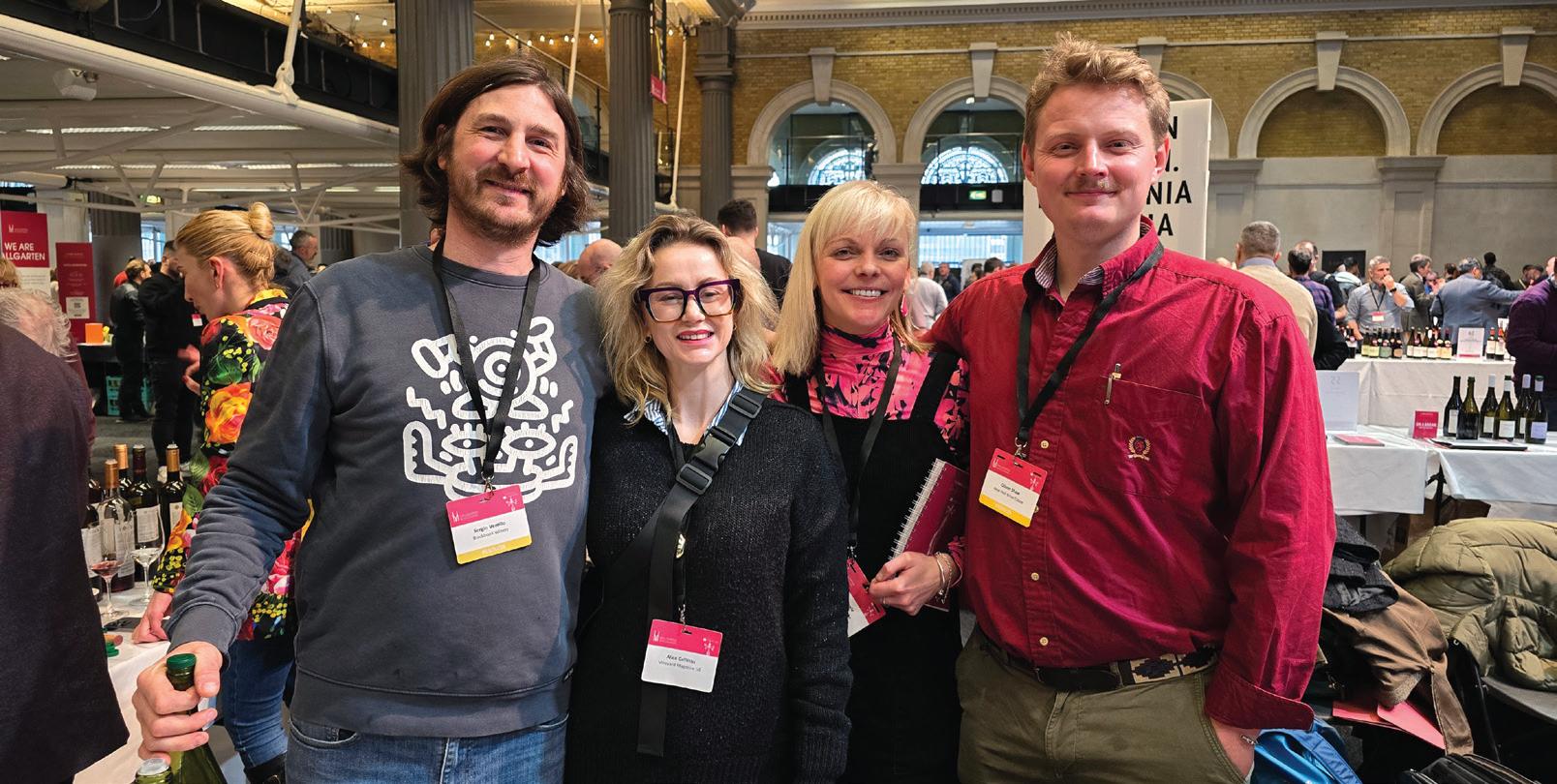


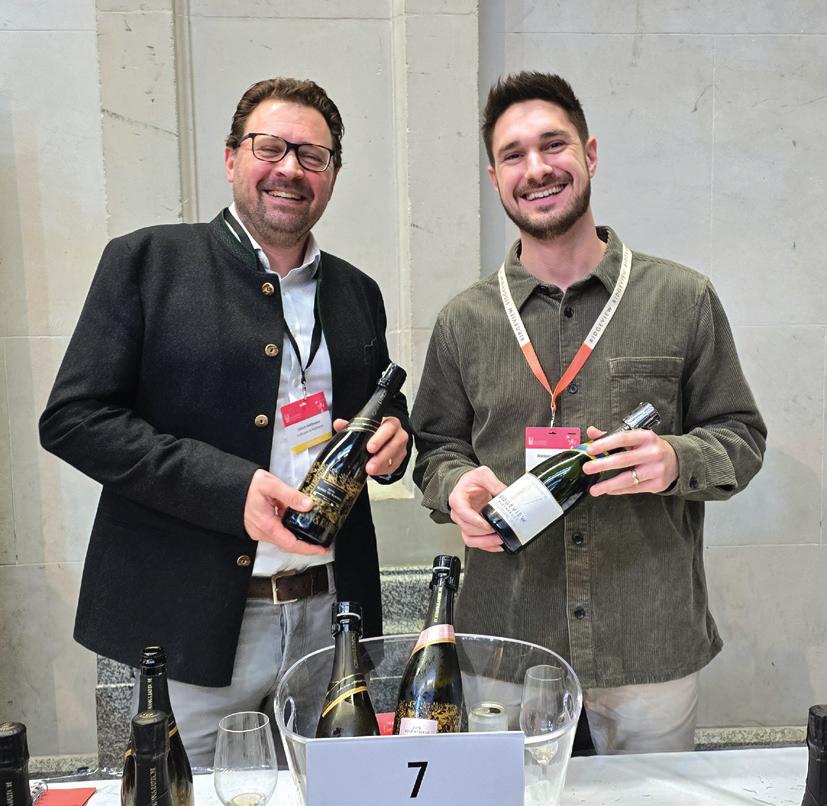
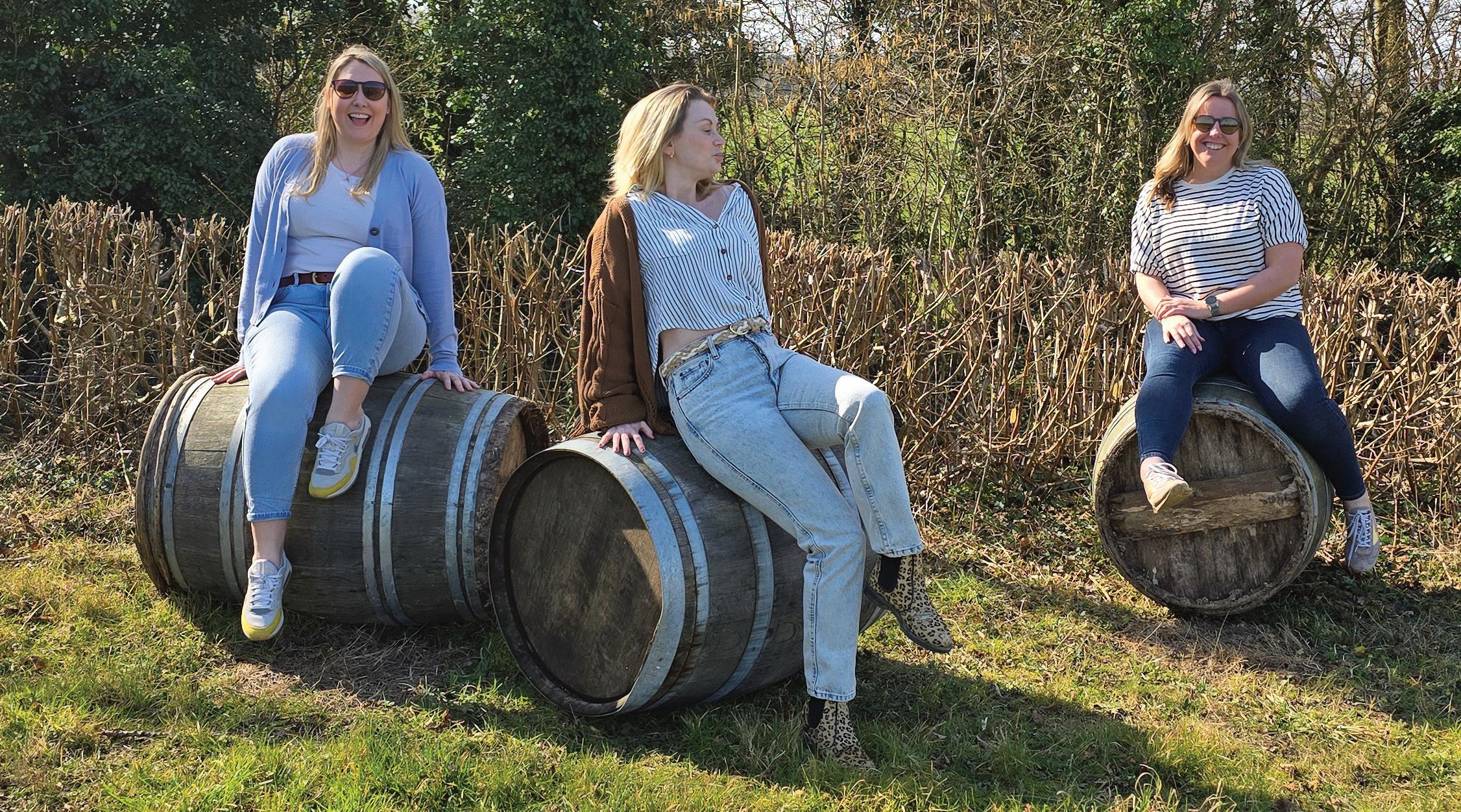
A day of creativity, craftsmanship, and a glass of sparkling wine – what better way to experience a vineyard? Westwell Wines, a picturesque estate in Kent, has built a reputation for its innovative approach to engaging visitors, and their recent screen printing workshop was no exception.
Upon arrival, we were warmly welcomed by Serena Edward, who oversees Cellar Door and programming, before joining a group of eager participants for an afternoon of hands-on creativity. The workshop was led by Rachel Moore of I Printed That, a talented Kent-based printmaker whose impressive portfolio includes collaborations with The National Trust and Spotify.
The day began with tea, coffee, and an introduction to screen printing, setting the stage for an immersive experience. We then took a self-guided walk through the vineyard, soaking in the landscape, spotting the first signs of spring, and drawing inspiration from the vines, winery, and rolling countryside.
Back in the tasting room, Rachel guided us through design principles, stencil cutting, and layering techniques, patiently helping us transform our initial sketches into fully realised compositions. As our designs took shape on canvas tote bags, we paused to enjoy a glorious lunch of seasonal, locally sourced food, accompanied by a glass of Westwell sparkling wine. This well-earned break provided the perfect moment to connect with fellow attendees, sharing creative inspiration while appreciating the fruits of Westwell’s labour.
Westwell has long been known for its ability to bring people together, curating experiences that extend far beyond traditional wine tastings. From open-air cinema nights and clay workshops to their much-loved dog show and pizza van evenings, they have mastered the art of creating a welcoming, communitydriven atmosphere. This workshop was yet another example of how vineyards can offer more than just great wine –immersing visitors in the environment, engaging them in creative processes, and fostering a deeper connection to the space and the people behind it. Beyond being an enjoyable afternoon, this event highlighted a growing trend in the English wine industry, where vineyards are expanding their offerings through immersive experiences that engage new audiences, drive tourism, and boost sales.


Alice Griffiths
Alice Griffiths is a wine communicator boosting the profile of English and Welsh Wine on social media, under the popular handle of Posing With Alcohol. Alice has worked within the agriculture industry for the past 20 years, spending time as a lecturer and a smallholder before discovering her passion for viticulture, winemaking and wine tasting.
Get in touch to have your events featured: ✉ Posingwithalcohol@gmail.com
INSTAGRAM Alice can be found on social media under @posingwithalcohol on Instagram.
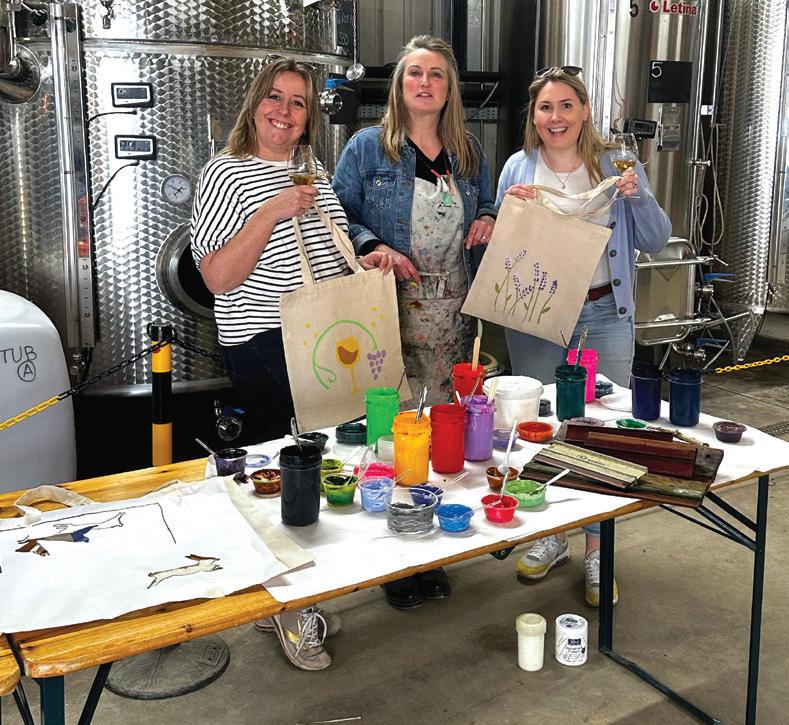
Wines: For more information on Westwell Wines and all their upcoming events: DESKTOP www.westwellwines.com

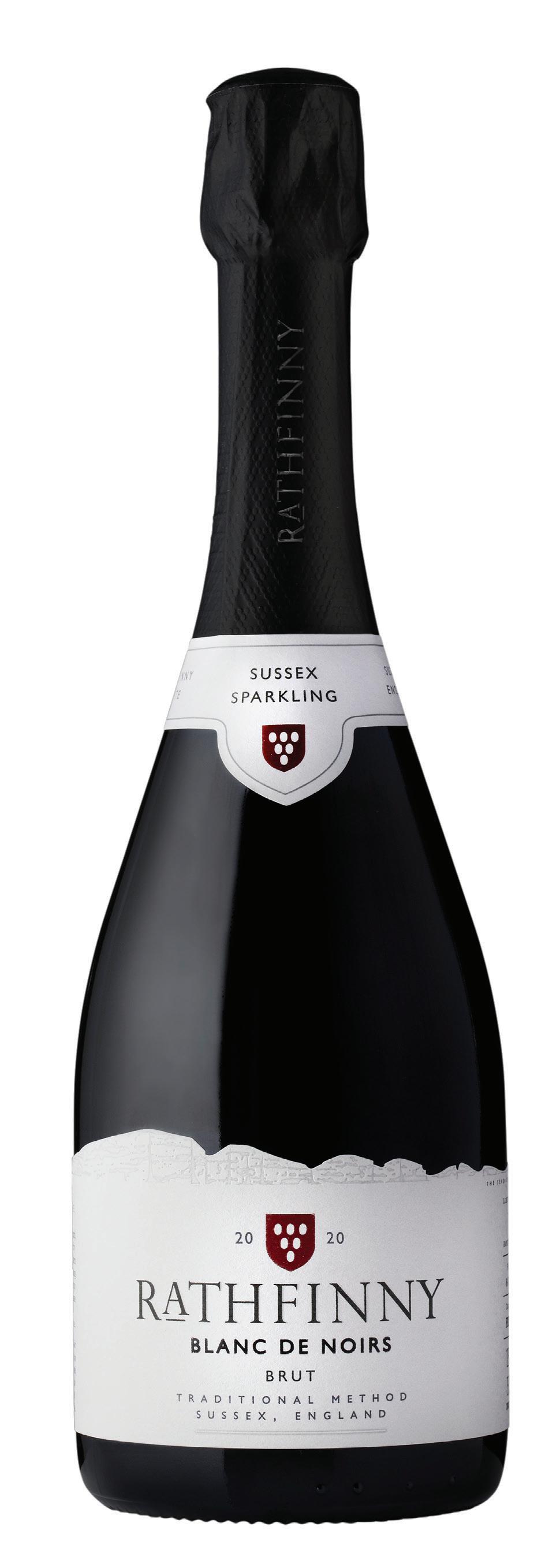
When we first put my alcohol-free brand, Jukes, into cans, we wanted an up-market expression to use while talking about our cans. We landed on Ready-to-Pour or RTP.
Of course, Ready-to-Drink had already been commandeered by fast-moving fizzy pop and the like. Only the other day, a customer ordered some cans, calling them Ready-to-Enjoy! This makes my RTP expression look positively egalitarian!
I suppose the immediacy of the word ‘ready’ takes its romantic origins from Pret-à-Porter, the stunning name for readyto-wear, off-the-shelf fashion ranges, one rung below those bespoke, couture and handmade items! Later, ‘pret’ was mangled by Pret A Manger, who diminished the ‘eat’ word in favour of the all-powerful ‘ready’, and this is a compelling and essential word in our wine lives.
It’s a shame RTD has been debased, as the expression RTD sparkling wines, gives the inaccurate and unfair impression that a wine is cheap, gluggable and forgettable.
Of course, this is entirely incorrect. RTD sparkling wines include legions of sensational Champagnes, English Sparklers, and wines from further afield that are

genuinely delicious the moment they are poured into your glass. They are the opposite styles to those that are pinched, firm and youthful – like many sparkling wines that hit the market. These are Readyto-Ignore, at least for the time being.
Proper RTD English sparkling wines are the most important category in our wine business. These wines are ready to impress, ready to amaze and ready to satiate. This notion alone sounds mouth-watering! But making wines with early-drinking and complete characters is far from easy.
At the very least, we have to manage our acid profiles like the most talented tightrope walkers! But this is only one aspect of a thrilling RTD sparkling wine. Fruit precocity and openness, without ever tipping over into tutti-frutti simplicity, is the greatest challenge, and this is where viti and vini teams must sing from the same song sheet.
If you can achieve RTD harmony, there is no excuse for people not opening your wines. If they are truly balanced, mellifluous and enjoyable, you cannot fail! Every successful portfolio must be based on epic RTD wines. Is yours?
Mark Driver is the King of RTD wines. I remember at his first press launch, after I pulled him aside to discuss the wines, scratching my head about how unbelievably enjoyable they were compared to the opposition’s creations. Mark replied that he wanted to make wine to drink now. We will release them when they are drinking. I worried that they might not have the ability to age. I need not be concerned because if balance is born, everything else follows. This newly released 2020 BdeN is a perfect case in point and it also happens to be Mark’s favourite style.
Made from 86% Pinot Noir and 14% Pinot Meunier, in conditions that rivalled 2018, this is a glorious wine that sits alongside any overseas creations. It is plush, silky, layered and effortlessly classy while maintaining a freshness and crunch on the finish thanks to its lip-smacking 3g/L dosage. Every great Champagne producer hammers home the message that if your grapes are perfectly ripe at harvest, they don’t need much additional sweetness. Rathfinny has done this on countless occasions, and this wine is the latest in a run of sublime red grape wines.
£45.00 www.weyborne.com
£48.00 www.brunswickfinewines.com www.hawkinsbros.co.uk

I have known Weyborne’s commercial director William Sharpley for getting on for 38 years. Wine trade orbits intersect with encouraging regularity, often with never enough time for a chat, rarely more than a nod, but occasionally a glass or two of wine. William’s extraordinary tenure at Moët Hennessy set him up perfectly for a career move into our own wine trade, and he picked Nick Clarke’s remarkable Weyborne Estate, which has been featured in this very magazine. I liked the 2018 Family Reserve Brut, but when I tasted 2019 Oriana with William last year, I recognised a serious step up in luminosity, cadence and silkiness. This wine is drinking perfectly already with generous patisserie notes among the charming orchard fruit tones. The packaging is beautiful, and the flavours continue in this vein.
NV Cottonworth, Classic Cuvée
£31.49 www.allaboutwine.co.uk
£31.99 www.strictlywine.co.uk
£33.00 www.hic-winemerchants.com
This was the first wine of around 300 I tasted at the recent Berkmann Wines Cellars tasting. It was wine number one in the booklet and one of a dozen that I wanted to write up as soon as possible when I left the Guildhall.

It is fortunate, then, that this month’s theme and deadline made its inclusion in this column possible. Made predominantly from the 2019 harvest from 58% Chardonnay, 35% Pinot Noir and 7% Pinot Meunier, with a slight 4.2g/L dosage, this is a seamless, gentle, resonant wine with a medium-weight body and a long, clean, zesty finish. It does nothing whatsoever to appeal to fans of big, bold, rich, theatrical wines. Instead, it seeps into your senses, spreading perfectly judged Zen-like joy that is pinpoint accurate and deeply refreshing, and anyone and everyone will understand its message. This is a spectacular RTD sparkler that romances the senses with unwavering accuracy.
Contact Itasca Technical Services for all your servicing and equipment requirements in 2025!
Itasca Technical Services / Contact: John Simmons Tel: 07788 561464 / Email: john.s@itascawines.com

Bluestone Vineyard, situated near the city of Salisbury and the ancient monument of Stonehenge, literally has thousands of years of history under foot, or in this case under the vines.
Bluestone Vineyard shares its car park and entrance with a Rare Breeds Survival Trust Farm Park which has native breeds of sheep, pigs, ducks, geese and goats that used to be common in the British Isles but are now in danger of being lost. Brothers Nat and Toby McConnell run the vineyard operation – their parents bought the farm park in 2001 – and the 40 acre site had plenty of space and was a place that was welcoming to everyone. Nat and Toby followed their own paths but they had always felt a connection to the land. “Running a farm park that welcomes 40,000-60,000 visitors a year comes with its own problems,” said Nat.
This deep family connection to the land and area meant that Nat and Toby wanted to be able to produce something tangible from the ground they love so much. They wanted a product that would reflect
the unique nature of this site and the thousands of years of human history that the area holds.
There were more than 14,000 vines planted on the site in 2016 and 2017 and Vineyard Magazine first visited the fledgling vineyard early in 2020. The vineyard was planted with Burgundian clones of Chardonnay and Pinot Noir varieties with a small parcel of Pinot Meunier. Ian Phillips of Vineyard Solutions was the consultant who helped Toby and Nat decide on the vines that would help them build a premium sparkling wine brand. At its maximum the vineyard is 136m above sea level planted on the side of Beacon Hill. Whilst the site is undoubtedly high in places, evidence that the climate is mild here can be seen in the many varieties of spring bulbs that have bloomed by the middle of February.

The sight of so many spring flowers prompts a discussion about frost damage in the vineyard. “We learn more and more about the site each year,” said Nat. The site had been used as grazing land for decades so there was no working agricultural knowledge of the growing conditions in this area. “There was frost damage in 2017 when the vines were establishing. This probably meant the vines took a year longer to get fully established but we have not had frost problems since the vines have been in production,” said Nat. That does not mean that the team at Bluestone Vineyard take a relaxed attitude to frost. “We prune the Pinot Noir and the Pinot Meunier first and we delay pruning of the Chardonnay in order to ensure bud burst is as late as possible, this is a technique that seems to have worked well for us in recent seasons,” said Nat.

Nat holds an Msc in Viticulture and Oenology from Plumpton but he is keen to point out that multiple vintages working in the vineyard have taught him a great deal. “When we first planted the vineyard we really thought that moles were going to be a big problem but actually it turned out to be hares burrowing and causing problems for the tractor,” said Nat. Nat has a deep understanding of how each variety will perform on the site, to demonstrate he talks through the particular idiosyncrasies of each variety. “At the start of the season we have to improvise with the Chardonnay pruning every vine sympathetically and individually so that it produces beautiful fruit that is robust and consistent. The Pinot Noir crops heavily with good quality but requires strict canopy management. The Pinot Noir also has a tendency to double bud however the Pinot Meunier which make up about 5% of the total vines are nice to work with as the canes are flexible.”
Since the release of the estates first vintage Nat has taken on the task of marketing the wines. Toby undertook the viticulture apprenticeship course at Plumpton and has become more involved with the vines. “I do miss the connection with the vines, I miss being out among the vines everyday, perhaps a bit less when it is raining,” Nat said with a wistful note in his voice. Discussing problems in the vineyard such as mildew, Nat pointed out that as each year passes his viticultural education has become far more attuned to this specific site. “We know where mildew may first appear in the vineyard and Toby has done a great job in a difficult season,” said Nat. Bluestone Vineyard have added to their ranks and have taken on a new vineyard manager, Christopher Gore, who will be undertaking a course at Plumpton in the coming year. Progressive learning is a key foundation principle at Bluestone Vineyards and ensuring the team have the knowledge and confidence to progress the vines and the wines with the latest ideas and techniques is very important to Nat and Toby. <<
At its maximum the vineyard is 136m above sea level planted on the side of Beacon Hill
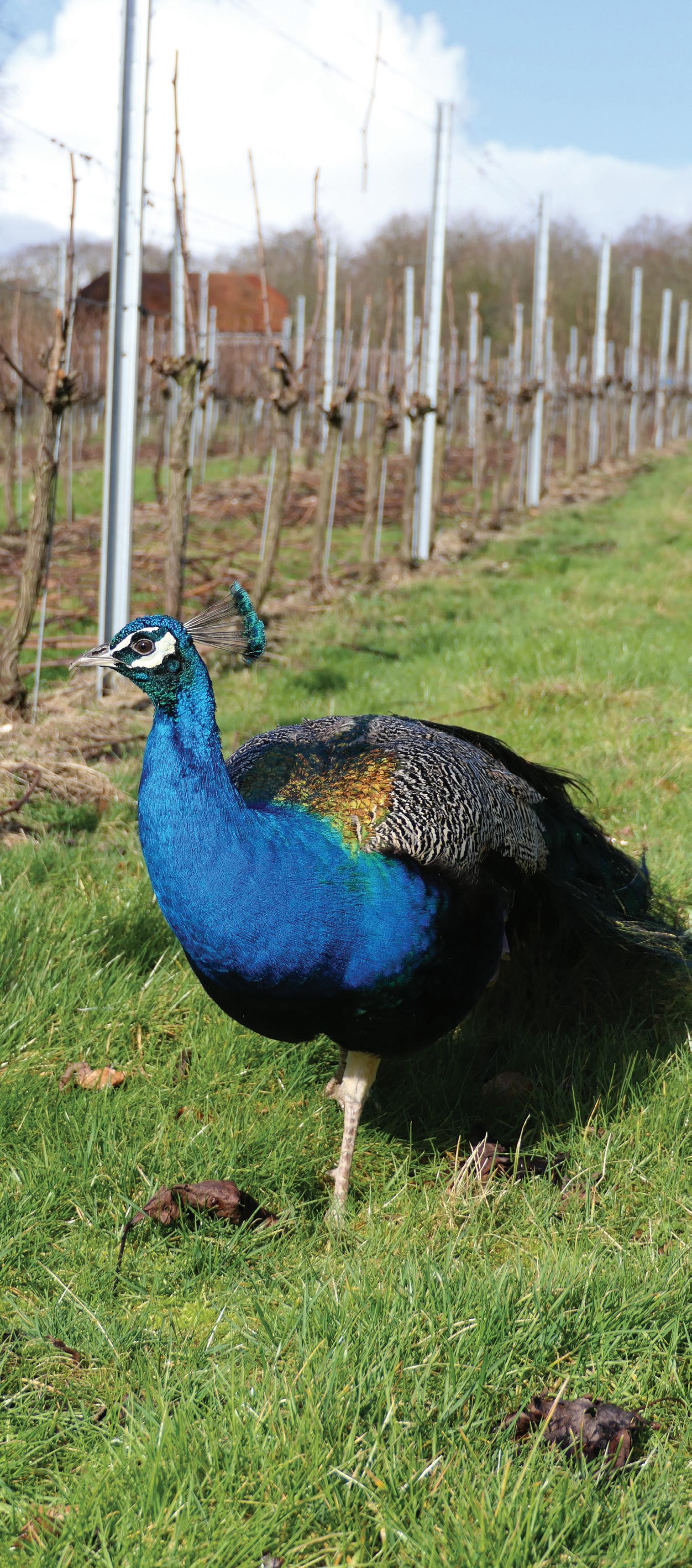
Progressive learning is a key foundation principle at Bluestone Vineyards and ensuring the team have the knowledge and confidence to progress the vines and the wines with the latest ideas and techniques

<< At Bluestone Vineyard there is such a connection to the soil it is not a surprise to learn that Nat is eager to implement regenerative agricultural principles. “Soil is a living thing. It is about finding the right tools to create the right system that still allows latitude, for example utilising the rows in a way that can build both soil health and increase the quality of the grapes and be profitable,” he said with enthusiasm. Nat has done extensive reading and research around the subject and highlights that it was the book Dirt to Soil by Gabe Brown that first peaked his interest in regenerative agriculture. Nat and Toby have used a three acre plot at the vineyard to trial different techniques including organic sprays. “I want to build a progressive forward movement,” said Nat.
Since Bluestone Vineyard planted vines in Wiltshire the county has become the
We regularly find relics dating from the Stone Age to Roman Times such as flint arrow heads or remnants of pottery”
home of several other large vineyard operations. This is rather poignant as there is significant evidence that Bluestone Vineyard is part of an ancient trading route. There are three parcels of vines at Bluestone and these are aptly named Iron age, three acre and Roundhouse. It is in Roundhouse that there is evidence of an Iron age settlement. “We regularly find relics dating from the Stone Age to Roman Times such as flint arrow heads or remnants of pottery and just before the vines were planted we had Time Team at the site,” said Nat. At this point in the conversation as we are walking through the vines Nat spots a rather interesting pottery remnant that is probably roman – he quite
literally found the proof of his statements at our feet.
Surprising finds on the vineyard are not limited to ancient relics. “Once we found a naked man in the vineyard,”said Nat with a laugh. “He had been involved with some sort of Solstice celebration at the nearby World Heritage Site of Stonehenge and somehow found his way into the vineyard. When he saw us first thing the next day he ran off through a patch of stinging nettles,” he added. “We never saw him again, and fortunately that was the only time that has happened.” There cannot be many vineyards in the world that have found naked people on the same site as ancient arrowheads and roman pottery.

Focussing on premium sparkling wines there is now a Premier Cuvée, a Premier Rosé and a saignée Sparkling Rosé
The wines are made at Hambledon and Nat explained that the relationship works really well. “Like us Hambledon are quality driven and they only have a small number of contract clients,” explained Nat. “Felix at Hambledon is very passionate about what he does and very happy to try new things such as fermenting some of the wines in concrete eggs,” added Nat. In 2023 Bluestone were able to get six blending options from the 20 tonnes of fruit that was harvested. “I love it when it comes to choosing the blends because the whole family come together and each person shares their opinions about the wines,” said Nat with a warm smile. Before the vines were producing fruit and whilst the first vintages were on lees Bluestone bought in fruit to make wine. This can be a controversial strategy but Nat said: “This has been an important part of the learning journey for us as it means that we are better placed to know what we want from the wines we make from our estate fruit.” Focussing on premium sparkling wines there is now a Premiere Cuvée, a Premiere Rosé and a saignée Sparkling Rosé. The wines use a little reserve wine but the focus is to reflect the vineyard and therefore the wines are predominantly vintage wines. The aim is to have wines that embrace seasonal variation.
The Premier Cuvée was first produced from estate fruit in 2019 with three years lees aging and 6g of dosage the wine has 48.5% Chardonnay, 33% Pinot Noir and 18.5% Pinot Meunier. “The Premier Cuvée is our best seller because it is familiar but the complexity of the Rosé surprises people,” said Nat. The 2021 Premier Rosé spent 24 months on lees and was disgorged in June 2024. With 8g dosage the rosé has 60% Chardonnay 27% Pinot Noir and 13% Pinot Meunier. “The wines go through full malolactic conversion as we feel this benefits the fruit and makes the wines even more food friendly,” he added. There are a lot more wines to come including a Blanc de Noirs which is patiently waiting to be ready for release. <<
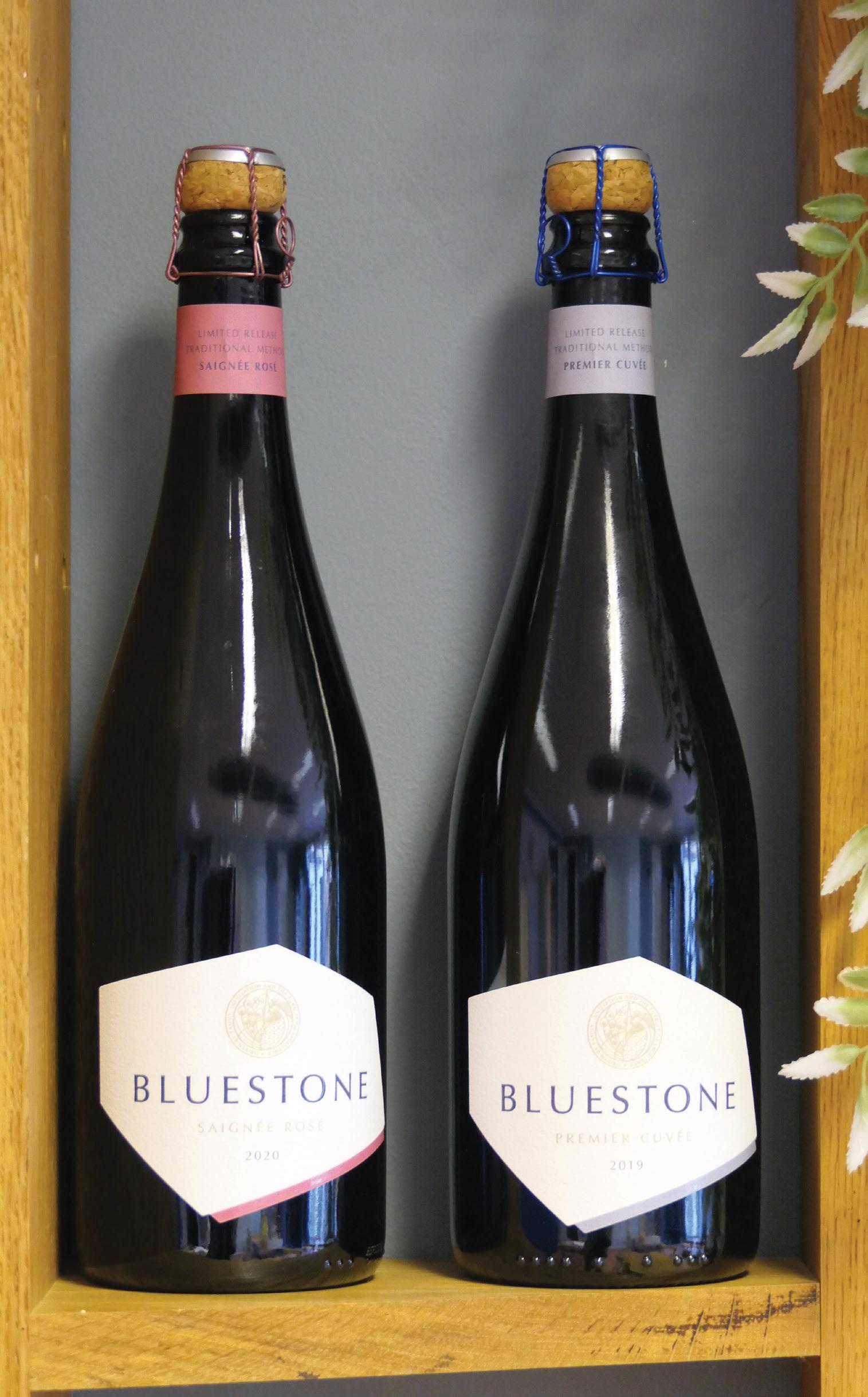
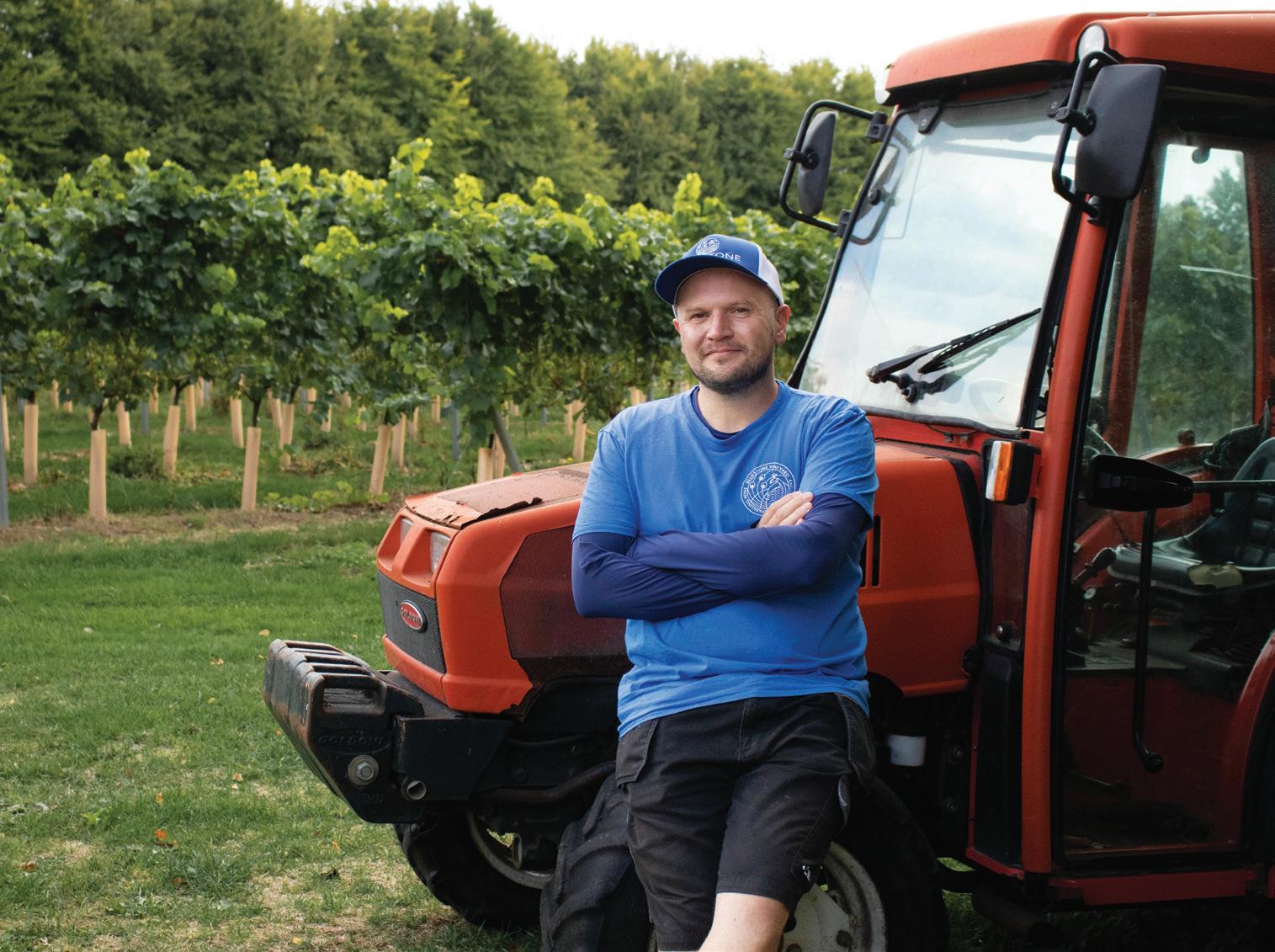




The Bluestone Vineyard team launched a rebrand in 2024 “as a celebration of the wines produced from estate grown fruit,” explained Emily McConnell who is married to Nat. There has been a lot of thought put into the branding including ice bucket friendly labels. The foils have been removed which is better for the environment but also give the bottles a sleek modern look. “We spent years thinking about exactly what we wanted the wine label and bottle to look like, we included winemaking details on the labels so that they would appeal to people who really enjoy the experience of wine and we wanted the back label to be of the same quality and as important as the label on the front,” said Emily. The details included on the label give a transparency to the winemaking which is quite enticing and there is a QR code that gives a link to even more interesting facts about the winemaking journey.
The wine labels have a wonderful colour scheme currently with subtle shades of blue and pink to denote the different wines. “The colour palette was taken from
The Bluestone Vineyard team launched a rebrand in 2024 “as a celebration of the wines produced from estate grown fruit”
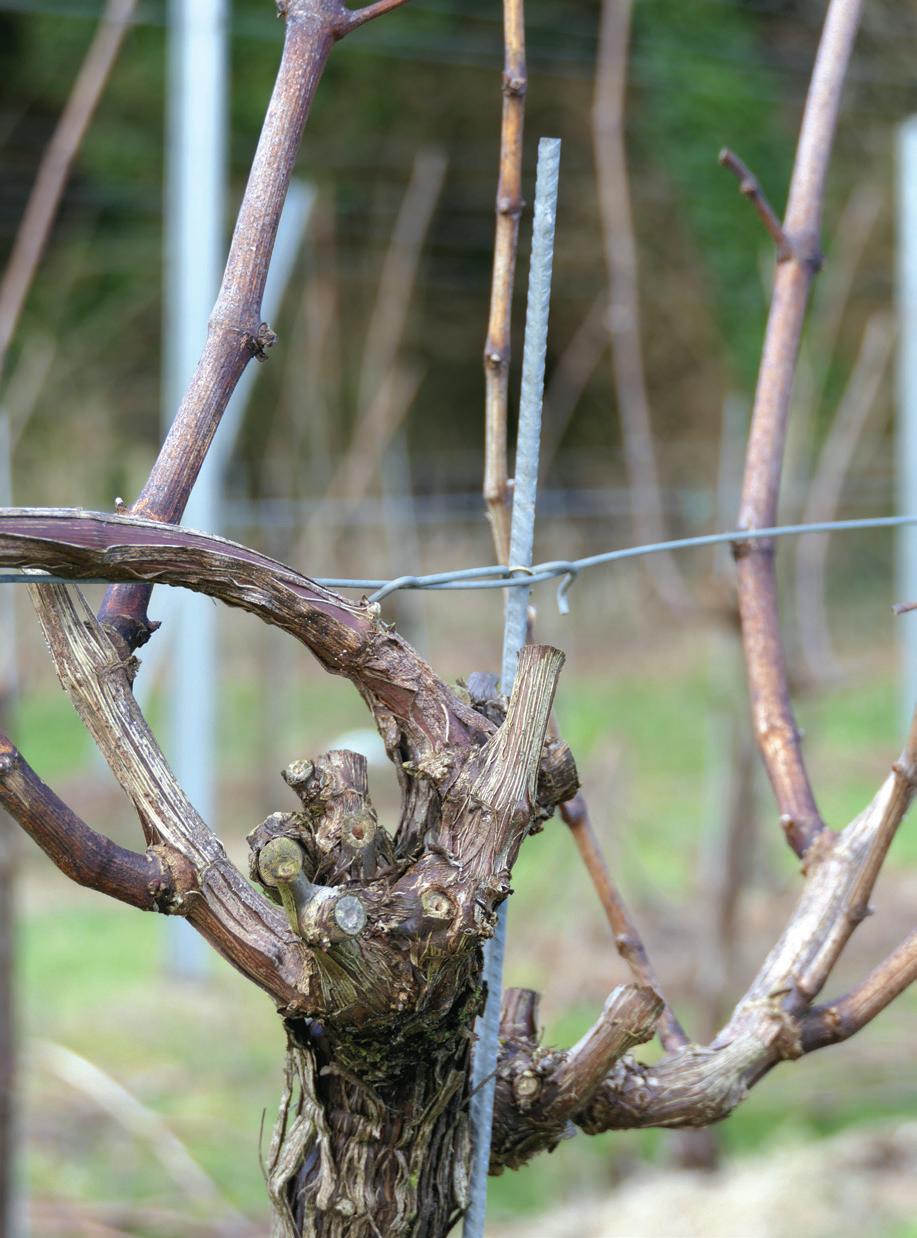

the feathers of the peacocks that roam the site,” said Nat. As with everything that has been done at Bluestone there is a real sense of not simply looking but really seeing the intricacies and the beauties of grape growing and winemaking. Of course peacock feathers have a vast array of beautiful colours that will enable a whole host of wines to follow.
The wines are sold locally via the on-trade and through external events such as the Christmas Market at Bath which takes place across several weeks in November and December. The vineyard also has its own modern tasting room which offers a range of events such as a bouquet arranging event for Mothers Day. On Saturday and Sunday (from April through to October) visitors are welcomed to the Signature Tour which is a structured 1.5 hour tour and tasting. In the afternoon there is an alternative event aptly entitled sip and stroll. “We wanted to offer something for those people who wanted to take a casual approach to wine and were looking for something a bit different,” explained Emily. The vineyard is ideally situated to
The entire experience at Bluestone Vineyard is one of gaining knowledge and understanding
introduce many national and international visitors to the Wiltshire wine scene and has entertained overseas tour groups, shining a spotlight not just on local wines but local artisan meats and cheeses as well. “It is about creating a market, one coach load at a time,” said Nat poetically.
The entire experience at Bluestone Vineyard is one of gaining knowledge and understanding. Recognising that true excellence is a marathon and not a sprint. The team at Bluestone Vineyard have demonstrated incredible patience, allowing everything to develop at its own speed, from the vines and the wines through to the tourist experience. On a site with thousands of years of history it is reassuring to know that the future is also secure in the hands of the dedicated and passionate Bluestone team.
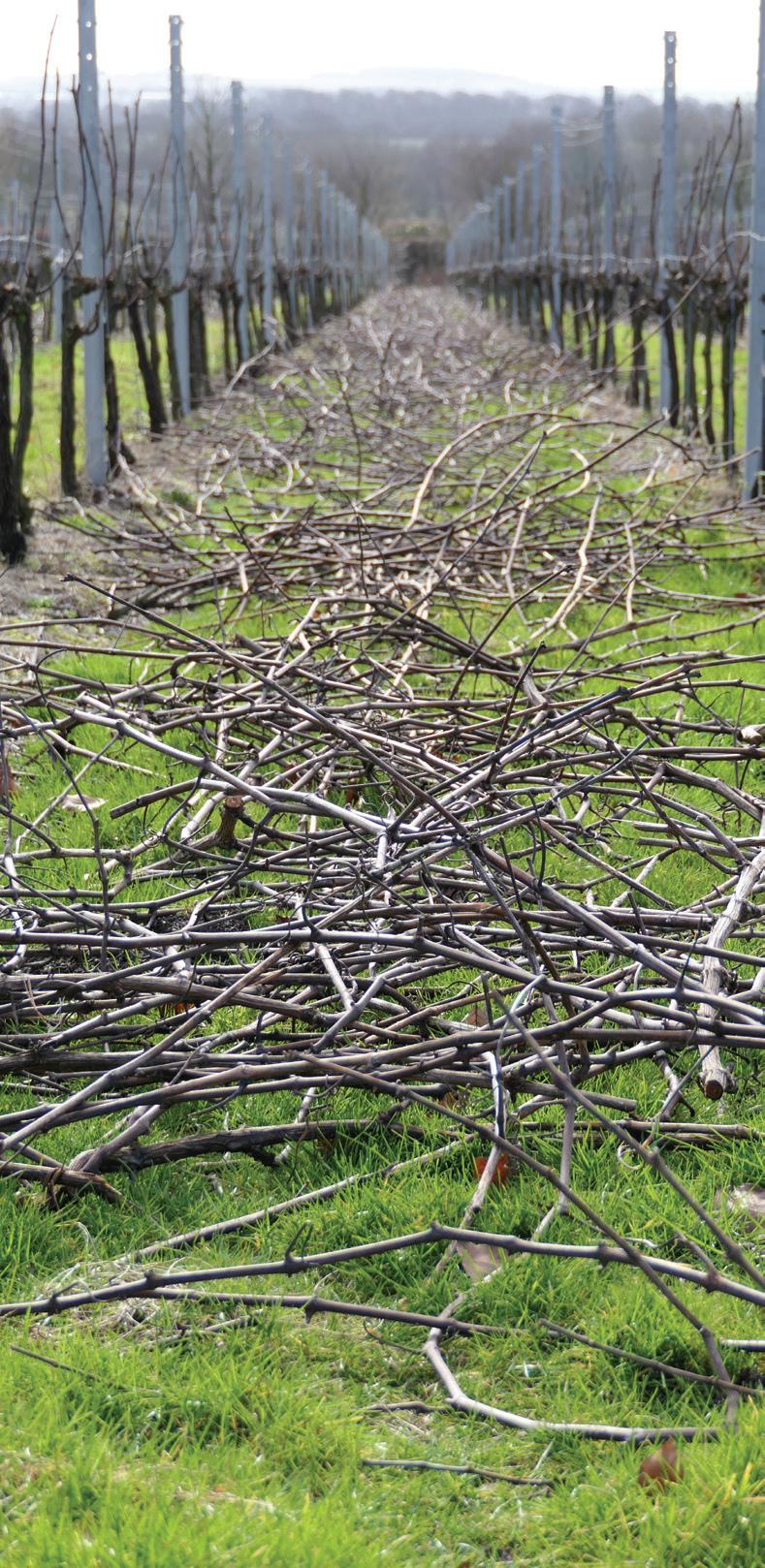
Late frost is a perennial risk to vineyards, and one that, ironically, may be being made worse by the changing climate, writes Will Robinson an agronomist with Hutchinsons.
There is little doubt that UK weather patterns are becoming more erratic, with winters generally becoming milder and wetter, and summer heatwaves increasingly extreme. Although hard winter frosts are less common, we are finding the frost risk period can extend much later than it used to.
Traditionally, mid-May was often regarded as the cut-off for frost risk, but that is not the case anymore; frosts in late May, or even into the start of June are possible. Last year was a case in point, when the warmest May on record, was followed by a cold blast of Arctic air in early June.
The risk from late frost is obviously made worse when mild winter conditions lead to early bud burst. Once vines have green tissue, any temperatures below freezing will start to damage young shoots as cells freeze and tissue dies. The extent of damage depends on the growth stage at the time, with some research suggesting that vines at bud burst will suffer 50% losses at -2.2°C, however by the four-leaf stage, the temperature only has to drop to -1.1°C to result in the same level of damage.
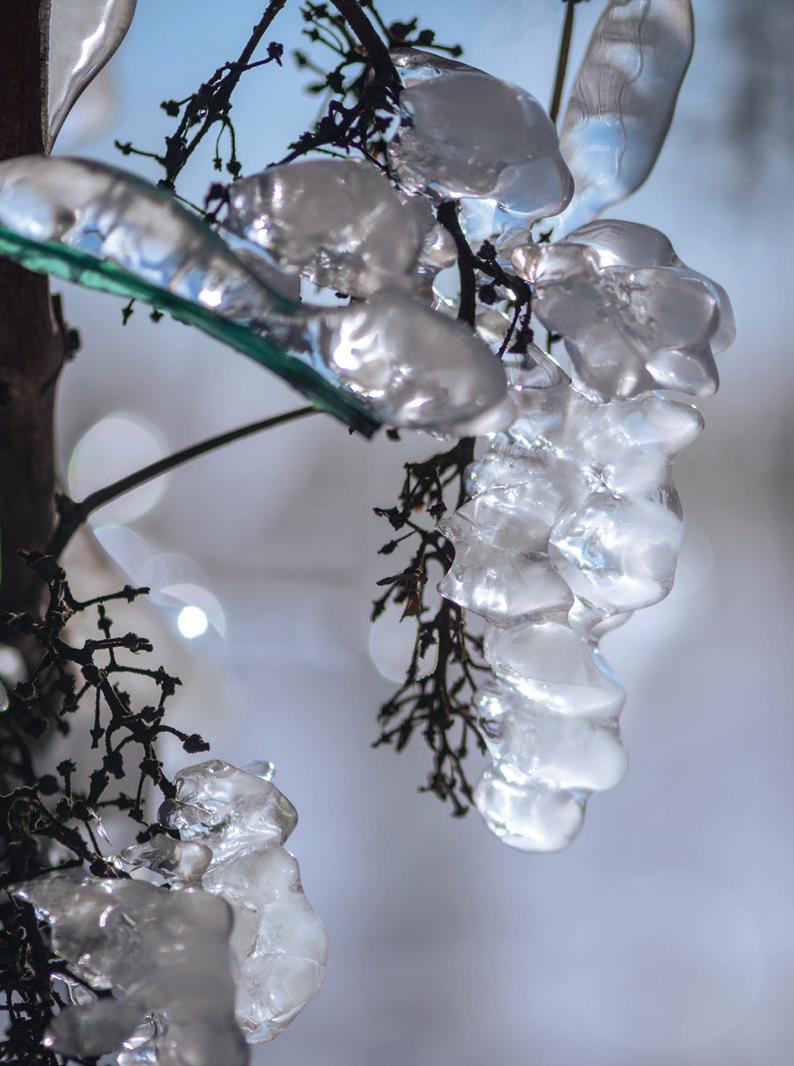
While experienced vineyard managers will be well aware of the frost-prone areas and how to protect them, the potential risks may not be quite as well identified on some newly planted sites.
Last year’s high disease pressure clearly highlighted some vineyards where the land is perhaps not ideally suited to grape growing. One reason is often linked to poor airflow around the site, which increases both disease and frost risk.
Problems may occur, for example, where growers have planted on a slope, but have not cut out any frost drains in the hedge at the bottom of the slope, to allow cold air to move away. It is a very simple action that makes a big difference, especially if there is running water at the bottom to help draw cold air away.
Frost moves very slowly, but as long as it is moving, air will be mixing. Anything that causes frost to slow down and bank up, increases the risk of damage.
It is why it is best to plant vines up and down the slope rather than across it, to allow cold air to move freely down the alleyways. Similarly, tightly mowing the vegetation between rows and keeping the undervine area weed-free and uncultivated will further improve airflow.
It is also important to recognise that mounds of compost in the undervine strip and even cultivated earth can also slow down frost drainage, so a herbicide strip is generally best, maintained with glyphosate on vines over four years old, or carfentrazone-ethyl on younger vines.
Aside from employing frost mitigation

measures such as bougies (candles), or mechanical heaters/fans, there are some other steps growers can take to reduce the potential frost impact, although none offers complete protection against more severe late frosts.
◆ Delaying tying down canes – metal wire conducts cold, therefore buds touching the wire are likely to get frosted first. Avoid this by delaying tying down
◆ Leave sacrificial canes – leaving extra canes upright provides some replacements for any canes that were tied down and damaged by frost.
‘Highpoint principle’ also means that buds at the top of upright sacrificial canes will burst first, so by pruning those out, it can delay bud burst in the others and therefore reduce the risk of them being damaged by late frost. This extra pruning is however, very labour intensive
◆ Boost natural frost tolerance by increasing the concentration of sugars and salts within buds. This can be done with a biostimulant feed such as Maxicrop, or Lalstim Osmo. The latter is the purest form (96%) of glycine-betaine available. This osmoprotectant increases cold tolerance, reducing the percentage of tissue that dies during frost episodes, and promoting better recovery of coldinjured plants. The best effect is achieved from application 72-36 hours before the event, but there is no panacea – if the frost is really severe in terms of depth or duration, tissue death is the most likely outcome, unfortunately.
◆ Reduce ice-nucleating bacteria on green vegetation and woody material
◆ Monitor frost risk closely to avoid getting caught out – Omnia features a 10-day frost risk forecast and email notifications.
Plumpton College is thrilled to announce the launch of the National Competency Framework (NCF). The NCF represents a significant milestone in enhancing standards and professional development within the UK wine industry.
The NCF is the result of an extensive collaboration between Plumpton College, the Vintners’ Company and industry professionals. Endorsed by Wine GB, this is a comprehensive framework designed to define essential competencies and skills crucial for effective employment across key sectors of the UK wine industry. By setting clear standards and pathways for progression, the framework aims to cater to diverse skill levels, from entry-level to advanced principles across vineyard, winery, and cellar door practices, with the goal of
promoting excellence and professionalism.
Sam Linter, Director of Wine at Plumpton College, commented: “The establishment of the National Competency Framework represents a strategic step towards ensuring the long-term success of the UK wine industry. We recognise this future growth is very dependent on attracting, re-training, and developing a skilled workforce.” Sam hopes that the NCF will “inform a systematic approach to a new National Wine Training Programme.”
Looking ahead, Plumpton College is committed to expanding course offerings to regional locations and exploring online education formats to enhance accessibility and quality of wine education. Additional courses are set to be introduced in the upcoming years to meet industry demands.
The first National Competency Framework (NCF) for the UK Wine Industry has been launched following development by Plumpton College. Scan the QR code to read more.

Maddie has a keen interest in premium grape production, English terroirs, and old vine management. Having been raised on a family fruit farm in Kent, she knows how key a strong grounding is to sound fruit growing. After studying Crop Science in the UK, Maddie went on to carry out research in Australia at CSIRO before coming back to work at East Malling Research. In 2017, Maddie went on to become a qualified agronomist.
Early in 2018 Maddie joined Nyetimber, rising to become one of the company’s viticulturalists, responsible for sites in Kent, Sussex and Hampshire. She led both the company’s agronomy and research teams with a primary focus on quality, pushing viticultural practices forward as the company scaled. Now at Plumpton, Maddie is excited to bring both her technical and practical viticultural knowledge to the role.
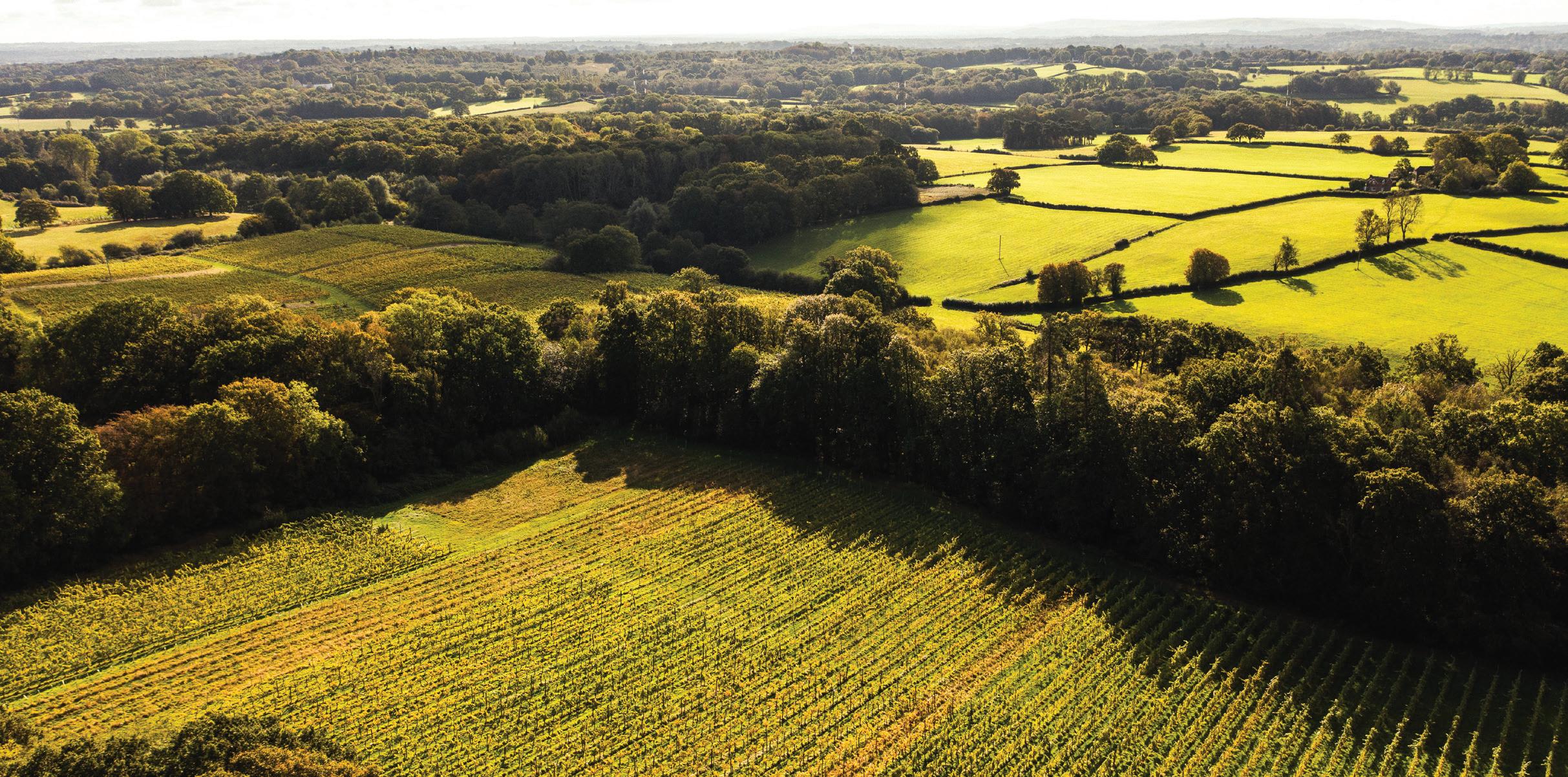

The UK wine industry is growing. Climate change is resulting in a rapid expansion of English and Welsh vineyards, and this expansion is predicted to continue over the coming decades. Although this will generate significant opportunity, wine production comes with a challenge – large amounts of grape waste are generated. William Sullivan, biochemical researcher working at the University of Kent, has a vision to turn this nutrient rich waste into new foods with health benefits.
In the United Kingdom there are currently 4,400 hectares of vines planted, and WineGB projects a further 3,200 hectares will be planted by 2032. Even after this projected planting an additional 26,100 hectares of land are estimated to be suitable for vines in the UK, and with warmer temperatures resulting from climate change the wine industry in the UK is expected to continue to expand over the coming decades.
The UK experienced the fastest growth in vineyard area out of major wine producing countries at 6% in 2023, and the greatest increase in wine produced at 77%. These increases are being driven by both domestic operators and overseas winehouses purchasing land in the UK as a hedge against climate change.
In 2022 9,336 tonnes of grapes were produced for wine, resulting in 12.2 million bottles of wine. However, this also produced a large amount of solid waste. Being 584 tonnes of grape stems, and 2,344 tonnes of grape pomace. Alongside vine prunings from the maintenance of the vines.
Waste resulting from wine production is only going to increase given the rapid expansion of the viticulture industry in the UK. Currently the valuable, beneficial compounds within grape waste aren’t being extracted, and are going to waste.
There are health benefits linked to the consumption of red wine, such as a lower risk of dementia, and increased cardiovascular health. These benefits derive from the action of a class of
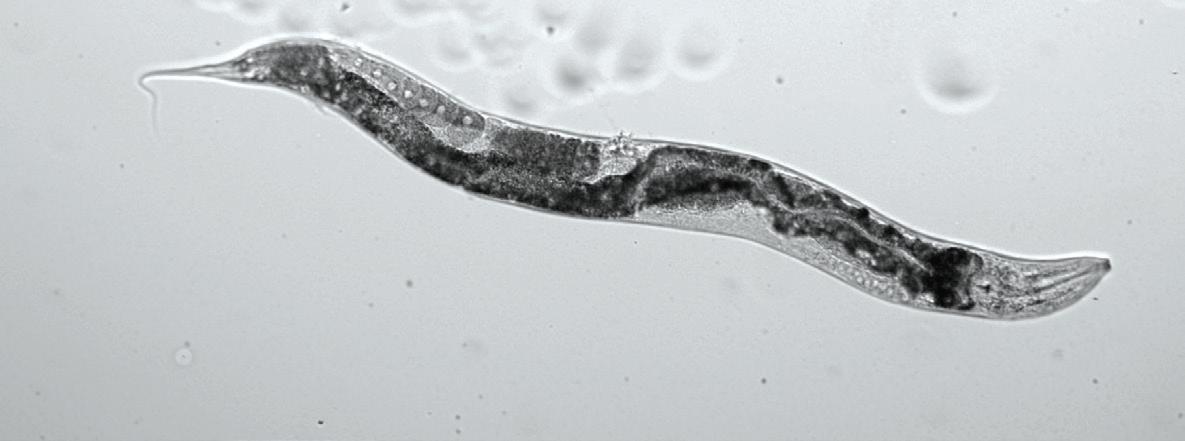
polyphenolic compounds called ‘proanthocyanidins’, which are present in red wine.
Procyanidins inhibit the synthesis of the signalling molecule endothelin-1, meaning endothelin-1 isn’t binding to endothelin receptors. The activation of endothelin receptors lead to vasoconstriction, resulting in an increase in blood pressure. This means that due to the action of the proanthocyanidins the endothelin receptors aren’t being activated, causing blood pressure to remain lower overall. Resulting in the aforementioned health benefits. Grape pomace is rich in polyphenols, which are strong antioxidants. Antioxidants can reduce the risk of certain types of cancer. This is by antioxidants scavenging free radicals, preventing the free radicals from causing DNA damage. Antioxidants are also implicated in lowering risk of heart disease, as well as promoting digestion, by supporting beneficial constituents of the gut microbiome.
9,336 tonnes of grapes
12.2
2,344
584 tonnes of stems
Click the QR code to take part in the survey or visit https://universityofkent.qualtrics.com/jfe/form/SV_bfv1wqTq2ReUCZo
By consuming products derived from grape pomace the health benefits of the polyphenolic compounds can be received, without the detrimental health impacts linked to consuming alcohol.
Currently grape pomace is often composted on site being spread locally, sent away for industrial composting or anaerobic digestion, both of which cause the producer to incur transport costs. All three of these options waste the valuable health benefitting compounds present in the grape pomace.
Some wineries such as Lympstone Manor in Devon, use a small amount of their grape pomace to flavour gin. Grape waste is also now being used in some cosmetics, because of its antioxidant properties due to the high polyphenol content.
Westwell Vineyard is providing grape pomace to the cosmetics company Pelegrims. Pelegrims is producing cosmetics enriched with polyphenols which have been extracted from the waste grape pomace, valorising the waste into a component of a marketable product.
The aim of my project is to contribute to the development of new food products, made from viticulture waste which will have a positive effect on the health and lifespan of humans.
In the bioscience labs at the University of Kent, based in Canterbury, I am conducting research into the potential health benefits of compounds present in grape pomace. This is being carried out using the model organism C. elegans, which is a nematode worm, with 83% of its proteome (complete set of proteins expressed by an organism) having homologous genes in humans.
I have been collaborating with Defined Wine and NIAB to source grape pomace, and I have samples of Pinot Noir, Pinot Noir Précoce, Pinot Meunier and Divico, from the 2023 and 2024 harvests.
I am also using gut models to investigate the effect of grape pomace on the gut microbiome, and how the polyphenolic compounds in the grape pomace are metabolised, and how the metabolites impact the gut microbiome.
Alongside the biochemistry aspect of my project, I am also investigating the potential uptake of methods for the valorisation of grape pomace waste by the viticulture industry. And measuring consumer desire for a product such as cereal bars fortified with extracts of grape pomace, or the inclusion of grape pomace extracts in smoothies or protein shakes and to identify potential price points of such a product.
I would greatly appreciate it if you would take a few minutes to fill in my survey regarding your grape pomace waste, and your willingness to allow this waste to produce a value-added product.
The purpose of this survey is to identify what is currently being done with the grape pomace waste, and whether there is interest in the industry to valorise the waste, or if alternative uses have already been considered. As well as if the industry sees the potential valorisation of their waste as something which could potentially add value to their brand or pique the interest of consumers.
The aim of this survey is to form part of a report which will be able to help guide the industry towards economically and environmentally positive valorisation solutions for viticulture waste, which would be beneficial for the viticulture industry as well as consumers.
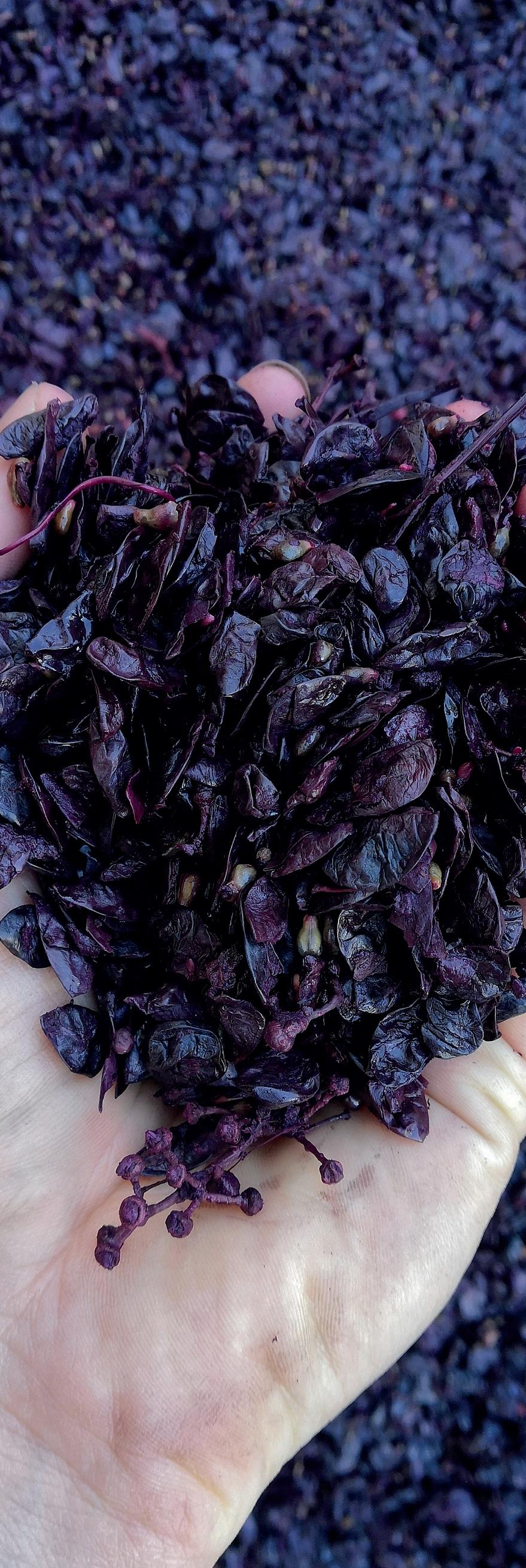

Owning a vineyard often begins as a romantic dream, but turning that dream into a thriving, profitable business requires strategic thinking from the outset writes Kate Davidson of Athena Strategic Thinking Ltd.
Success in this field isn’t just about buying land and planting vines – it’s about planning for the long haul. So, where should you begin?
Begin by adopting a “mountain top” perspective, where you can see both the near and far horizons. Think about your destination: where do you want your business to be in five to ten years? Taking the time to explore options and validate your ideas with others is essential to ensure your vision is both inspiring and achievable.
With a clear destination in mind, you can build a compelling vision for your vineyard. This vision, shaped by your story, values, and unique selling points (USPs), will form the foundation of your brand and business value.
Ask yourself:
◆ Who will your customers be?
◆ What are they looking for and what do they need?
◆ How will you differentiate yourself?

Your proposition will evolve over time, but early strategic thinking is crucial. For example, the type of wine you aim to produce will determine the grape varieties you plant, which in turn influences where you purchase your vineyard, considering soil types and drainage conditions.
For smaller vineyards, direct-to-consumer sales, such as the “cellar door” experience, are key. Invest in creating a welcoming, attractive, or innovative tasting space where customers can connect with your brand and purchase your wines.
Beyond wine sales, consider additional revenue streams to diversify your business. Visitor experiences are becoming an essential part of a vineyard’s offering. Beyond wine tastings and lunches, what unique experiences can your vineyard provide? Could you partner with local food producers or artisans to showcase regional specialties?
With your vision and proposition in place, shift your focus to defining objectives for your strategy. Identify three to five key goals you want to achieve and establish measurable key results to track your progress.
Make it a habit to review your progress quarterly as the seasons change, accounting for your evolving external context. Staying flexible and responsive will help you stay on track.
Even as you begin, it’s important to consider your eventual exit strategy. Are you building a family legacy to pass on, or are you planning to sell the business? Understanding your long-term intentions will inform your decision-making at every stage.
Too often, aspiring vineyard owners leap into planting without a clear strategy, which can lead to costly mistakes. Rushed decisions may result in financial losses, restricted growth opportunities, or missed chances to maximise your land’s potential. A wellthought-out strategy reduces risks and ensures you’re set up for success from the start.
A new and modern service from Vine Care UK.
The term ‘moving with the times’ is banded around an awful lot these days but when we break that term down, what does that actually mean? To some it might be the focused implementation of better technologies, a digitalisation of a previously clunky system or to others a way of improving efficiency of an otherwise defunct practice. The Australian business woman and author, Catherine De Vrye famously said that the six most expensive words in business are ‘We’ve always done it that way’, a fair and valid point worthy of consideration
We are fortunate that in the UK our fledgling wine industry is not overshadowed by centuries of tradition or shackled to an antiquated code of practice - we are young, nimble and forward thinking. So as we continuously evolve, it is pivotal that we indeed keep ‘moving with the times’ to improve our business efficiency through sustainable and cost friendly practices. Some vineyard operations are fixed and non-negotiable, pruning being a perfect example, but what if the advice and
guidance you receive from a consultant could be stream-lined and made more efficient? What if you could receive the same or a better level of service for a fraction of the cost? Surely that is a fair and valid point worthy of consideration too.
Here at Vine Care UK we have proudly launched our new Remote Vineyard Consultancy (RVC) package. The theory behind this is straightforward, it’s moving with the times, increasing efficiency and decreasing costs.
Traditionally, an in-person visit from a consultant would occur every ten to fourteen days during the growing season. This is particularly expensive as not only is there the cost of the consultant’s time, there is also the cost of travel and fuel to be factored in. Dependent on the year, the consultancy costs could fluctuate wildly but with our RVC package you pay a flat fee per annum, meaning that you can use the service as many times as you see fit with no hidden or fluctuating costs.
Technology is our friend as modern camera phones are now so advanced that
minute detail can be captured and sent to us for interpretation. You can book a slot to have a real-time video conversation with us from within your vineyard during our assigned weekly clinic hours. We send out seasonal reminders to you to undertake certain tasks in the vines and give you the heads up when we see potential problems on the horizon. Fundamentally, you receive the same service from our RVC package as you would from an in-person consultancy visit, just with less cost, more flexibility and more efficiency. What’s not to like?
Vine Care UK deeply values its relationships with its clients and recognises the need to build strong partnerships so you will be assigned a dedicated Vineyard Manager as your main point of contact whilst having access to our combined forty years of viticultural experience. It is paramount to us that you speak to somebody who understands your overall ethos and philosophy to fruit production and can be by your side every step of the way. As Bob Dylan once sang, ‘the times they are a-changin’.
For more information about the Remote Vineyard Consultancy package:

Stephen Skelton’s excellent article in the December 2024 edition of this magazine raised important questions about regenerative viticulture – its definition, its impact, and the potential risks of greenwashing.
The Regenerative Viticulture Foundation (RVF) exists to support producers in transitioning towards regenerative practices, and we welcome the opportunity to provide further clarity on what regenerative viticulture is (and isn’t), why it matters, and how it can be applied effectively in UK vineyards.
Regenerative viticulture is a science-led approach that works with nature to improve vineyard health, climate resilience, and biodiversity. Unlike organic or biodynamic certifications, regenerative viticulture is not a prescriptive set of rules but a principles-based framework that allows growers to tailor practices to their specific environments.
Stephen pointed out that regenerative viticulture is sometimes used as a marketing term without clear parameters. We agree that defining regenerative viticulture is critical, but also that its application may vary depending on context, which is why we base our understanding on peer-reviewed science, practical application, and measurable outcomes wherever possible. In an era of rising input costs and unpredictable weather, regenerative viticulture offers economic and ecological benefits, improving soil health and reducing reliance on external inputs.
While there is no universal legal standard, the RVF has identified 16 key practices specific to viticulture, built on the widely recognised five principles of regenerative agriculture.
These 16 practices focus on:
◆ Maximising soil health through minimal disturbance and organic matter inputs.
◆ Encouraging biodiversity by integrating hedgerows, cover crops, and natural pest management.
◆ Reducing chemical reliance without compromising vine health or yield.
◆ Improving carbon sequestration through healthy soils and plant systems.
◆ Enhancing vineyard resilience to climate extremes and disease pressures.
Regenerative practices adapt to local conditions – a key advantage for UK growers working with a cool, maritime climate.
Stephen raised a valid concern: could regenerative viticulture become another buzzword, applied without substance? Absolutely – but only if it is misused. At RVF, we believe that the best way to prevent greenwashing is by focusing on measurable improvements and transparent peer-to-peer engagement.
We remain agnostic on certification because regeneration is a continuous process, and we support growers at all points on that journey. That said, certifications can play a role in providing transparency and market access. Some distributors already require regenerative certification, and frameworks like Regenerative Organic Certified (ROC) are emerging, some of which require

organic standards, and others which are specific to viticulture or certain environments. However, for most growers, demonstrating progress through real data – such as soil organic matter levels and biodiversity improvements – is more meaningful than a label alone.
Stephen questioned whether regenerative methods, particularly cover crops and livestock integration, are truly viable in UK viticulture. In reality, the UK’s unique climate makes certain regenerative practices especially effective.
Unlike many warmer regions, UK vineyards can maintain 100% ground cover year-round. Carefully selected cover crops reduce reliance on synthetic fertilisers, improve soil structure, and enhance biodiversity. Tractor-mounted strimmers and techniques like ‘mow and throw’ (using side discharge mowers to suppress undervine weeds) can reduce the need for herbicides.
Stephen points out that the UK has a high degree of fungal disease pressure, but regenerative practices differ from organic ones in that ‘regen’ balances the competing pressures and is flexible if a producer decides that, in extreme circumstances, one systemic application is less damaging to their soils than multiple copper applications. The same flexibility applies to the herbicide versus ‘no-till’ debate. While this flexibility in turn can add confusion, it also allows producers to adapt their practices to their specific circumstances, while gradually moving towards more widespread adoption of as deep an interpretation of ‘regen’ as possible.
2. Livestock integration
Sheep in vineyards? It’s not just a trend – it’s a proven way to reduce mowing costs, improve soil fertility, and support biodiversity. While high-trellising for year-round grazing may not yet be common in the UK, rotational grazing post-harvest is growing in popularity. Stephen knows from experience how managing sheep in vineyards has some downsides, and takes experience and skill to manage, but support with this is available: the Pasture for Life programme is actively exploring how to connect vineyards with livestock farmers.
3.
UK vineyards have long used hedgerows and windbreaks – but new agroforestry approaches go further, integrating trees and shrubs within vineyard blocks to improve water retention, create habitat for beneficial species, and support mycorrhizal fungal networks. Sustainable Farming Incentives (SFIs) offer payments for hedgerow planting, making this an economically viable approach.
The Regenerative Viticulture Foundation (RVF) is a global non-profit dedicated to supporting growers in their transition to regenerative
practices. While our scope is international, our UK team and trustees ensure that our research, guidance, and community initiatives are directly relevant to British vineyards.
◆ Events and workshops – RVF is hosting a one-day Regenerative Viticulture Workshop in collaboration with WineGB (subject to ticket availability). Several open farm visits will also be held throughout the year. Sign up to the RVF mailing list to be kept informed.
◆ Training and networking – Trustee Justin Howard-Sneyd runs a two-day Introduction to RV course at West Dean annually. (www.westdean.ac.uk/short-courses/s2d35871-introduction-toregenerative-viticulture). There is also an active WhatsApp group for growers trialling regenerative practices.
◆ Resources and guidance – Sign up for the RVF newsletter for updates on new guides, research, and vineyard trials.
Regenerative viticulture is not about ideology, but about practical, evidence-based solutions. Stephen Skelton’s concerns about clarity and accountability are well-placed, and we agree that meaningful data and transparency must guide this movement forward. The RVF remains committed to supporting UK growers with real knowledge, practical tools, and a thriving community – helping to ensure that regenerative viticulture is more than just a trend, but a lasting shift towards healthier vineyards and a more resilient wine industry.
A recent RVF and NIAB study published in Oeno One analysed scientific evidence on regenerative viticulture. Key findings include:
◆ Compost application boosts soil nutrients, improves water retention, and enhances grape yields.
◆ No-till farming increases soil carbon sequestration.
◆ Cover crops improve soil structure, reduce compaction, and enhance biodiversity. They also provide cooling effects, which may be beneficial as climate patterns shift.
◆ Natural predators such as bats and birds contribute to vineyard pest control. Sheep and geese help manage weeds while reducing soil compaction compared to tractors. While many regenerative practices are well-supported by research, further studies are needed to assess bio-stimulants, biological control agents, and their longterm impact on wine quality.
Grapes are at the heart of what we do and understanding them is at the heart of good wine-making. Vineyard magazine gets back to basics with an up close and personal look at the grape bunch this month.
First, let us consider the anatomy of the grape cluster. The bunch is attached to the vine shoot by the peduncle. The length of the main stem below this, after it begins to branch off, is the rachis. Where prominent laterals come off the rachis stem at the top, the cluster may be described as shouldered. If the first lateral is large and creates its own cluster, the bunch is winged.
Extending off from the rachis’ laterals are the pedicels or cap stems. These are where the individual flowers, and later the fruit, are attached to the cluster. The framework of the rachis can typically account for somewhere between 2% and 8% of the final weight of the grape bunch when it is ready for harvest.
Most cultivated grape varieties have flowers which contain both female and male parts, so they are capable of self-pollination. Each flower growing on a pedicel can be pollinated and can produce an individual grape.
The ovules are only briefly receptive after bloom. In areas with the highest temperatures fertilisation occurs within 12 hours. In UK temperatures it is likely to take around 48 hours. When the temperature is too low, the pollen tube may grow so slowly that fertilisation does not occur at all.

The pollinated flowers become grapes quickly. They are arranged on the rachis with relatively large gaps between them which will be closed as the grapes grow and swell.
The overall cluster can vary in shape and size, depending on the variety of grapevine. They might be conical, sometimes with prominent shoulders, cylindrical, sometimes also winged or form a double cluster of roughly equal sizes.
Researchers working on intelligent harvesting techniques have found that the grape cluster provides a unique complication for the machine vision-based information perception technology upon which most methodologies rely. The inherent diversity and randomness of each bunch makes it difficult to “teach” the machine vision system to accurately identify them.
This non-standard nature comes from a number of factors. Peduncles may be obscured by leaves, or the fruit may be entangled within the peduncle and vine (as anyone who has hand harvested will know well!) There is also a difficulty when the target of a robotic harvester – the peduncle as the optimal picking point – happens to be a very similar colour to all of the plant material which surrounds it.
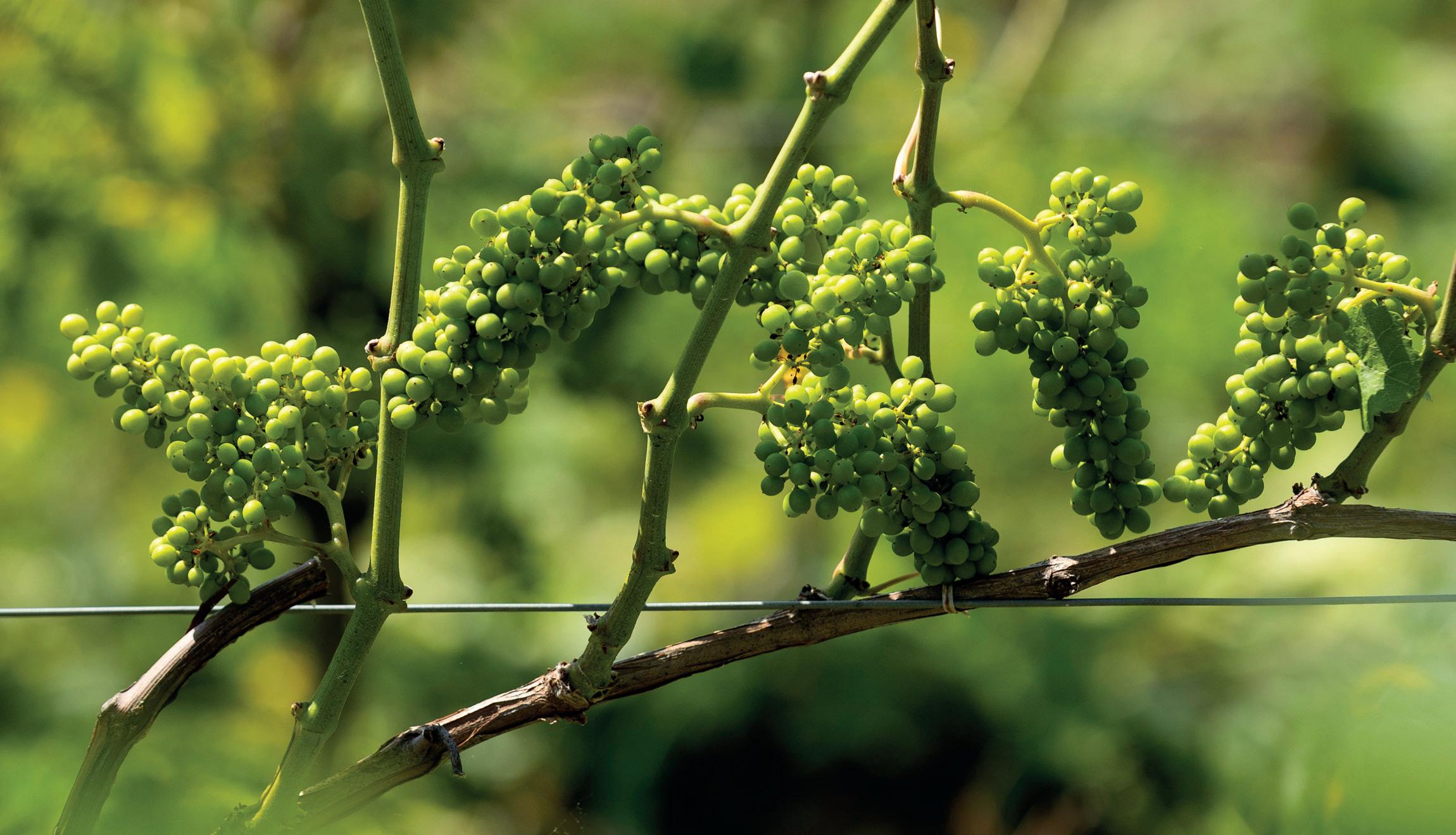
At the moment, research is trialling deep learning models that segment grape cluster peduncles visually from the surrounding environment. This still remains a significant challenge, as on average the peduncles are likely to represent less than 2% of any given image that the robotic harvester analyses. We will continue to monitor developments in this area as they happen.
There are two key stages in the development of a bunch of grapes. First comes the growth phase – the development of the cluster structure, flowering and fruit set. That is followed up by maturation of the berries.
Fruit set is a complex process. It can be quantitatively measured as the proportion of flowers that turn into grapes. On average, it might be expected to see a fruit set of between 30% and 50%, however this can vary from variety to variety.
For the process to happen smoothly, the vines look for a high light intensity, good temperature and access to the requisite nutrients and water. When those elements are not in balance, the fruit may not set well, leading to a range of issues. Ultimately, this process can be viewed as the plant self-regulating the crop. If it is not in good health, with access to all of the required inputs, the fruit will not set well to avoid additional strain on the plant.
Poor weather during flowering can lead to a number of issues with fruitset. When temperatures are particularly low, the flowers are less likely to open. A slew of rain during the short flowering window can also hamper pollination. This can result in an uneven fruit set and different sized berries that ripen at different times.
Millerandage, sometimes called ‘hen and chicken’, is one outcome of these weather-related problems during flowering. The vine produces normal berries with seeds in the same bunch as smaller berries with no seeds – those described as the chicken grapes. Grape seeds produce hormones that stimulate the berry to grow. Berries with the most seeds will be larger than those with none at all.
All of these grapes are able to ripen normally, but the smaller berries will ripen much later. The yield is impacted because it is difficult to achieve uniform ripeness across the clusters.
Coulure is another condition that leads to poor fruit set. It is also referred to as ‘shatter’. Here the bunch excessively drops ovaries and young berries, resulting in fewer berries per bunch being left to mature.
There is little that can be done to avoid these problems, since they mainly arise in response to the weather during the flowering period. To minimise their impact, it may be necessary to harvest selectively, making multiple passes to ensure that only fully ripened grapes are picked. While this is an admittedly labour intensive approach, it does ensure that only the best quality fruit is harvested.
Uneven ripening across the bunch may also be down to an imbalance of nutrients or water stress, particularly during the crucial time of flowering and fruit set. This issue can be exacerbated in areas with sandy soils, because of the inherently poor nutrient and water retention capacity of the soil.
The vine may also have entered the dormant season with low amounts of stored carbohydrate. This is likely to impact floral development in the following spring. A heavy crop the previous season, disease reducing leaf area or an early leaf loss in cooler autumns can all contribute to lower levels of starch being held in reserve by the plant.

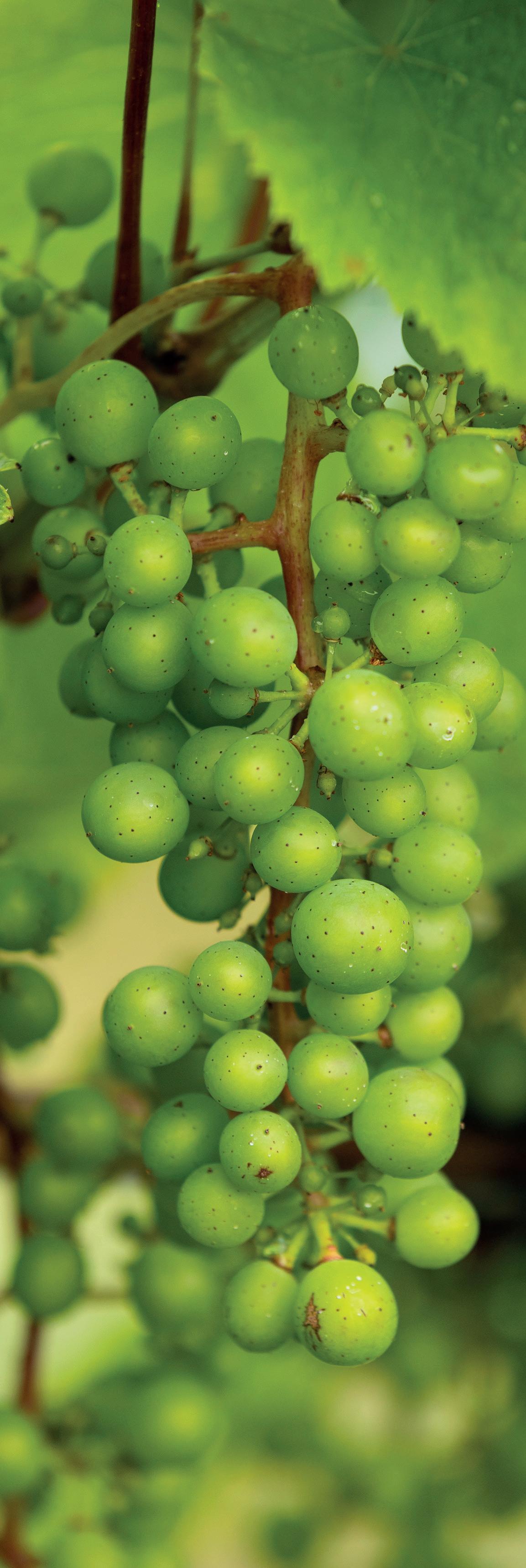
These factors are generally outside of the growers’ control, however canopy management can also play a role in giving each bunch the optimal chance of ripening evenly across the row. A thick canopy of leaves may create a microclimate that shields some berries from sunlight and airflow. Those grapes would have a delayed development compared to those that are more exposed. Pruning and leaf removal is the critical fix for giving each bunch access to adequate light and air.
The density of the grapes within a bunch is known as bunch compactness. The more compact a cluster is, the more susceptible the berries are to pests and diseases like Botrytis. A dense cluster may also be more likely to experience uneven ripening which can impact on yield and wine quality.
The inner part of a compact bunch is exposed to a higher concentration of water vapour and those grapes can have wet surfaces for extended periods, which provides an ideal environment for mould development. The close berry-to-berry contact can then allow disease and mould to spread quickly across the entire bunch.
This problem can be increased by the retention of debris from the flowering process within the bunch, like unfertilised ovaries and old flower caps which are not easily dispersed from a tight cluster. They can act as an inoculum, leading to infection within the otherwise healthy berries.
A dense distribution of grapes also restricts airflow. Because of this the internal temperature of the bunch increases along with the humidity, again creating a perfect breeding ground for bacteria. It is thought that as well as aiding ripening, exposure to sunlight helps grapes to develop waxier, thick skins that are a part of their natural resistance to disease. As well as providing a perfect breeding ground for bacteria, the inner grapes miss out on some of their natural protections against disease.
Bunch compactness also reduces the efficacy of fungicide sprays, since they can only reach the outer part of the bunches.
As a result, bunch compactness is a key consideration for the development of new grape varieties, but the disease and ripening issues can be manually minimised by the grower. Leaf removal just before or during flowering has been shown to reduce compactness by impacting fruit set. However, there is a balance to be struck, as being too enthusiastic with leaf removal can ultimately impact on the carbohydrate reserves the vine is able to make in readiness for the subsequent season’s growth.
Looser bunches can also be achieved through the use of artificial shading during flowering, shoot trimming and berry thinning. These strategies are more controversial in the table grape industry since bunches that are too loose also lose commercial value, since the aesthetics of the bunch can be a key consideration for the consumer.
For many decades, studies have considered the effect of plant growth regulators to balance bunch compactness and yield.
Gibberellins are one of the longest-known classes of plant hormone and are found naturally in plants including grapes. They have been shown to be effective in creating looser bunches in tight cultivars by encouraging the plant to produce longer stems.
Cluster thinning has been a popular practice since the Roman period – agricultural texts praise the approach for the quality of wine it produces. A review of the scholarship around grape cluster thinning was published in OENO One recently in an attempt to “draw practical conclusions for winemakers.”
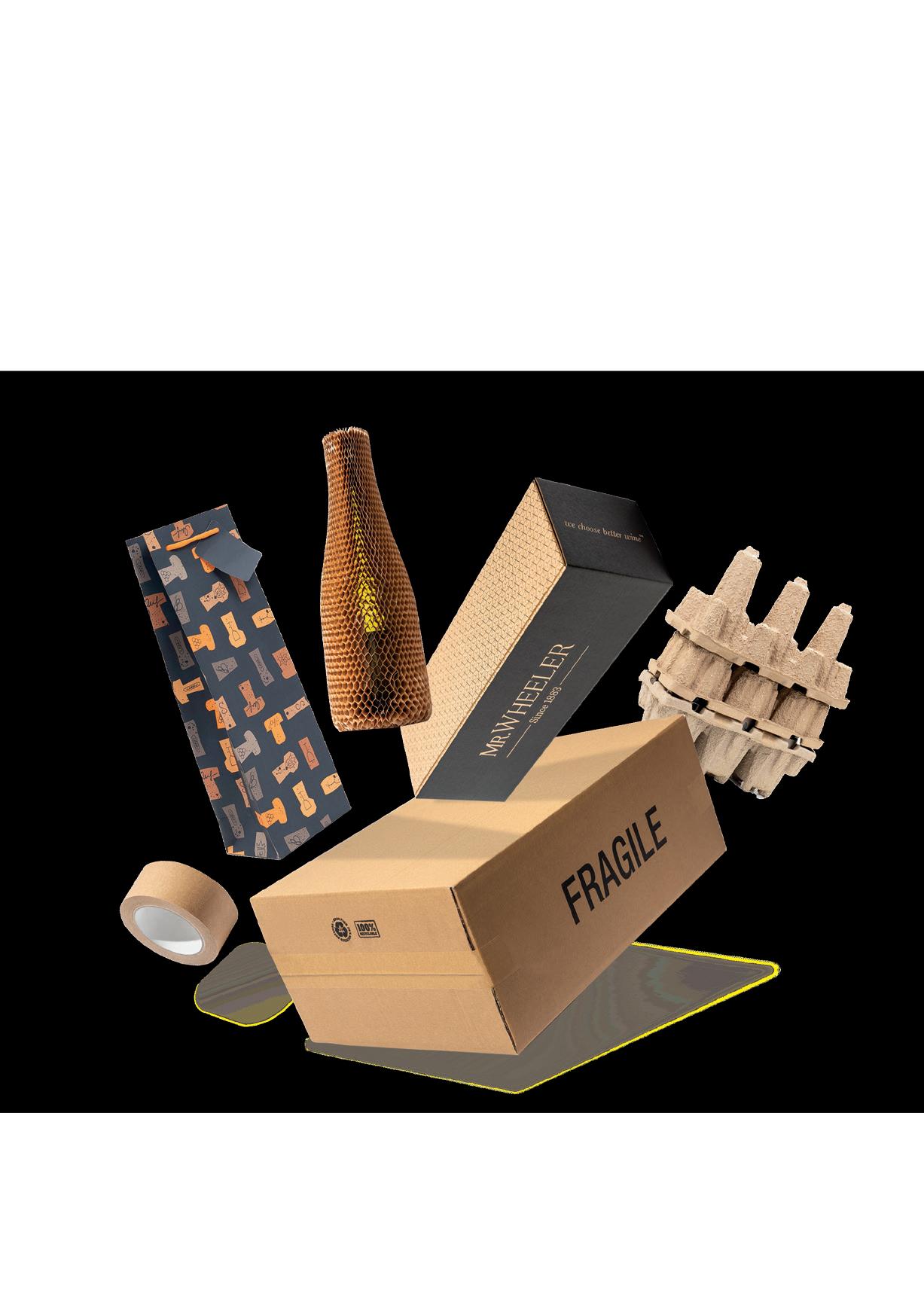


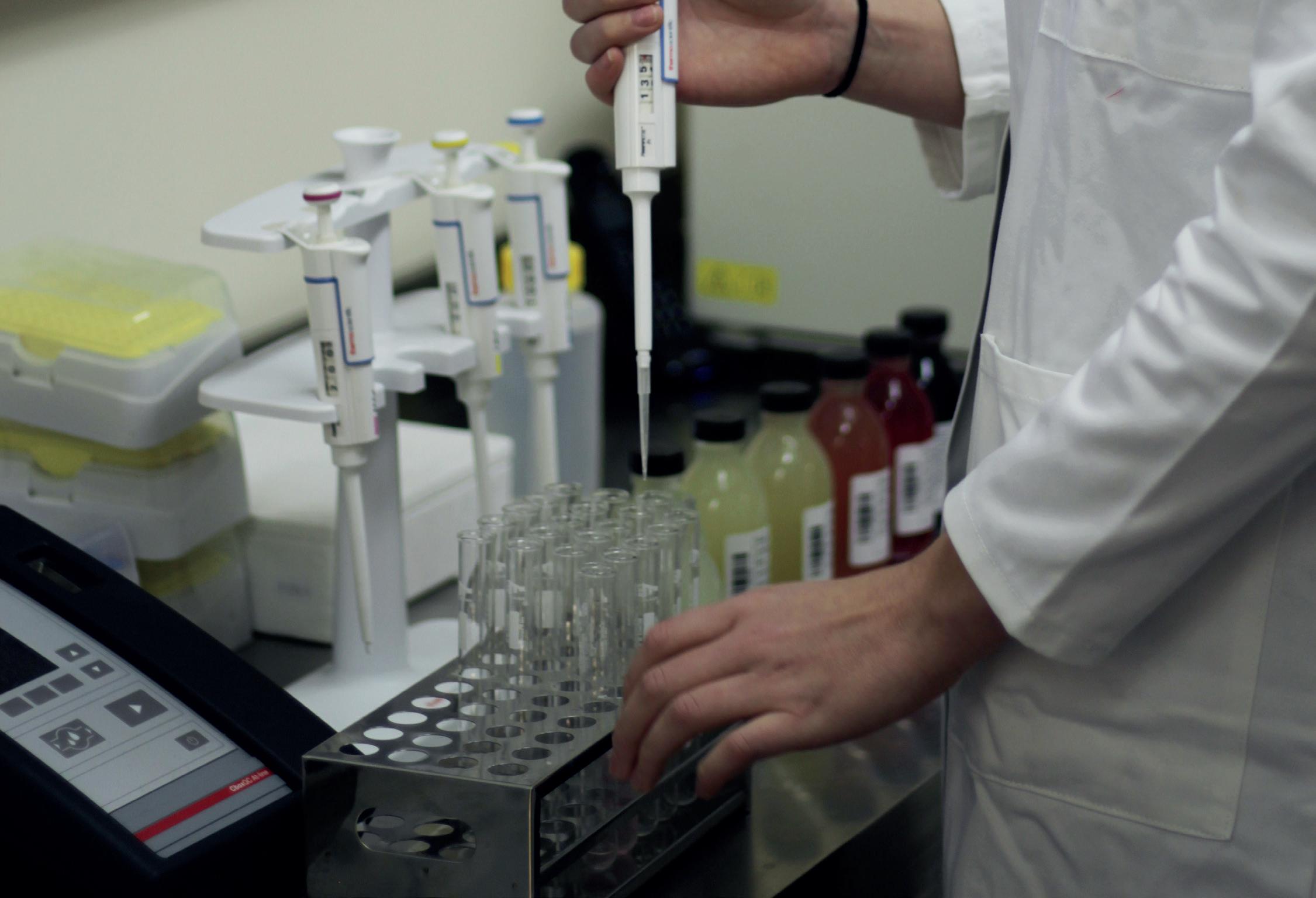
The idea of cluster thinning is to encourage a smaller yield with less dilution and the possibility of a richer flavour profile because the plant will divert all of its energy to the remaining berries. There has not yet been a comprehensive study specifically examining the impact of cluster thinning on wine quality parameters, so it is hard to draw solid conclusions about the tangible benefits.
The review suggests that cluster thinning does ultimately have a beneficial impact on the quality of wine, measured by sensory attributes, volatile compounds and polyphenol content, although the effect can vary depending on factors like grape variety and location as well as the timing and severity of the thinning that has taken place. It was also recognised that cluster thinning is contentious in economic terms as it necessarily reduces the yield. In some areas, particularly those with Mediterranean climates, it was found that the improvement in wine quality would justify the additional cost, this was not necessarily viable in other areas.
Once the fruit has set and begins to mature, the weather becomes less of an immediate threat. The danger comes more from pests and diseases. As mentioned previously, a dense bunch can restrict airflow, particularly to the central berries. They can sit in a microclimate of high humidity and temperature which is the perfect breeding ground for all kinds of nasties.
Of course the impact of infection is not limited to the grapes themselves necessarily, but here is an outline of how some of the key culprits may manifest on the bunches.
Downy mildew is caused by the fungus Plasmopara viticola. Affected berries may show a white down, which is the spore of the fungus. If this occurs while the berries are still small and immature, they may shrivel and drop off. Grapes on red varieties that are infected can change colour prematurely, while white grapes look more mottled in appearance. These afflicted berries are unlikely to soften properly at the end of the season.
Powdery mildew is caused by the fungus Erysiphe necator. This mildew can infect berries from immediately after bloom and for up to four weeks later. It causes the fruit to turn grey in colour and they have the characteristic powdery appearance from the growth
of spores. As the grapes mature, cleistothecia can appear – the fruiting bodies of the fungus. They crack open to release spore sacs which can infect nearby plants. Affected berries can dry out and might drop. When more mature fruit is infected, it is prone to split –making the fruit susceptible to Botrytis infection.
Anthracnose, or black spot, is perhaps less well known, having only been seen in the UK during relatively recent seasons. It is caused by the fungus Elsinoe ampelina. Infected berries will show deep spots which have a black edge and a purple ring with a grey centre. A severe infection can cause grapes to dry up and drop off.
Grey mould, or Botrytis cinerea, is more familiar. Clusters infected with Botrytis are covered by the spores of the fungus, which has a soft grey appearance, almost like felt. Once the spores have grown and the sugar content of the berries has increased, the fungus can directly infect the grapes themselves, causing them to go brown and contract, eventually wilting and dropping completely.
If the infection is at low levels, the damage it causes can be minimal and not have an economic impact on the harvest.

In 2024, the Animal and Plant Health Agency (APHA) took out its first survey of UK vineyards. It was a legislative requirement aimed at early detection of threats to UK biosecurity and to protect industry.
This survey will eventually extend to all known commercial vineyards. It was focused on looking for evidence of twelve key organisms that are termed Quarantine Pests and Diseases (QPDs) in schedule 1 of the UK
Plant Health regulations. Wherever they are found, action has to be taken to eradicate the threat they pose to industry and the wider environment. Those organisms are:
◆ Margarodes prieskaensis
◆ Margarodes vitis
◆ Margarodes vrendendalensis
◆ Grapevine flavescence doree phytoplasma
◆ Xylella fastidiosa
◆ Xylophilus ampelinus
◆ Canadidatus phytoplasma australiense
◆ Peach rosette mosaicvirus
◆ Grapevine ajinashika virus
◆ Graphocephala atropunctata
◆ Draeculacephala Minerva
◆ Scaphoideus titanus
Happily, no evidence of these QPDs was discovered during the survey. The APHA continues to work closely with WineGB to endeavour to protect national biosecurity and agriculture.



A common question I am asked by friends outside the wine industry is, “What do you do through the winter?” The assumption is that, with vines not growing and the weather often miserable, there can’t be much work to do in a vineyard at this time of year. Can there?
I’m always met with shocked faces when I describe the hours of hard work – often in the worst of the British weather – that vineyard workers put into essential winter operations. Winter may seem like a quiet time, but for those of us in the industry, it is a season of intense labour, careful planning, and crucial groundwork that ensures the vineyard’s success in the coming year.
Pruning is arguably the most important vineyard task of the winter, demanding skill, endurance, and patience. Every vine must be carefully pruned to set it up for optimal growth, ensuring a balance between yield and quality for the coming harvest.
The weather has been mixed this winter, with heavy rainfall, strong winds, and brief cold spells. December and January saw frequent storms, while February remained mild with above-average temperatures. Despite occasional frosty mornings, snowfall was minimal, and the season was wetter than usual. This posed challenges, with
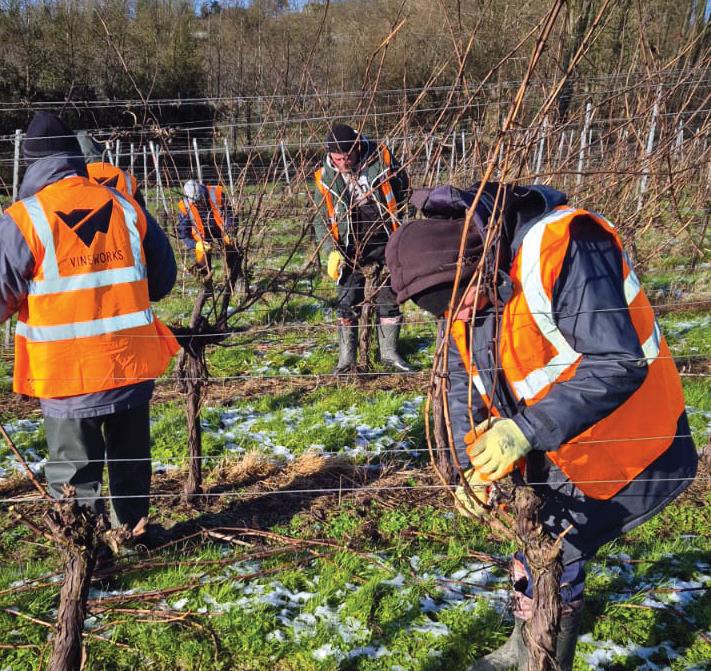
saturated soils making it difficult to move machinery and complicating pruning work. While pruning should ideally be avoided in wet weather, the reality of growing grapes in England is that if we only pruned on dry days, the job would never get finished. That’s why vineyard workers remain out in the fields, rain or shine, ensuring every vine is pruned in time for the new season.
While pruning teams battle the elements, VineWorks HQ is just as busy. Our viticulturists must adapt, ensuring each of our customers has the right number of crew to complete their pruning work efficiently and cost-effectively. This involves meticulous scheduling, coordination with vineyard managers, and regular site visits to check progress and maintain quality standards.
The start of the year is particularly intense. In early January, we welcome back seasonal staff, conducting health and safety inductions and skills refreshers. For new members, this is an opportunity to learn the techniques that define high-quality pruning.
Once pruning settles into a steady rhythm, our focus shifts to planning for the year ahead. A major part of this involves working with an agronomist to develop a tailored spray programme. We also ensure compliance with plant protection regulations – an essential aspect of responsible vineyard management. Keeping up-to-date with legislation is vital for maintaining healthy vineyards and producing high-quality fruit.
Winter is also a key time for machinery maintenance and upgrades. Our team has regular check-ins with machinery operators and contractors to assess workload, discuss
improvements, and ensure all equipment is in peak condition before the growing season begins.
Over the last few years, we’ve recognised the challenge vineyard operators face in managing early-season weed growth. To address this, VineWorks is introducing early-season herbicide applications via ATV (all-terrain vehicle). This will allow operators to access vineyards even when conditions are too wet for tractors, providing a significant advantage in controlling weed growth.
As winter fades, the excitement in the team builds. One of the highlights of my role is planning our first vineyard visits of the season. Budburst marks the start of a new vintage, bringing renewed energy and anticipation. Seeing the first green shoots emerge after months of dormancy is a rewarding moment - one that underscores the importance of winter work.
Spring shifts our focus to monitoring vine growth, implementing nutrition plans, and preparing for frost protection if necessary. The unpredictability of the British climate keeps us on our toes, but with careful planning, we ensure our vineyards are set up for success.
Winter may not be the most glamorous season in the vineyard, but it is one of the most critical. The hard work and resilience of our vineyard teams during these colder months lay the foundation for everything that follows.
This major event will be held in Reims on 23-24 April and will showcase the latest advances in innovation and sensory analysis of sparkling wines.
The Champagne-based company EFFEVENT organise the Sparkling Wine Forum 2025 under the patronage of the International Organisation of Vine and Wine (OIV), which will bring together researchers and stakeholders in the sparkling wine industry at the Village by CA in Reims. This event, reserved for professionals, combines scientific research, economic issues and innovation.
This year, Sparkling Wine Forum will focus on sensory analysis and changing consumer expectations, an evolving area in the sparkling wine sector. Experts such as Yvette van Der Merwe, President of the OIV and Karl Storchmann, a renowned economist, will discuss global consumer trends and the economic challenges facing the sector. These include the issue of US taxes and changes in purchasing behaviour in the light of the environmental approach adopted by Champagne producers. Gerard Liger-Belair, Professor at the University of Reims Champagne-Ardenne, and Gabriel Lepousez, a specialist in sensory perception, will explain how bubbles influence our perception and why effervescence is so appreciated by our senses.
Axel Marchal, a researcher at the ISVV in Bordeaux, will be presenting new findings on the identification of Chardonnay aromas in Champagne wines. The Comite Champagne (CIVC) will be hosting a conference on tasting as a fully-fledged technical tool and its application to wine defects. Monica Laureati, from the University of Milan, will also be presenting her work on the sensory identity of Italian sparkling wines and the associated consumer perceptions.
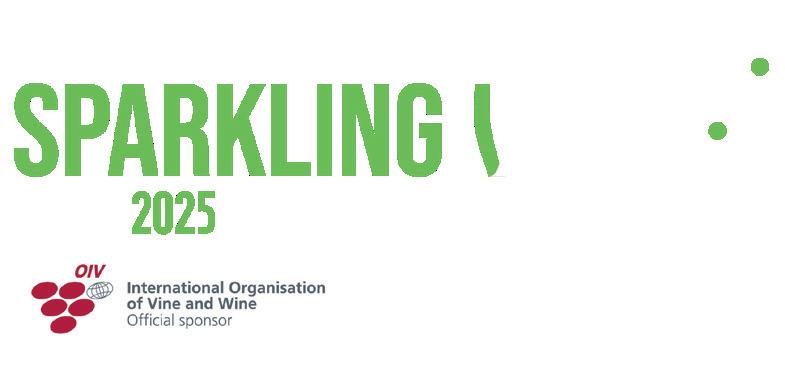
Sparkling Wine Forum 2025 promises to be an event rich in discoveries and high-level exchanges. A number of talks have already been confirmed. Among them, Fernando Zamora from the University of Rovira i Virgili, will be sharing his research on oxygen consumption and autolysis of the lees during the ageing of Cava produced using traditional method. Matthias Schmitt, from the Geisenheim Institute of Oenology (Germany}, will address the issue of reducing the alcohol content of sparkling wines in the context of global warming.
The expertise of the Champagne region will be showcased, with presentations from Moet Hennessy’s research centre and the Comite Champagne (CIVC), which will be presenting its research programmes in varietal innovation and the tools it uses on a day-to-day basis to reduce carbon footprints and eco-design sustainable solutions. The focus will be on assessing the environmental footprint of frost control methods. Masterclasses will also be organised on wine defaults or alcohol reduction in sparkling wines.
Finally, round tables dedicated to innovation will feature researchers and representatives of start-ups, members of La Winetech. They will be looking at the impact of artificial intelligence on oenology and the new challenges facing wine tourism in the wake of the 10th anniversary of the Champagne region’s classification as a UNESCO World Heritage Site. These exchanges will also be enhanced by islands of collective stands where researchers and professionals can work together on strategic themes.

Working in partnership with Vineyard magazine for a developing UK wine industry.
WineGB is the national association for the English and Welsh wine industry. WineGB represents, leads, and supports the sustainable growth of the Great British wine sector.
Entries to the WineGB Awards 2025 are now open. WineGB members can enter by 31 March to benefit from early bird rates held at last year’s pricing. Entries close on 2 May.
The annual WineGB Awards in association with Rankin is the country’s most prestigious specialist competition, dedicated solely to English and Welsh wines.
But there’s nothing parochial about the WineGB Awards. The judging process is vigorous and expert. Via the Golden 50 Wines, WineGB winners are showcased alongside their peers from the biggest international competitions.
Entering the Awards is a low-cost, high-value way to ramp up credibility with both UK and international trade and consumer buyers, benchmark your wines against their peers, and, most importantly, build sales.
With a new simplified entry system, we’ve made the Awards more accessible. From this year, any producer entering two or more wines has an equal chance of winning the coveted Producer of the Year Trophy. The winner will be the producer with the highest overall points score across the wines it enters.
◆ Gain credibility: WineGB’s panel of judges is drawn from a cross section of English wine specialists, including high-profile Masters of Wine, wine writers, trade buyers and consumer champions.
If you are interested in wine production in the UK find out more about WineGB and join us. Visit our website www.winegb.co.uk
This ensures that winning a WineGB medal gives the strongest possible evidence of a producer’s winemaking credibility.
◆ Benchmark wines: Entering the competition allows producers to benchmark their wines against the best in the country.
All wines that win medals receive feedback in the form of tasting notes from WineGB’s expert judges, which can be used in any promotional activity. Even if a wine does not win, entering gives valuable insights into peer competitors, helping producers to understand the direction of the industry and refine their approach.
◆ Build sales: Most importantly, research shows that products with expert validation receive a boost in sales, and that consumers are willing to spend more on products that have won a prestigious award.
We operate in a crowded, competitive marketplace, in which many buyers have limited understanding of our emerging category. A WineGB medal can open doors to new trade distribution channels and offers time-poor consumers a shortcut to choice.
Enter via the WineGB Members’ Area MyWineGB portal. Contact awards@winegb.co.uk for more information.

14-23 March 2025
English Tourism Week
24 March 2025
WineGB Tourism Report launch
31 March 2025
WineGB Awards early-bird entries close
April 2025
Export activity (USA)
2 May 2025
WineGB Awards entries close
30 May-8 June 2025
Welsh Wine Week
2-6 June 2025
WineGB Awards Judging
7 June 2025
Wine Garden of England Summer Celebration
21 June-29 June 2025
English Wine Week
◆ Cellar Door Campaign
◆ WineGB Awards results
28-29 June 2025
Vineyards of the Surrey Hills Summer Spectacular
For the WineGB Photography Competition 2025, we’re not only looking for harvest images, but pictures of all the seasons, whether in the vineyard, winery, or cellar door. This is to help us as an organisation better illustrate the journey from vine to bottle and capture the wide variety of work that happens in UK vineyards and wineries throughout the year.
The competition will be hosted across the WineGB social media channels and our followers will be asked to vote for their favourite.
The 10 submission categories are:
◆ Harvest
◆ Spring
◆ Summer
◆ Autumn
◆ Winter
◆ Winemaking
◆ Sustainability
◆ Wine tourism
◆ Wine tasting and sales
◆ Bottles and glasses
29 June 2025
Vineyards of Hampshire Fizz Fest
June 2025 Touch Down Tasting
17 July 2025
WineGB Awards Celebration and Trophy Announcement
8 September 2025
WineGB Trade and Press Tasting
Images should be high resolution (minimum resolution of 300dpi or 300ppi), be of UK vineyards only, and should avoid prominent brand logos and signage.
The competition is free to enter, and everyone is invited to take part. Photos will be assessed by an expert panel that will create a shortlist in each category.
The shortlists for each category will be shared on our social media channels, and our followers and the public will be invited to vote to select their favourite.
Each category winner will receive:
◆ A showcase on social media featuring their winning photo
◆ An interview with the person and producer behind the lens
◆ A social media pack so they can advertise their inclusion in the shortlist.
WineGB membership entitles you to a 20% discount from WineGB Partner Riedel when purchasing through their UK webstore. For more information and to join us today email office@winegb.co.uk
◆ An invite to the WineGB Awards ceremony on 17 July where the overall winner will be crowned.
The overall winner will also receive:
◆ A social media showcase
◆ A case of medal-winning wine from the WineGB Awards
◆ Feature on all WineGB branded note cards for the year.
Entries to the WineGB Photography Competition 2025 close on 23 April. You can enter online via the WineGB website: www.winegb.co.uk/winegb-photography-competition-2025/
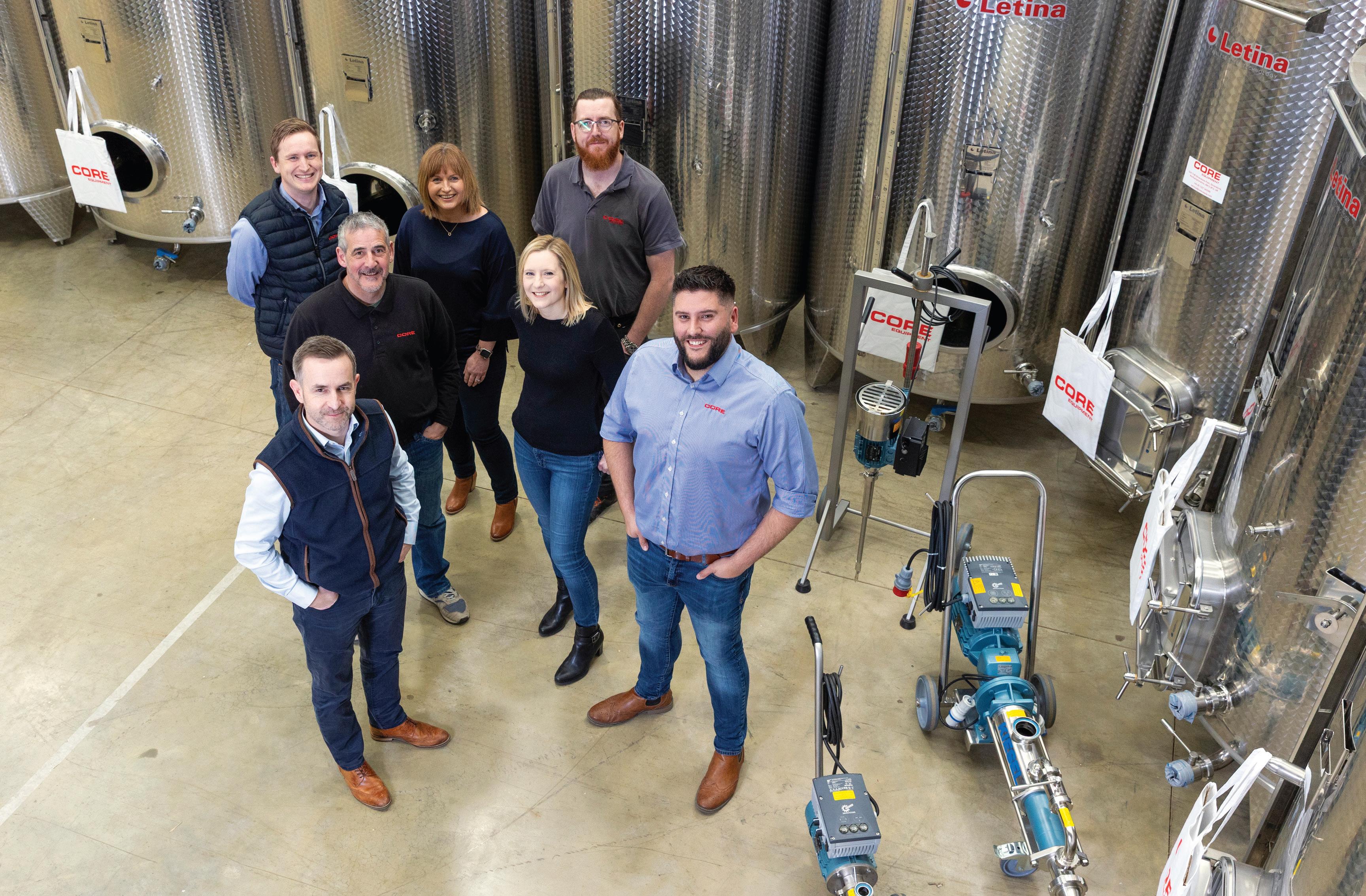
Photos: © Martin Apps, Countrywide Photographic
The UK’s leading supplier of winemaking equipment, Core Equipment puts building relationships at the heart of everything it does, both when dealing with its growing customer base and with its impressive list of suppliers.
“We believe in working closely with our customers to make sure we support them through the whole process, and we build strong relationships with suppliers because that means we can rely on their commitment and support,” explained incoming managing director Daniel Tomlin.
When it comes to customers, Core Equipment’s support extends to providing in-depth commercial analysis on the costs and benefits of new installations, helping the grower or winemaker to understand the likely return on investment and supporting their decision making.
“Investing in a new winery can involve significant start-up capital,” Daniel went on. “We like to spend time with the customer, listen to their needs, evaluate their options, provide a consultative sales approach and help them create a viable plan that clearly sets out their budget for the project. Essentially, we help them with their business plan before supplying the equipment that will turn that project into a reality.”
Established in 2011 by founder Jonathan Chaplin, Core Equipment
“We help customers with their business plan before supplying the equipment that will turn that project into a reality”
has grown rapidly over the years and is now one of the longest standing and most trusted winery equipment suppliers and service providers in the UK.
While careful not to make any claim to be the biggest, Daniel pointed out that supplying some 200-plus tanks and averaging ten new press sales annually, as well as multiple grape reception solutions, fermentation control systems, disgorging and bottling lines, as well as ancillary equipment such as pumps and filtration systems would certainly make Core Equipment a leading supplier to the industry.
Core Equipment, which focuses on full winery ‘projects’ as well as supplying a full range of individual pieces of equipment, has built eight wineries “from the ground up” in just two years and, in Daniel’s words, “has a foothold in pretty much every UK winery due to our longstanding presence in the UK wine market.”

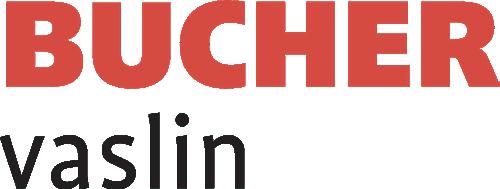

<<
It’s an impressive record and reflects a strong focus on delivering exactly what the customer wants and working with some of the best suppliers of quality winemaking equipment across Europe, something that has inspired a number of new relationships in past months.
“We have always worked with the best manufacturers. Our reputation stems from this, and we are constantly looking for innovation, new suppliers to work with and quality wine making equipment to ensure that we are market leading in the solutions we offer to our customers,” went on Daniel. “Working alongside globally renowned suppliers ensures we stay ahead of the curve and maintain our position as the ‘go to’ provider for UK winemakers.”
New suppliers join a carefully chosen stable of world-leading partners which has helped Core Equipment make such an impressive mark on winemaking in the past 15 years, including BUCHER Vaslin, Borelli Group, G A Kiesel and renowned stainless steel tank manufacturer Letina.
“Our ambition is to work with the best supplier in each area,” said Daniel. “We have worked hard to find the quality equipment that will

“Working alongside globally renowned suppliers ensures we stay ahead of the curve and maintain our position as the ‘go to’ provider for UK winemakers”
allow us to give our customers the best possible solution and allow them to get on with the job of making wine without worrying about the reliability or suitability of their equipment.
The choice of Kiesel pumps is a case in point. “As someone once said to me: ‘Would you rather buy one pump which lasts for ten years or one pump every year for ten years’,” commented Michael Mason, Core Equipment’s management accountant and the man who offers his expertise around the commercial aspects of projects, including cash flow management, foreign exchange handling and invoicing.
“Deep diving into the commercial elements of any winery project not only facilitates the customer in their decision-making process but also helps us tailor project-specific solutions to make the journey with Core Equipment as easy as possible,” Michael commented.
Jonathan Chaplin is still very much involved with the ongoing development of Core Equipment but has now handed day-to-day control of the company to Daniel, Michael and a strong central team of committed and customer-focused professionals, all of whom contribute to the ongoing success story.
Daniel, previously the company’s sales manager, has been with Core for over seven years and joined from a strong, commercially focused career with a number of corporate businesses, operating in the oil and gas, facilities management and tourism industries.
“That background is very useful when it comes to tendering for projects, looking after customers and managing suppliers,” he said. “I aim to create a professional, commercial relationship but with a personal touch.”










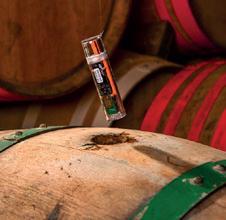


Dealing with suppliers is an area where Daniel invests a lot of time and effort. “Without suppliers we have nothing, so it is important to focus on that relationship,” he explained. Members of the Core Equipment team regularly visit exhibitions across Europe, support training days and seminars and “work hard at establishing ourselves as an active part of the manufacturing and supplier community,” he said.
“The UK is a comparatively small market for many of these suppliers and we need to ensure that we are being provided with the focused support we need to best serve our customers,” he went on. “We need to know that they will provide what we want, when we want it, especially on the occasions when we have a customer request away from the norm. That’s only possible because we take time and effort to build a relationship with each and every one of them, and I’m proud to say that’s exactly what we do.”
New suppliers, strengthened relationships and a renewed focus on delivering the best possible service to the customer has seen Core Equipment, which can provide everything a winery needs, continue to grow its turnover, reputation and market share.
An in-house project management and service delivery team means Core Equipment can deliver entire turnkey winery projects, while the customer focus ethos provides newcomers to the industry, in particular, with as much support as they need or want.
“Our aim is always to add value between the manufacturer and the end user while taking the stress away from the customer,” said Daniel. “We can manage the project from grape to glass, turning an empty barn or purpose-built building into a winery. We produce detailed CAD drawings and 3D models of the equipment we are providing, which really brings to life the project for the customer. Supported by detailed project plans, method statements and scope of works documents, we add value at every step of the journey.”
Core Equipment continues to grow and is always looking for new recruits to join the team working with customers nationwide. The good news for winemakers in the South East is that Core Equipment is planning a sales and service office in Sussex for 2025.

“It is important to be ‘part of the family’,” said Daniel. “It will allow us to be more reactive as well as proactive and allow us to further develop our service offering.”
Servicing is an important part of the Core Equipment offer and is in the hands of service manager Colin Sene, the longest-standing member of staff and responsible for on-site installations. “Colin has a wealth of knowledge and years of experience,” commented Daniel.
Colin’s three-strong team now includes service engineer Duncan Lewis, described by Daniel as “an excellent engineer and brilliant with customers”. As well as installations, Colin’s team provides a full servicing package and can maintain and repair a broad range of winemaking equipment, whether or not it was supplied by Core Equipment. An
✓ Continuous steam supply as long as needed
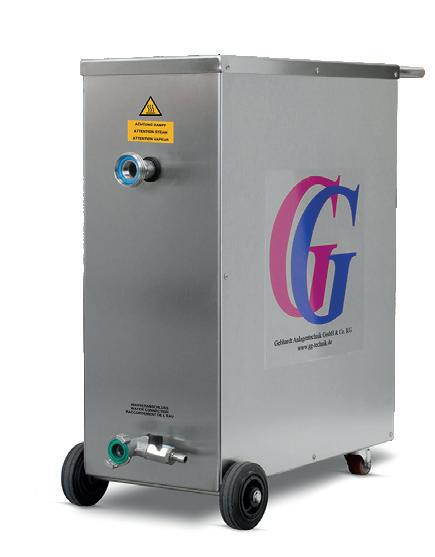


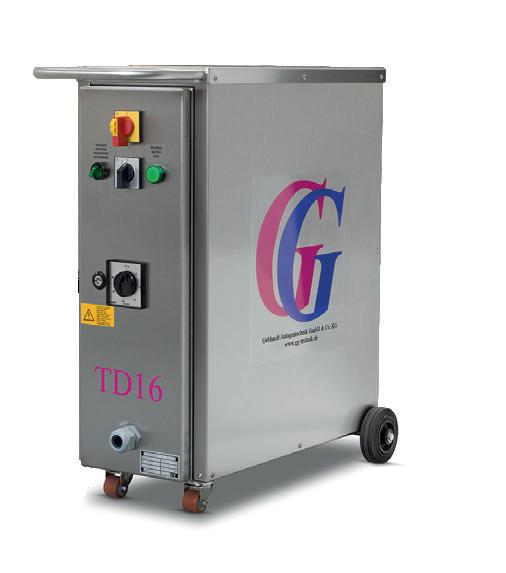
✓ Simple to descale ✓ Sterilisation of tanks, barrels, filters and filling machines





Dogliotti S.R.L., founded in 1977, is a company with over 45 years of experience in the bottling sector. Its activity is based on the design, construction and installation of conveyors and transport systems for the transfer of glass bottles.

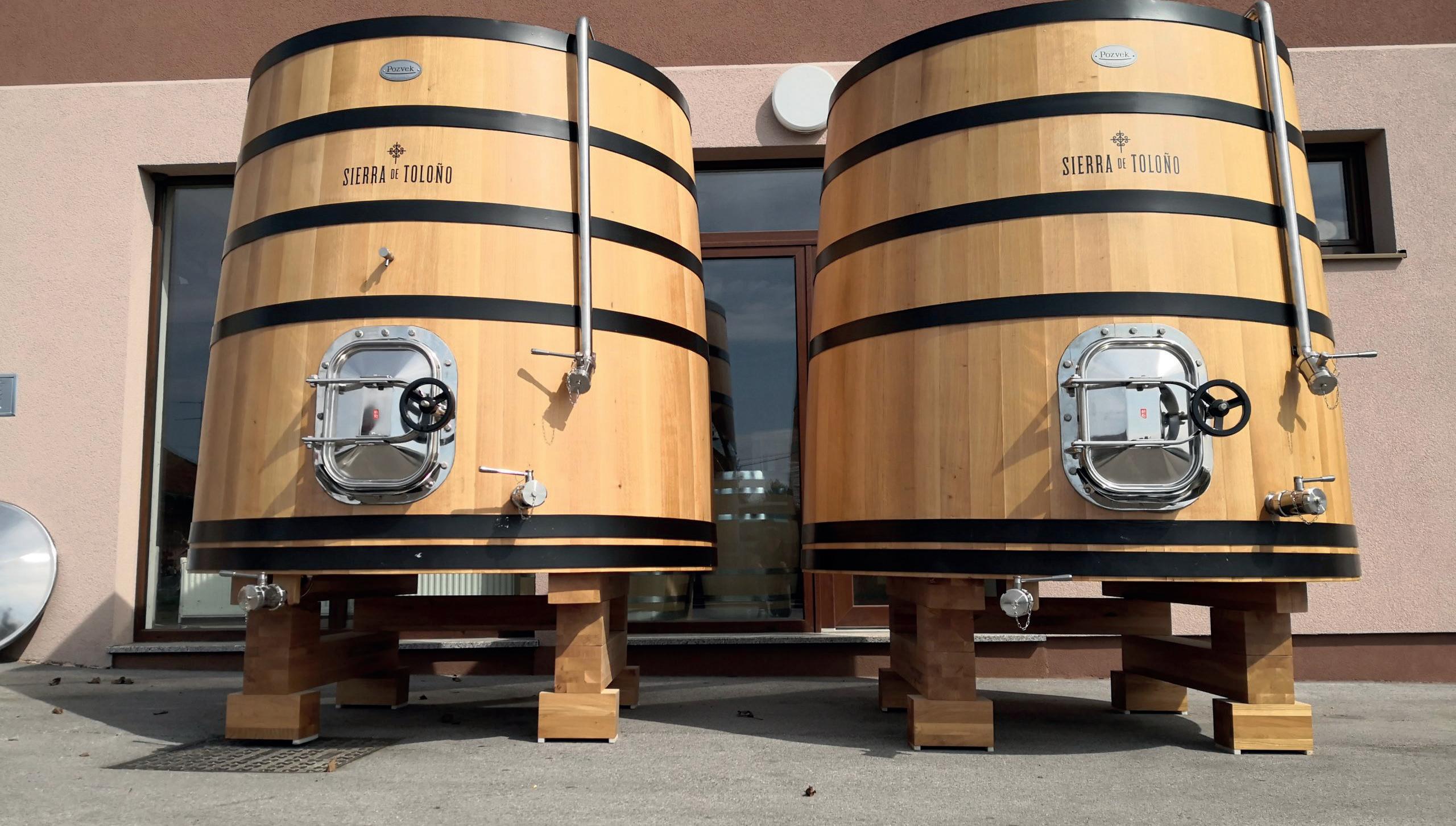
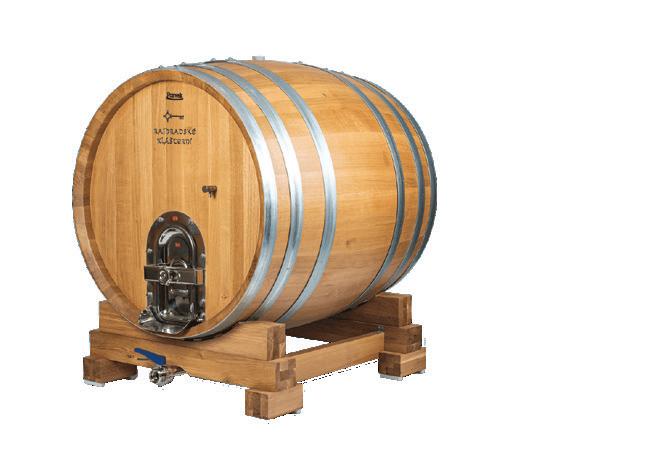
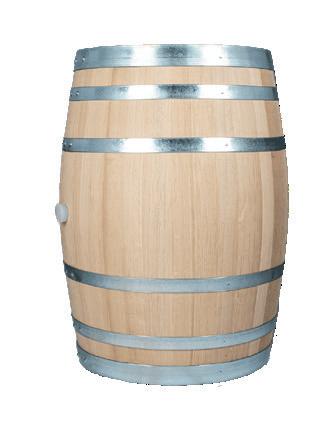

The company, which is looking to take on at least one more engineer, offers service contracts as well as responding in the event of an equipment breakdown. Colin’s team will be based in due course in the new Sussex satellite office along with business manager Jeaffreson Patterson.
Jeaffreson, described by Daniel as “fully immersed”, is a Plumpton wine-making graduate who has many years of operational winery experience and has worked in France, Australia and the USA. “He has strong relationships with winemakers, vineyard managers and owners across the industry,” said Daniel.
Given the complexity of importing equipment and, in some cases, building a new winery from scratch, purchasing and supply chain manager Nicola Peters plays a vital part in the efficient running of Core Equipment, relying on her 15 years’ experience in the beverage industry.
Equally important is Kirsty Goepel, the company’s operations

“If you are investing a significant amount of money on a new winery or equipment upgrade, you are entitled to expect the best possible service and support”
manager and who is “incredibly detail focused” in the words of Daniel. “Kirsty is a highly reliable and supportive member of the team with a real eye for detail,” he commented.
With Core Equipment continuing to provide a high level of project delivery to the UK wine industry, Daniel summed up the company’s approach to its customers. “If you are investing a significant amount of money on a new winery or equipment upgrade, you are entitled to expect the best possible service and support, something we pride ourselves on delivering and which sets us apart from our competitors,” he concluded.

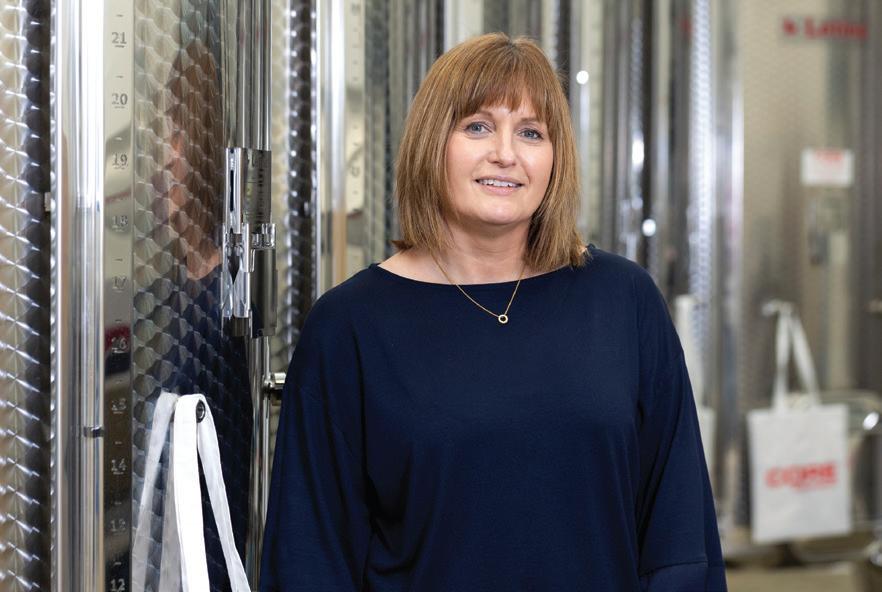


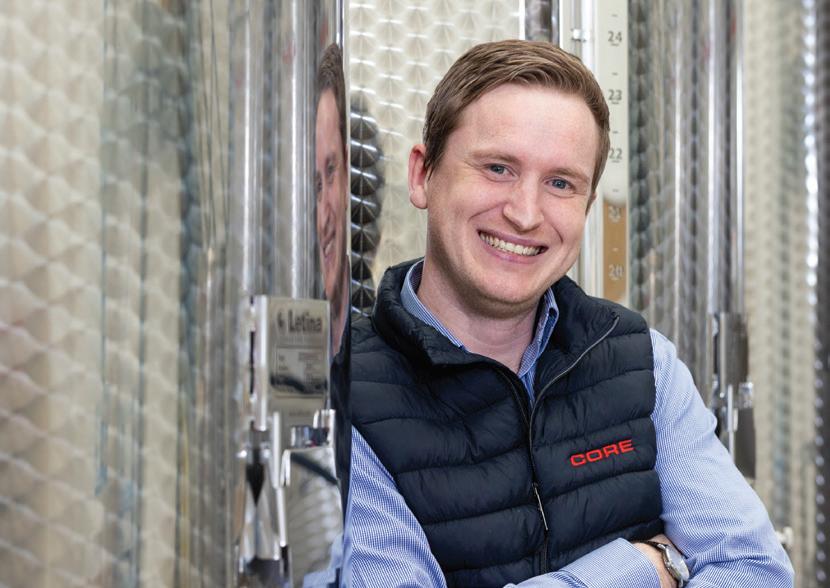





Letina tanks available from stock at Core Equipment
Worried about running out of tank capacity this year?




To take the stress out of buying tanks for this harvest, Core have secured a significant quantity of both fixed and variable capacity Letina tanks from 1000 litres through to 10,000 litres. As Letina’s largest European distributor and exclusive UK distributor, our close relationship with the Letina factory has enabled us to secure additional stock for delivery this spring.
Contact the Core sales department to secure yours.
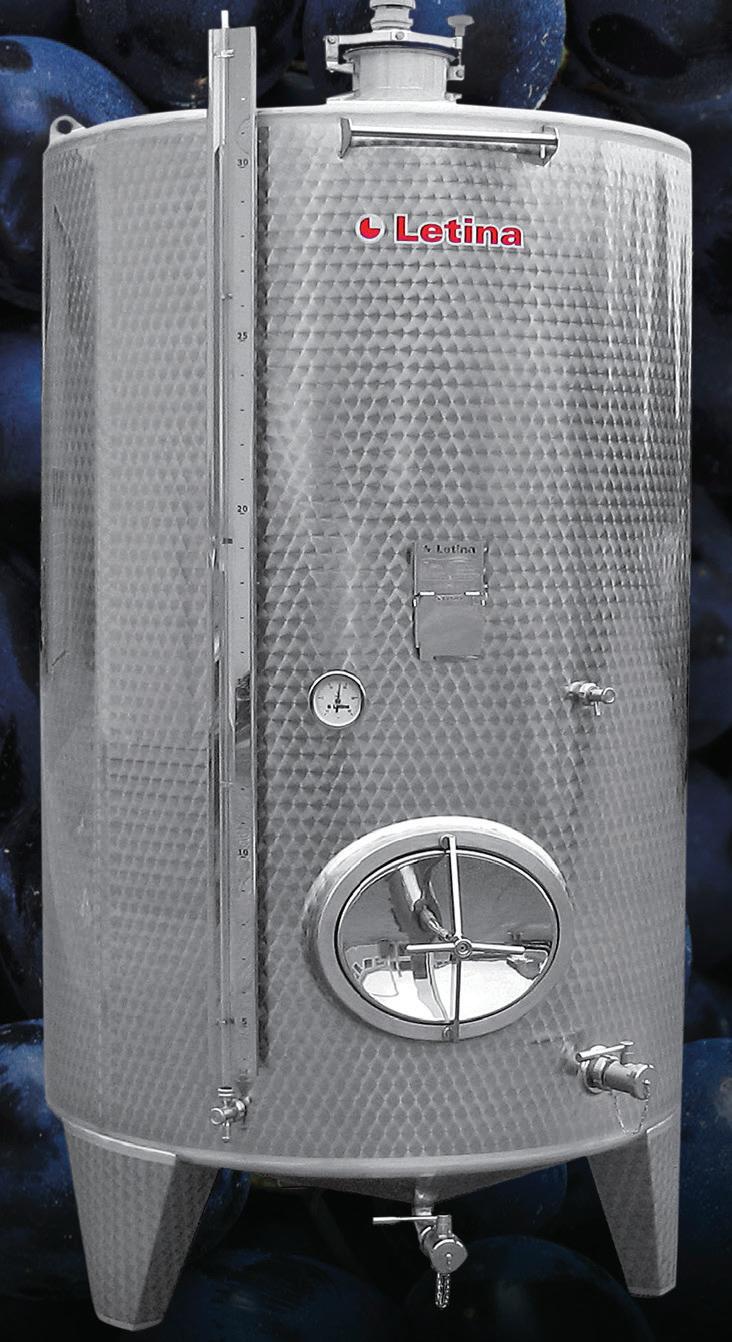



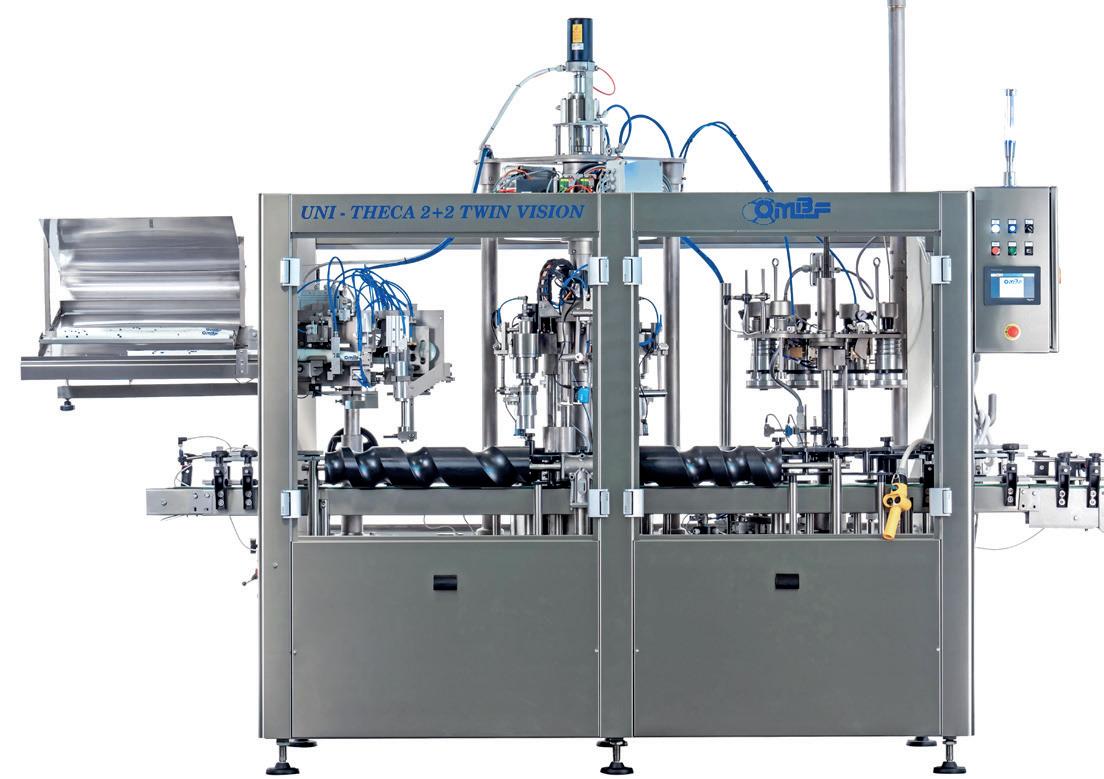

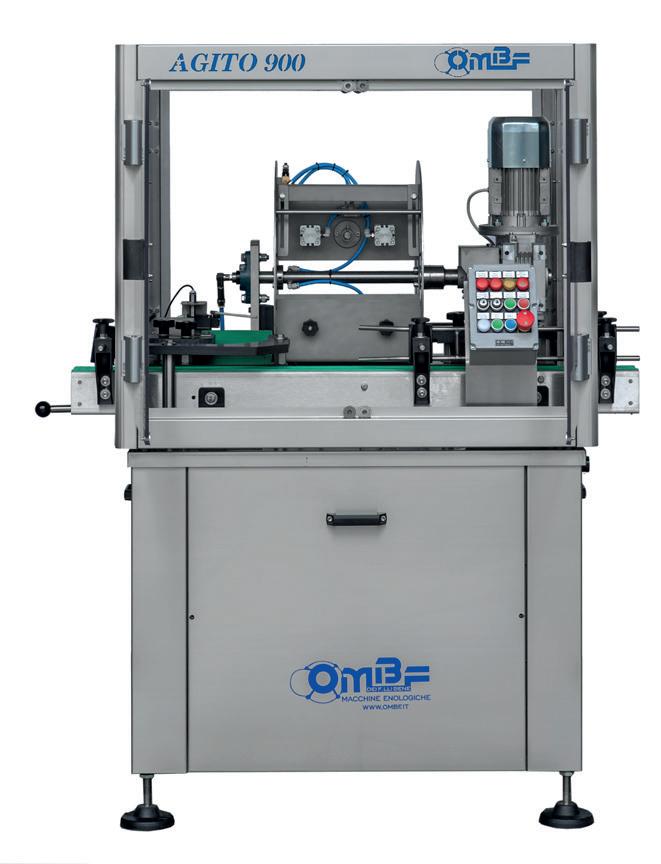

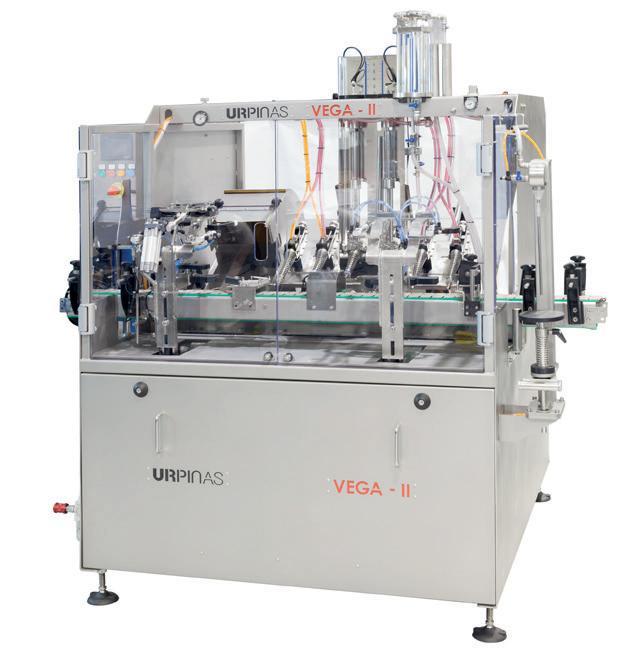


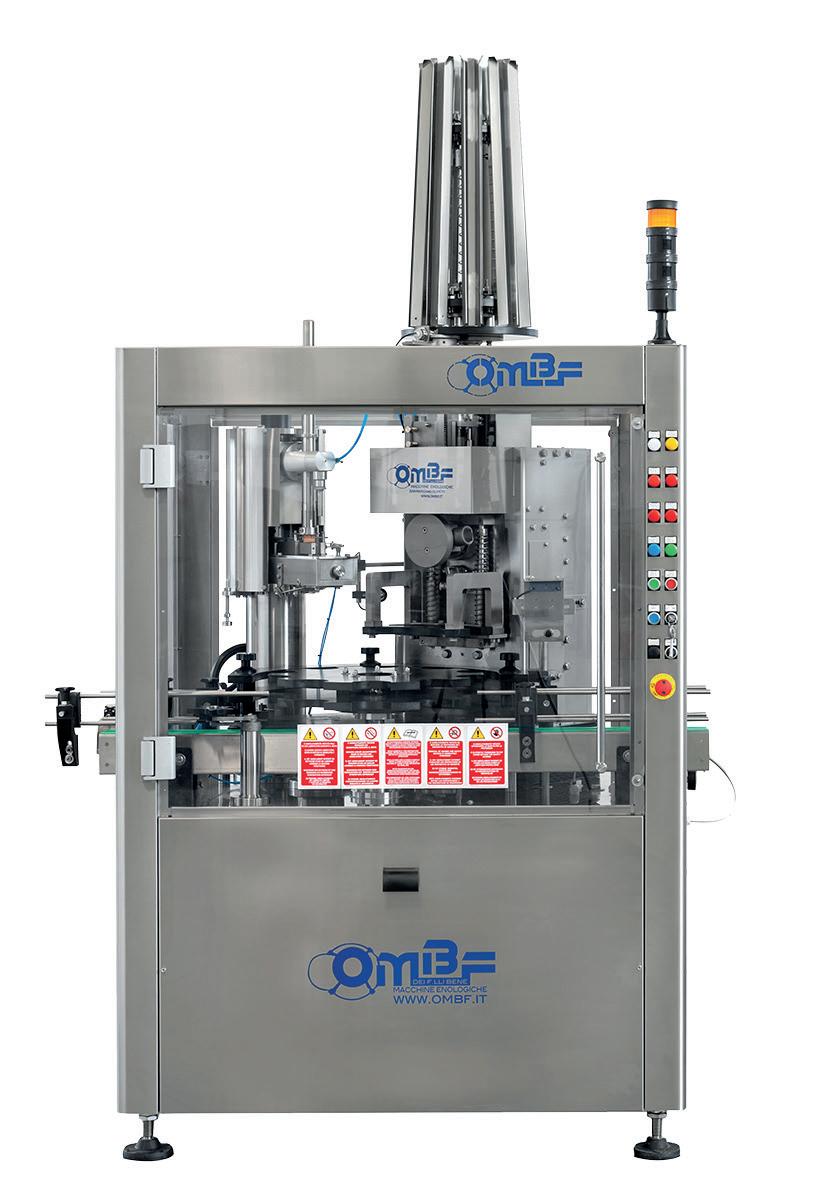
Distributed
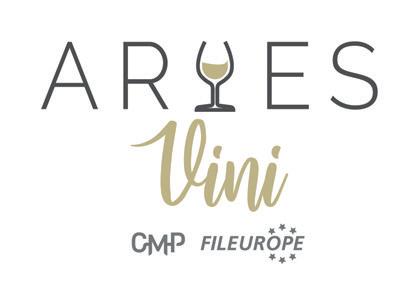
www.aryes-vini.com
• Riddling machines (from mono cage to six cages)
• Riddling boxes
• Storage cages
• Vision system
www.sparklingequipment.com
• Neck freezers
• Neck rinsing tunnels
• Disgorging and dosing machines
• Transfer machines
From 100 to 12.000 bottles/hour
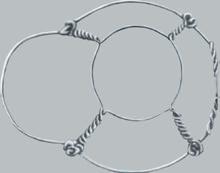
www.ombf.it
• Wirehooders
• Monoblocks corker/wirehooder
• Liqueur mixers
• Capsuling machines for sparkling and still wine
• Isobaric lling
• Keg lling
Semiautomatic and automatic machines from 300 to 7.000 b/h



www.core-equip.com
Core Equipment is the sole distributor in the UK for the BUCHER Vaslin range of grape reception, sorting, pressing and filtration equipment, together with crossflow and pump technologies.
“It’s the Rolls Royce in its field,” commented Daniel.
Letina’s unbeatable manufacturing quality, allied to the wide range of capacities on offer, has seen the tank supplier become one of Europe’s success stories in the global winery equipment market. Core Equipment supplies between 150 and 200 stainless steel Letina tanks a year, in sizes ranging from 500 litres to 100,000 litres.
Sparkling Equipment provide a full range of winery equipment, covering every stage of production – from tirage to Isobaric filling, riddling to disgorging, corking, and wire hooding. Solutions cater to wineries of all sizes, offering both manual and fully automated systems to suit different production needs. Whether you’re a small producer handling a few hundred bottles per hour or a large-scale operation processing thousands, their equipment ensures precision, efficiency, and consistency at every step. With advanced technology and customisable options, Core Equipment can help you achieve the perfect sparkle in every bottle.
Thermoregulation experts LiquoSystems are a German supplier that specialises in temperature control systems for storage and fermentation tanks and employs the latest technology supported by more than 25 years’ experience in the industry.
Dogliotti offers a wide range of bottle conveyancing systems for both complex and simple bottling lines. The range includes buffer
and accumulation tables, single and multi-track conveyors, standard and frictionless corners, side and parallel transfers and rotary pack-on and pack-off tables, as well as bespoke packing systems.
Capturing and interrogating data is increasingly important when creating quality wines, which is where French manufacturer Onafis’ live data capture systems can help. Capturing information such as temperature, density and Brix, Onafis promises “Solutions for monitoring the grape harvest, fermentation and maturation processes.”
German pump manufacturer Kiesel is renowned the world over for its quality range of impeller pumps, eccentric screw pumps, centrifugal pumps, mash pumps and rotary lobe pumps as well as for supplying the company’s RG range of agitators. Robust and reflecting German build quality, they well deserve their reputation.
Based just outside Canelli in the Asti region of Italy, Borelli benefits from being close to the centre of the Italian bottling and packaging industry, which allows it to benefit from specialist supply chains and technical expertise. Its impressive range of bottling machines reflects that quality input.
GG Technik is another German supplier, in this case of sterilisation equipment, including steam generators, bottle steamers, pasteurisers and barrel and pump cleaning technology.
Pozvek is a new, Croatian-based Core Equipment supplier that uses top quality Slavonian oak to create barrels used for maturing wines. The wood is cured for two months outdoors before being used for 150, 225, 300 or 500 litre barrels.
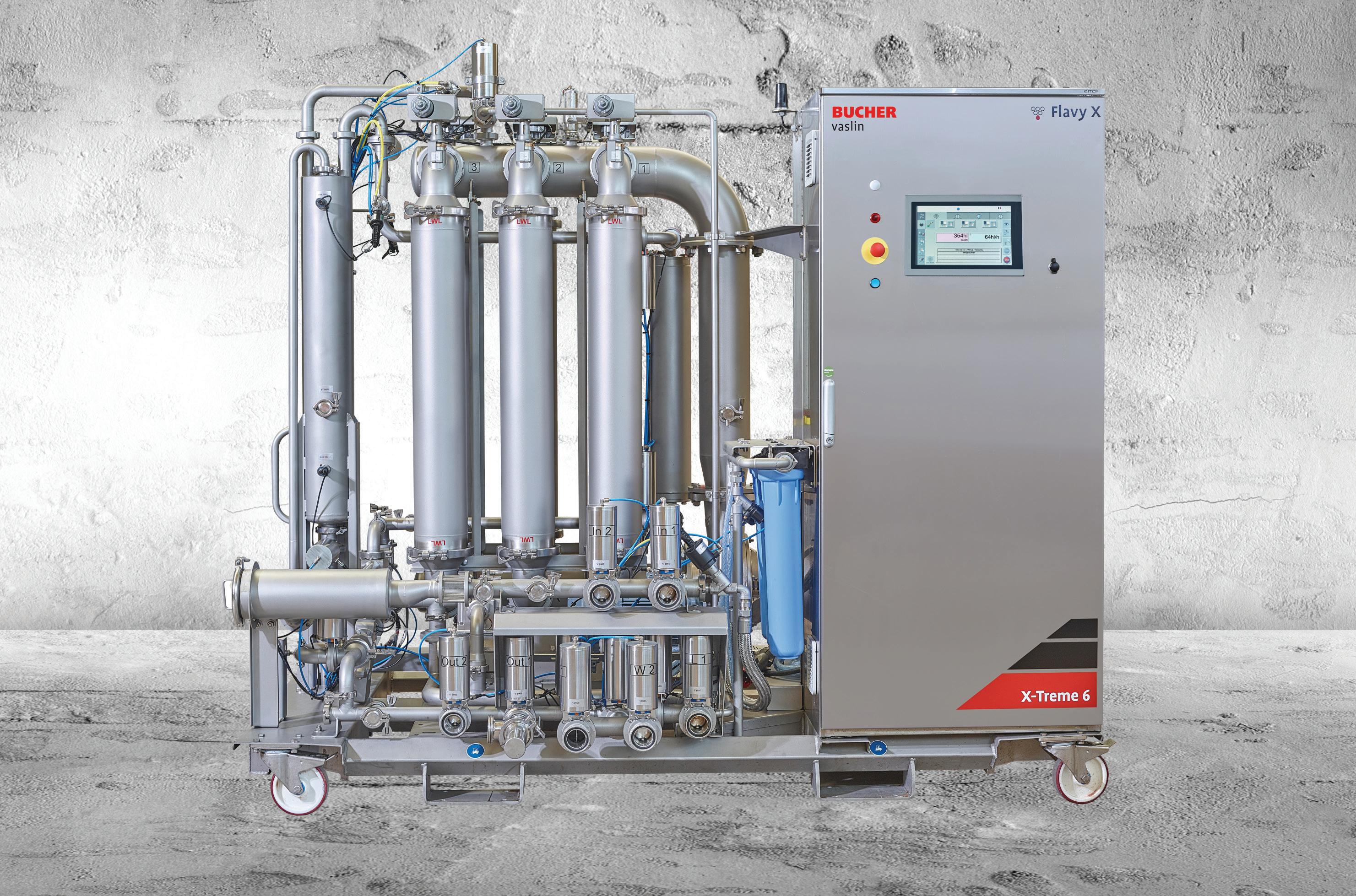
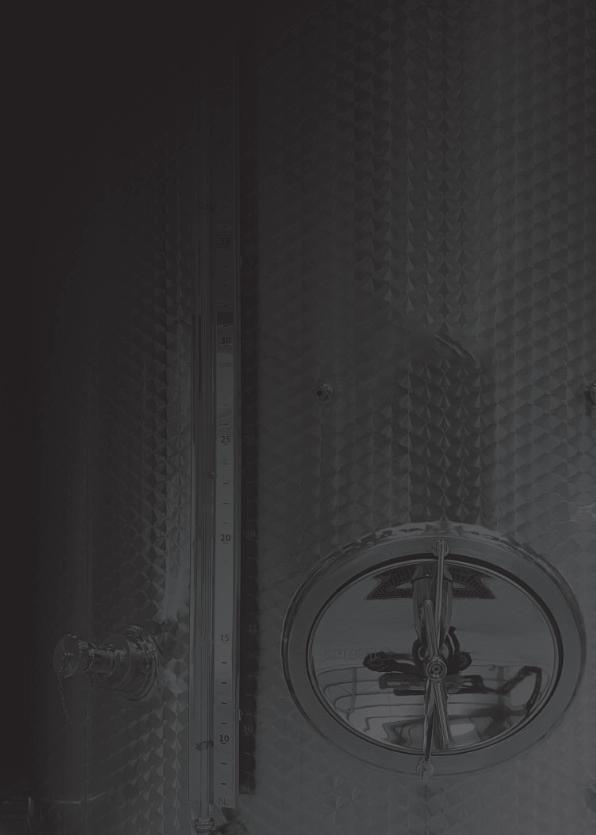













































































































The Landquip Herbi two row sprayer.
The use of sprays in the vineyard is a tried-and-tested means of weed control, one that has come under more scrutiny by environmental bodies as the years go on – meaning a reduction in approved products, and a drive by vineyard owners and consultants to adopt a more mechanical approach.
A major drawback of a purely mechanical method of weed control is that timing is key; too early in the season and the ground is too wet, too late, and the weeds are too advanced impacting airflow and humidity undervine. This results in increased passes over each row throughout the season to tackle the weeds at the right moment, with the excessive soil compaction and increased fuel use that accompany such an exercise.
A machine that can slot in nicely to a predominantly mechanical philosophy is a herbicide sprayer– used early in the season, these machines can kill off unwanted growth before weeds properly take off without churning up wet soil.

The company applies their extensive knowledge and high-quality components from intensive arable machinery to a range of vineyard sprayers, notably the two row Herbi sprayer.
This machine comprises a 600l tank, mounted on the rear of the tractor – its shape enables it to be used on the steepest of slopes and






rinse, handwash and agitation jets as standard.
Spray booms are side mounted on the powder-coated frame encompassing the tank, and will cover two complete rows. Each outer boom has a sprung breakback system should an obstacle be encountered, and they fold completely back for a 1.6m wide transport width, with a simple lock system for both transport and work positions. LED road lights provide extra safety when moving between sites on the road.
Four hooded spray units apply herbicide directly to the undervine area with zero drift in rows from 2.2-2.5 metres wide, while three centre nozzles can be individually opened should an operator want to spray the middle of the row – perfect for terminating cover crops should tillage or mowing prove ineffective.
An electric control unit provides three section on/off and pressure adjustment, with Bravo control with adjustable rate, volume and pressure readouts available as an option. All pump and valve units are taken from the same suppliers as the arable machinery offered by Landquip, so are of the highest quality and are well-proven in their application.
The Herbi and other vineyard sprayers from Landquip are available from Haynes Agricultural across the South.



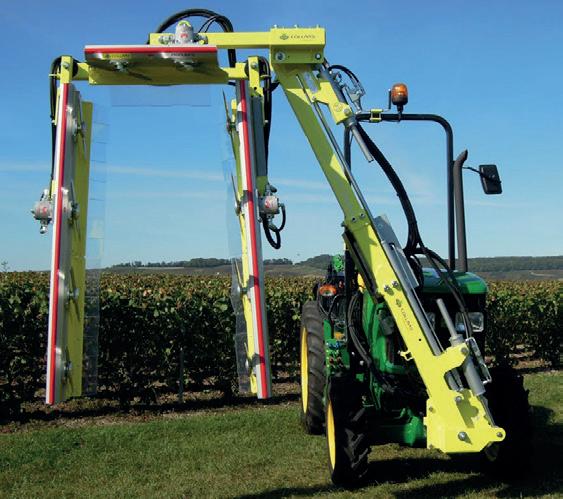

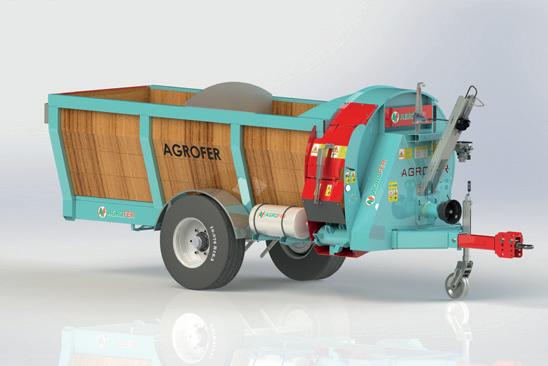
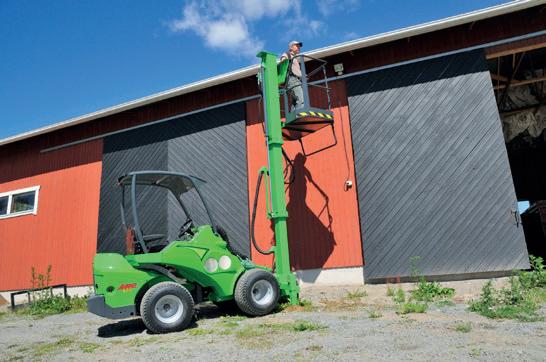

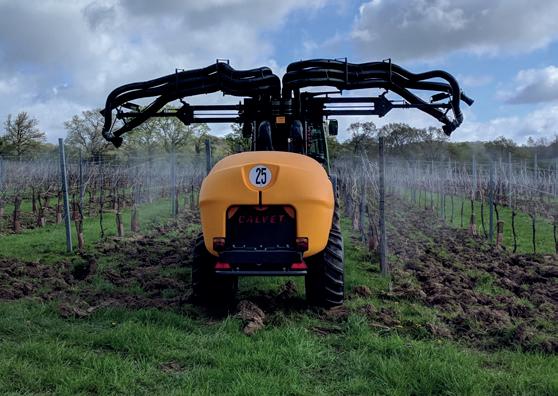


Veenow Vineyard is proud to announce that after extensive research and assistance it will be the first operator and sales agent of the UV Boosting technology to be at the forefront of sustainability in UK vineyards.
After a year of research into the usage of UV-C and the different application methods, Robert and Katie came across UV Boosting based in France and made contact with Emanuele who was very helpful in explaining independent research and historic data from trials covering over seven years. After testimonials from other operators around the world on what they can achieve it was a straightforward decision with a visit to the headquarters just outside Paris.
“We decided to choose UV Boosting due to the patented technology, robust build quality and technical ability within the team, which made it a great partnership” said Robert Greenow from Veenow Vineyard. “The benefits are huge across
our 40 acre vineyard, these benefits are not only financial but also increase the sustainability of our spray regime,” added Robert.
The effect of using UV-C from the UV Boosting Flash Technology allows Veenow to:
◆ Reduce the risk of frost by up to 50% pre-stimulating the vines at bud burst with a single pass up to 48 hours before a frost period.
◆ Reduce the amount of chemicals by up to 60% when treating downy and powdery mildew with three to four stimulations per season.
◆ Reduce disease within the vineyard –40% on average with mildews.
◆ Enhance vine vigour which leads to a potential 13% increase in yield as the vine has had less stress periods from stimulating self defence mechanisms prior to the problem developing within the vine. Veenow plans to carry out four to five passes over the season but also run trials
amongst its varieties such as Pinot Noir, Bacchus, Chardonnay, Pinot Meunier and Caberet Noir. “Interestingly the key benefit with a PIWI due to its existing resistance to mildews is frost protection and yield increase which alone pays for the application of UV-C,” said Robert Greenow.
“We decided to be the first in the UK as our passion is sustainability while maintaining quality clean grapes for harvest” explained Katie Greenow. “Combining this technology with digestate application and specialist cover cropping is hopefully setting an example that monoculture, mass production vineyards are different to us here,” she added.
“We are very excited at UV Boosting to have a first unit running in the UK in 2025” said Baptiste Rouesné, CEO of the company. “We have seen British vineyards grow rapidly in the last few years and hopefully we will be able to deploy many more units in the coming years” he added. Further updates will be provided during the year.




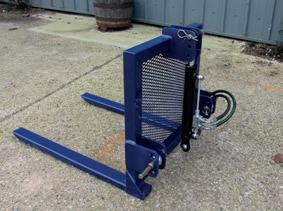

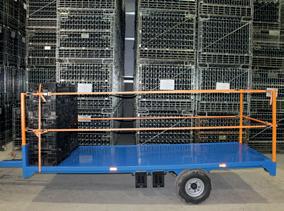

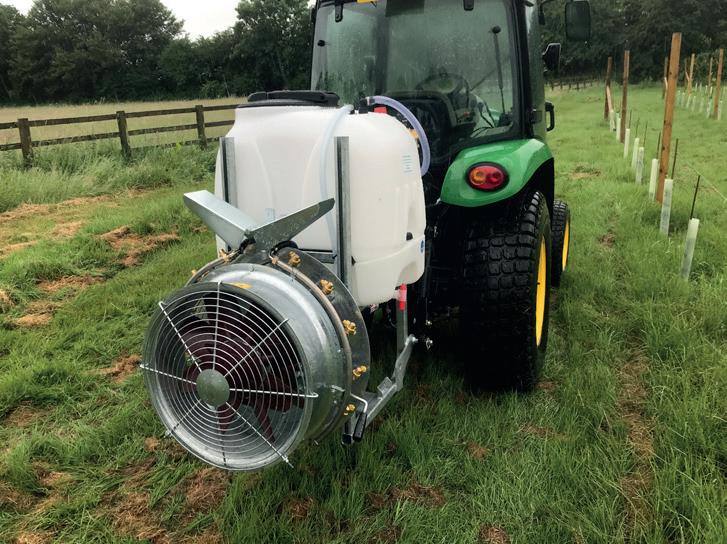
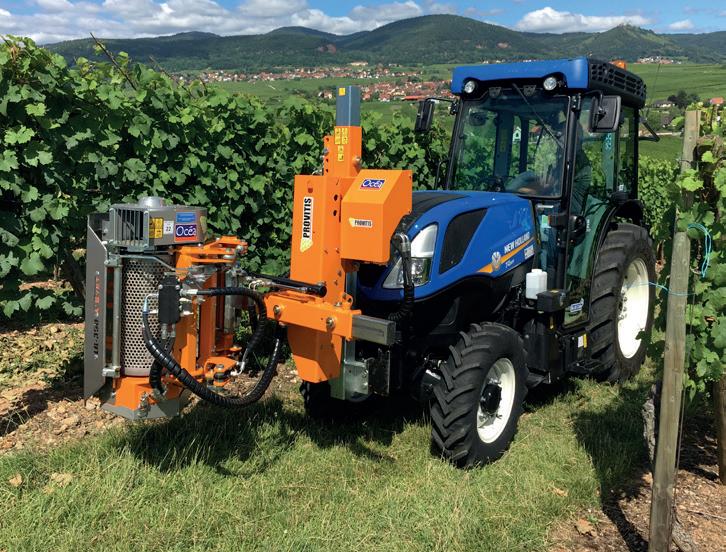





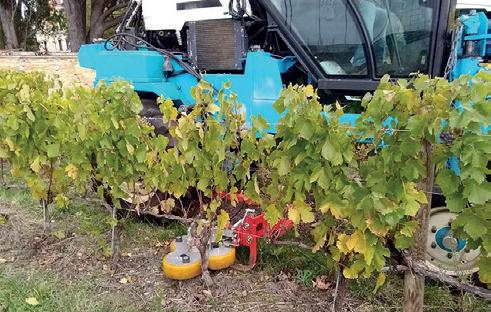
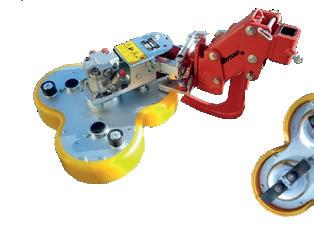

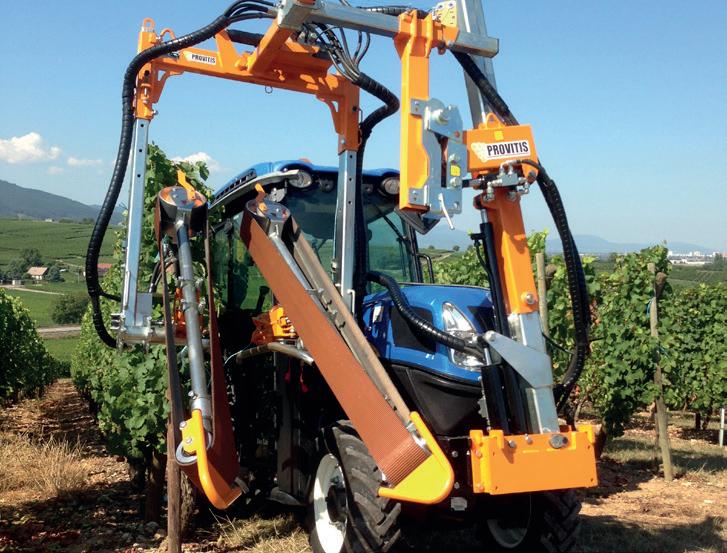

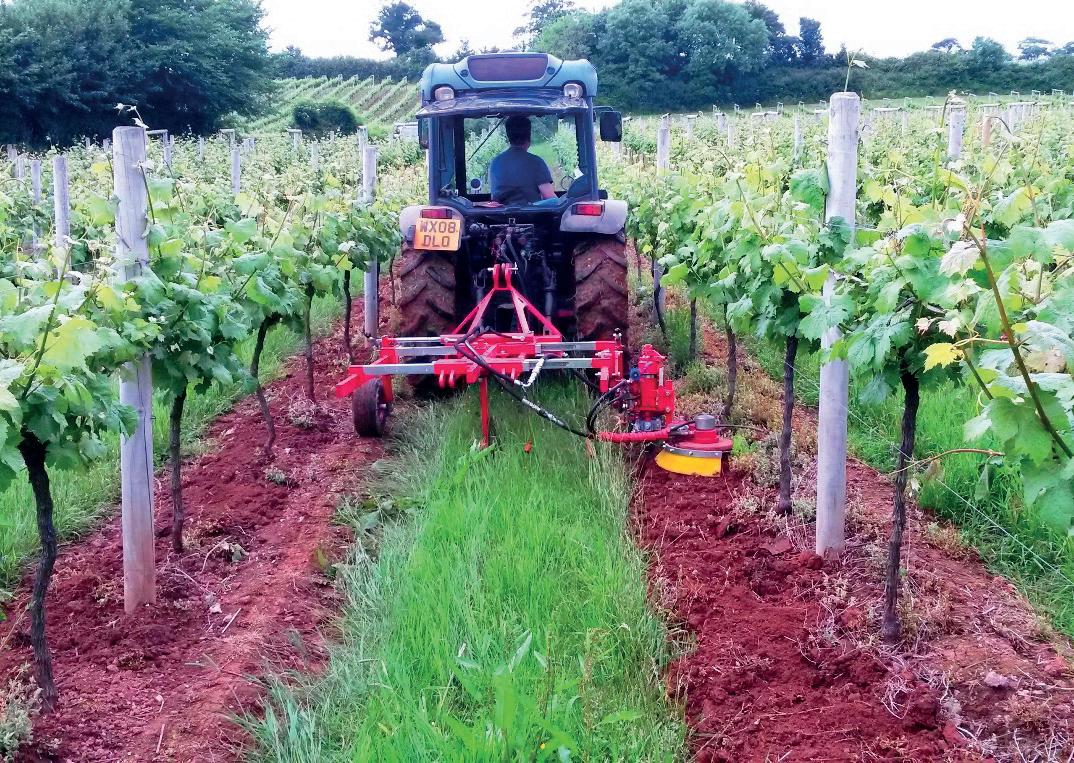
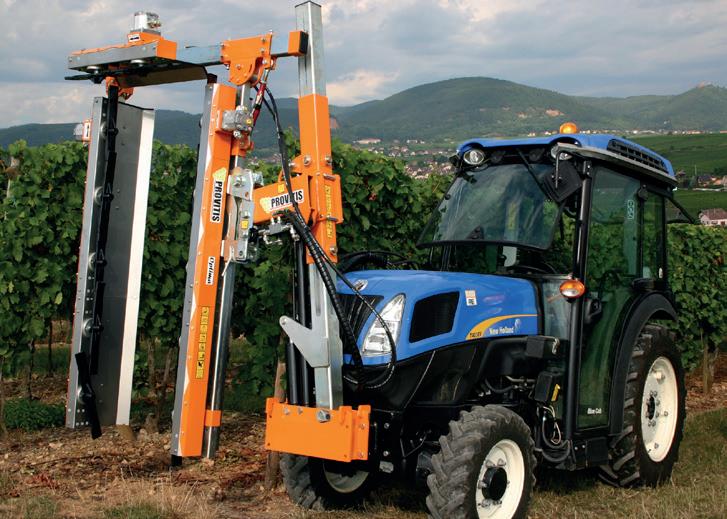
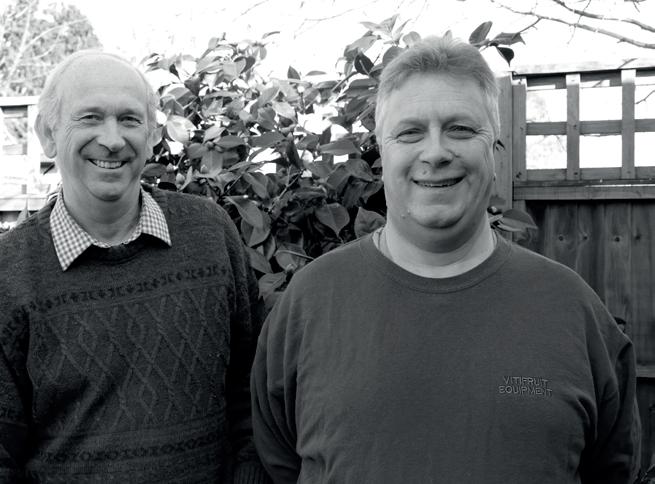
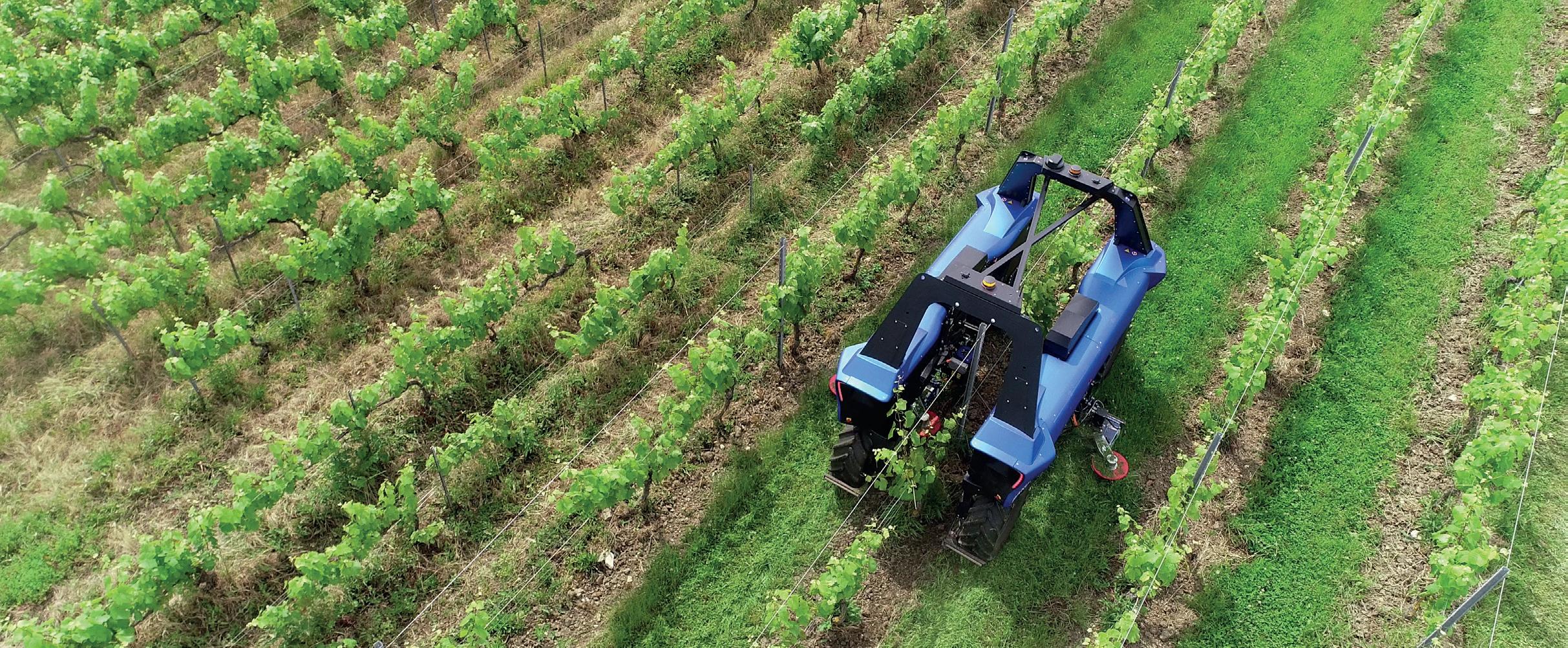
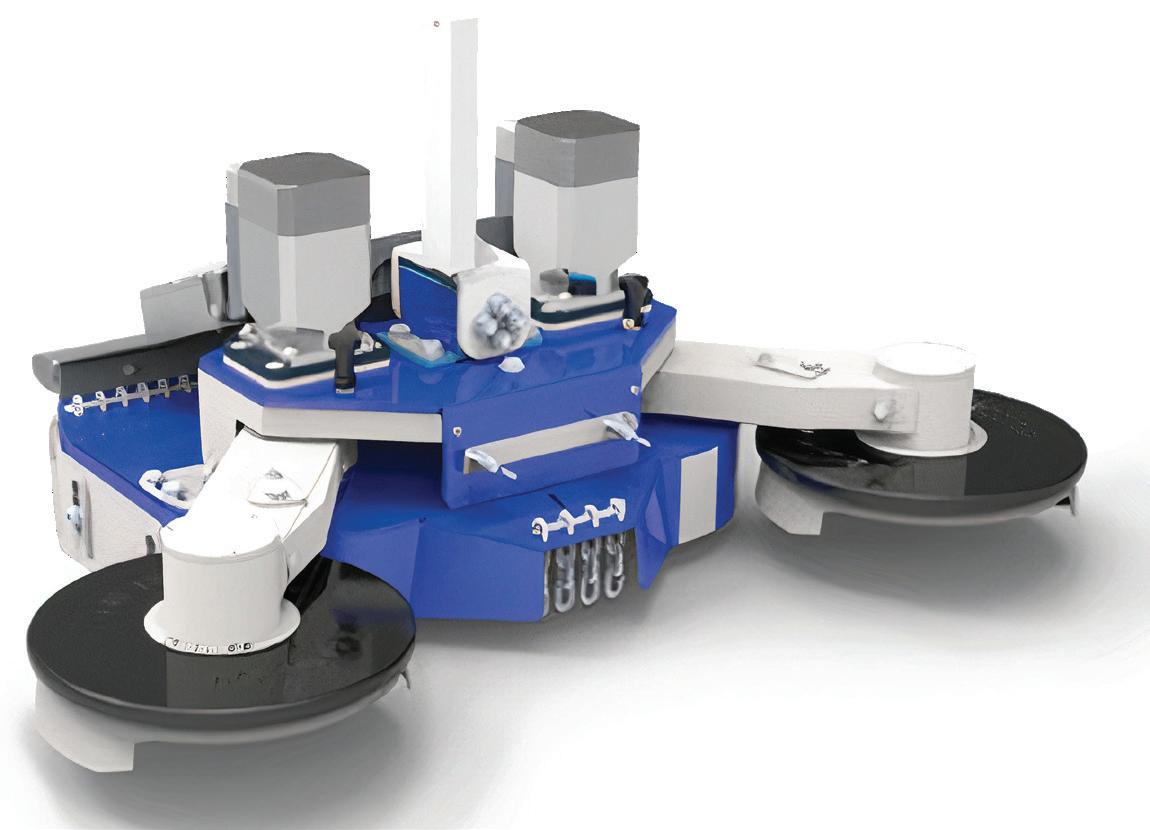
Alongside the already available multitude of inter vine weeding tools, some of which are already in use in an organic vineyard in Kent, Vitifruit Equipment can now offer the following new tools.
An over the row “U” shape Vine Trimmer developed in conjunction with Provitis with electric motors, and a newly designed modular mounting system. Orders are now being taken with the first customer machines due to be delivered in mid-May.
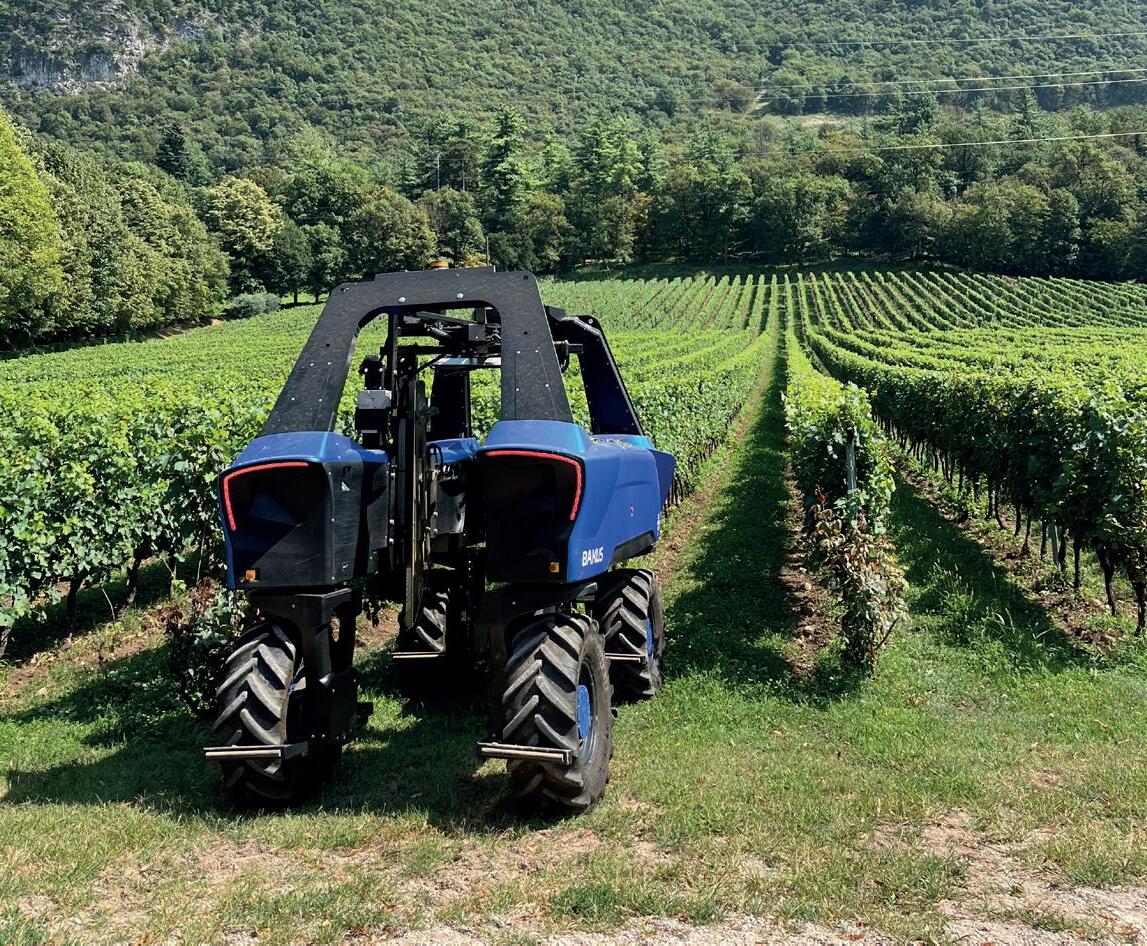
With increasing pressure to find competent and reliable tractor drivers, rising labour costs and the need for sustainability, Vitibot have been busy developing new tools for their Bakus robot.
An Inter-vine Mower developed in conjunction with Boisselet converted to run with the Vitibot brushless electric motors. It has a 40cm diameter cutting head and will be available mid-April.
A robust 50cm flail mower will be available from late April, this can run independently or be paired with an Inter-vine Mower, allowing maintenance of the grass alleyway as well as weeding under the row, all in a single pass.
A Satellite mower has also been added to the list of tools available. With two cutting heads at the front and two satellite cutting heads at the rear that orbit the main body, this allows an adjustable cutting width from 72cm to 115cm. Available early April.
Later this year we expect to hear more on the development of a sprayer and leaf stripper, these tools will share the modular mounting system as used on the vine trimmer.
VitiBot’s concept is to automate as many activities as possible with smart tools that are simple to use and maintenance free. The Bakus Robot is fitted with the latest Global Positioning System technology providing centimeter accuracy. However, VitiBot have still managed to make the Bakus Robot extremely easy to use and control from a mobile phone, the controls are well-presented and intuitive allowing an unskilled operator to oversee multiple machines and still perform their own separate activities for the day.
www.vitibot.fr
Optimised for vine and fruit growers
Precision spreading for healthier crops
Expert support and servicing from Crawfords Group
Contact Crawfords Group today to find the perfect ID-David solution for your farm!
Boost your vineyard and orchard yields with ID-David’s precision spreading and fertilisation machines, now available at Crawfords Group. Designed for even nutrient distribution, these machines enhance crop health and productivity while reducing waste. crawfordsgroup.co.uk

